
Бесплатный фрагмент - Самоучитель английского языка для менеджеров фармбизнеса
PharmEnglish for pharm career
Предисловие
Предлагаемое Вашему вниманию учебное пособие «Pharm–English» подготовлено дипломированным специалистом по английскому языку, имеющим многолетний практический опыт работы в зарубежных фармацевтических компаниях.
Данное специализированное пособие предназначено для менеджеров отделов продаж и маркетинга фармацевтических компаний, которым приходится взаимодействовать с англоязычными сотрудниками в ходе своей повседневной деятельности: бизнес-ревью, тренингов, презентаций, вебинаров и т. д. Пособие рассчитано на обучаемых, имеющих предварительные знания и навыки разговорной речи на уровне — не ниже Elementary.
Результатом прохождения данного специализированного курса является:
• ведение менеджерами бесед (диалогов) с англоязычными сотрудниками по изученным темам;
• общее понимание менеджерами англоязычных сотрудников по изученным темам;
• проведение менеджерами заранее подготовленных презентаций и выступлений перед англоязычными сотрудниками по отработанным темам.
Основное внимание в данном курсе уделяется отработке специализированной профессиональной лексике фармбизнеса. В то же время каждая лексическая тема дополняется одной из грамматических тем в интересах повторения и систематизации материала для обучаемых. При этом лексические и грамматические темы не связаны друг с другом напрямую.
Учебный курс включает в себя десять (10) учебных тем, каждая из которых посвящается одному из направлений деятельности (функциональных обязанностей) менеджеров фармацевтической компании:
1. Медицинский представитель — основа эффективного бизнеса фармкомпании;
2. Структура и содержание эффективного визита медицинского представителя к врачу;
3. Определение менеджером стратегий работы на территории и постановка бизнес цели на основе анализа ее потенциала;
4. Корректировка менеджером поставленной бизнес-цели на основе SWOT- и PEST анализа, определение основных направлений действия для достижения бизнес цели;
5. Категоризация менеджером базы данных клиентов, определение целевой группы клиентов, основные количественные и качественные показатели работы территориальной команды;
6. Менеджер — важнейшее звено эффективной системы рекрутмента компании;
7. Развитие менеджером своей территориальной команды, полевой коучинг;
8. Структурированное интервью при собеседовании в фармкомпанию;
9. Подготовка и проведение групповой презентации для англоязычной аудитории;
10. Структура и содержание business review по продукту/территории.
Все новые слова в каждой теме приводятся в поурочном словаре, в порядке их появления в тексте. Каждая учебная тема дополняется аудиозаписями, позволяющими обучаемым самостоятельно отрабатывать текст и новые слова в разных форматах звучания (медленном и быстром в зависимости от учебных целей). Для получения аудиозаписей курса Вам необходимо отправить письменный запрос автору по электронному адресу, указанному на последней стр. книги.
Учебное пособие предполагает выполнение обучаемыми самостоятельной работы по каждой теме как в устной, так и в письменной форме. При этом рекомендуется:
• устные упражнения в учебнике выполнять со зрительной опорой на текст;
• устные упражнения на основе аудиозаписей (=аудирование) выполнять на слух (без опоры на текст);
• письменные задания после выполнения сверяются с «ключами» (=Модуль №7 в каждой теме), и правильный вариант обязательно устно проговаривается вслух. Для желающих выполнять письменные упражнения в электронной форме, автор по письменному запросу (электронный адрес указан на последней стр. книги) может выслать Рабочую тетрадь в электронной форме, что реально позволит сократить время выполнения письменных заданий.
Для качественной отработки любой учебной темы рекомендуется придерживаться предлагаемого в нем общего порядка прохождения материала:
1) выучить новые слова, прослушать и перевести текст с английского языка на русский, а также самостоятельно изучить новую грамматику;
2) самостоятельно отрабатывает контрольное чтение текса, а также все учебные задания;
3) наизусть выучить текст по теме и подготовить на его основе диалоги по изучаемой теме;
4) выполнить КОНТРОЛЬНУЮ РАБОТУ по изучаемой теме.
Структурно каждая тема САМОУЧИТЕЛЯ состоит из следующих учебных модулей:
Модуль №1: Грамматика;
Модуль №2: Текст по теме;
Модуль №3: Слова по теме;
Модуль №4: Учебные задания (работа над текстом и грамматикой);
Модуль №5: Разговорная лексика;
Модуль №6: Контрольная работа по теме;
Модуль №7: «Ключи» для проверки письменных заданий и контрольной работы.
Успешное освоение данного специализированного курса и достижение заявленных в нем целей возможно лишь при условии выполнения обучаемыми следующих ключевых методических установок автора:
1. Каждое новое слово/словосочетание по учебной теме должно быть выписано на двустороннюю карточку и выучено в ходе самостоятельной работы. Заучивание может быть основано как на просмотре карточек, так и на слух — с опорой на аудиозапись новых слов. Также рекомендуется обязательно использовать для работы с новыми словами программу Quizlet/PharmEnglish (пароль для работы с программой следует письменно запросить у автора по указанному на последней стр. книги);
2. Все аудиозаписи текстов в ходе самостоятельной работы должны быть прослушаны/повторены обучаемым вслед за аудиозаписью не менее 3—4 раз;
3. На самостоятельную работу (=выполнение всех видов домашнего задания) по каждой теме обучаемым должно быть в общем затрачено не менее 24 учебных часов (= около 3-х полных рабочих дней);
4. По завершению изучения каждой темы обучаемый должен уметь рассказывать наизусть рекомендованный для заучивания минимум из содержания текста (выделен жирным шрифтом в Учебном модуле №7).
Желаю Вам успехов в изучении английского языка!
С уважением,
Андрей Бычков, к.ф.н.
Тема №1: Медицинский представитель — основа эффективного бизнеса фармкомпании
Учебный модуль №1. Грамматика:
Глаголы состояния и действия, группы времен в английском языке
В английском языке выбор глагола и его временной формы играет особое значение, поскольку именно в нем скрывается понимание сути и характера происходящих событий. Перефразируя на английский манер известное французское выражение «шерше ля фам» — ищите женщину, можно уверенно сформулировать следующее важное правило: Ищите глагол в предложении, и он позволит Вам понять смысл предложения.
Все глаголы в английском языке следует разделить на две большие группы: глаголы, передающие состояние и глаголы, передающие действие.
Под состоянием понимается характеристика какого–либо одушевленного субъекта или неодушевленного предмета, в котором они пребывают. Например, Он устал. Она — красива. Они — серьезны.
В отличие от состояния, действие обозначает любое активное движение, совершаемое одушевленным субъектом или неодушевленным объектом. Например: Он проводит визит. Она работает. Презентация проходила интересно.
Для обозначения СОСТОЯНИЯ используется грамматическая конструкция, состоящая из двух частей:
• глагол -to be (=быть), который будет иметь соответствующее спряжение в зависимости от необходимого по смыслу времени, а также лица и числа;
• составная часть сказуемого передающая смысл состояния, которая очень часто совпадает с формой прилагательного. Например, sleepy (сонный), hungry (голодный), funny (смешной), busy (занятой), serious (серьезный).
В таблице ниже приводятся различные формы глагола to be (в настоящем и прошедшем времени) для разных местоимений:
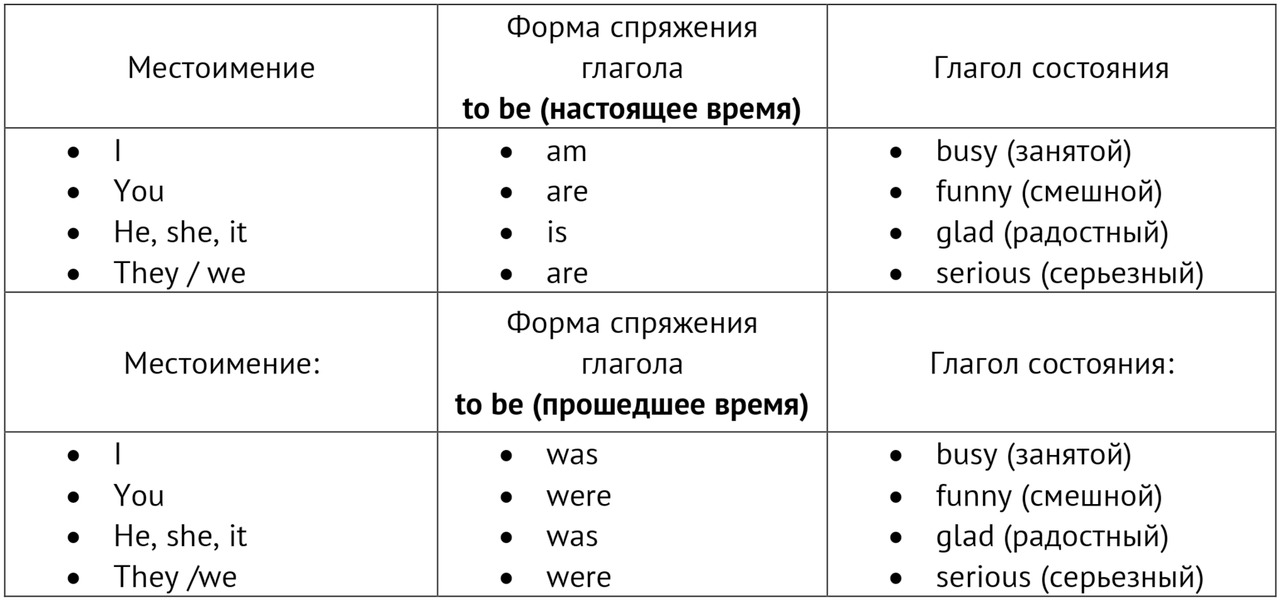
Для обозначения глаголов ДЕЙСТВИЯ используется только смысловой глагол (без частицы to), например: work, play, make в соответствующем времени, лице и числе.
Например: I work (я работаю). She plays (Она играет). They study (они учатся).
Поскольку глагол, сказуемое английского предложения является «королем» грамматики этого языка, то нам сразу необходимо уяснить и запомнить понятие «форма глагола». Для начала познакомьтесь с двумя более простыми формами:
• Неопределенная форма глагола: смысловой глагол с частицей -to. Эта форма совпадает с неопределенной формой глагола в руссом языке, например, читать, писать, работать.
• Первая форма глагола: смысловой глагол без частицы -to. Данная форма представляет собой один из грамматических кирпичиков английского языка, из которых выстраиваются «стены» различных временных форм.
С другими формами, в которые «одевается», его величество — английский глагол, мы с Вами познакомится дальше.
Понятие «времени» в английском языке
Англичане в отличие от русских совсем по-другому воспринимают время. Поэтому в английском языке при образовании предложения и выборе временной формы глагола внимание обращается не только на само время совершения действия, как у русских: настоящее, прошедшее и будущее, но, и на то, как это действие протекает. При этом, с английской точки зрения, возможны три основных варианта действия, в зависимости от которых будет выбрана та или иная временная форма глагола:
• действие совершается регулярно;
• действие совершается строго в определенный момент времени;
• действие уже закончилось к определенному моменту времени (и имеется/подразумевается его результат).
Вот почему англичане не могут, как русские, обойтись тремя простыми временами (настоящее, прошедшее и будущее), а им требуются, так называемые, группы времен. Они называются группами времен потому, что в каждой из них есть свое настоящее, прошедшее и будущее время.
Итак, для того, чтобы построить любое предложение в английском языке, в отличие от русского, необходимо определить:
1. Как совершается действие (регулярно, в определенное время, действие — завершено) для выбора правильной группы времен.
2. В какое время совершается действие, чтобы выбрать правильное время в рамках данной группы времен (настоящее, прошедшее или будущее).
Кажется, очень сложным? На первый взгляд, да. Давайте попробуем вникнуть в особенности представления англичан о прошедшем, настоящем и будущем времени.
Группы времен в английском языке
На начальном этапе изучения курса мы будем исходить из того, что при оценке характера самого действия англичане выделяют три возможных варианта:
• Действие происходит во времени регулярно, постоянно (за описание такого действия отвечает группа времен Indefinite или неопределенное);
• Действие происходит с привязкой к строго определенному времени или другому действию (за описание такого действия отвечает группа времен Continues или продолженное);
• Действие к моменту разговора о нем уже завершилось с определенным результатом (за описание такого действия отвечает группа времен Perfect или свершенное).
Давайте рассмотрим несколько примеров с конкретными лексическими индикаторами, которые с высокой долей вероятности, будут указывать на свои группы времен.
В рамках каждой из групп времен Indefinite, Continues, Perfect есть свое настоящее, прошедшее и будущее время. Таким образом, для обозначения времени действия в английском предложении в отличие от трех русских времен (настоящее прошедшее и будущее) используется девять времен:

В образовании различных предложений (повествовательные, вопросительные и отрицательные) для разных групп времен используются различные грамматические конструкции, включающие в себя:
• вспомогательные глаголы;
• различные формы смыслового глагола.
Давайте разберемся в грамматических особенностях построения различных групп времен. Прежде, чем мы этим займемся, необходимо развести между собой два понятия в английском языке:
• смысловой глагол — это глагол, передающий определенное состояние или действие и выступающий в английском предложении в роли сказуемого. Например: читать, учиться, радоваться, быть занятым и т.д.;
• вспомогательный глагол — в отличие от смыслового является исключительно грамматическим материалом, не имеет самостоятельного смыслового наполнения и предназначен только для обозначения определенной группы времен и конкретного времени в этой группе. То есть эта необычная для русского языка категория — вспомогательный глагол — позволяет определять и передавать именно характер происходящих действий: неопределенность, продолженность и завершенность. К сожалению, у англичан не нашлось фантазии :), и они не сумели делегировать на роль вспомогательных каких-либо особенных по форме глаголов, чтобы обозначить различие со смысловыми глаголами. Поэтому вспомогательные глаголы в английском языке по своему внешнему виду совпадают с тремя смысловыми глаголами такими, как -to have (иметь) и -to be (быть) и -to do (делать). Но с этим печальным фактом, нам, похоже, придется смириться!
Еще одной сложностью английского языка является наличие у глаголов 3-х форм:
• 1-ая форма глагола = инфинитив (неопределенная форма без частички –to);
• 2-ая форма глагола = окончание –ed +1-ая форма глагола (для правильных глаголов) и своя форма глагола (для неправильных глаголов);
• 3-ая форма глагола = окончание –ed +1-ая форма глагола (для правильных глаголов) и своя форма глагола (для неправильных глаголов);
Следует отметить, что три формы неправильных глаголов в англ. языке не поддаются логическому осмыслению и поэтому должны заучиваться наизусть. Список основных неправильных глаголов находится в Приложении №1 к данному учебному пособию.
Примеры действий, передаваемых группой времен Indefinite:
• Я работаю в фармацевтической компании (вообще) — настоящее время группы времен Indefinite;
• В прошлом году он сделал более 30 презентаций в медицинских учреждениях (нет точного времени — в течение года) — прошедшее время группы времен Indefinite;
• Завтра мы посетим больницу №10 (нет указания на точное время — в течение дня) — будущее время группы времен Indefinite.
Лексическими индикаторами группы времен Indefinite являются следующие обстоятельства времени:
• всегда (always);
• обычно (usually);
• сегодня (today);
• завтра, завтра утром (tomorrow, tomorrow morning);
• вчера, вчера вечером (yesterday, yesterday evening);
• на прошлой неделе, в прошлом году, в 1997 году (last week, last year, in 2020);
• часто (often);
• редко (seldom);
• каждый (день, среду, неделю, год) — every day, every Wednesday, every week, every year;
• сначала… потом… после того, как (описание последовательности действий) — first …then… after that.
Вспомогательными глаголами для группы времен Indefinite являются:
• для настоящего времени: -do (для подлежащих во всех лица и числах кроме третьего лица, ед. числа), does (только для подлежащего в третьем лице, ед. числа);
• для прошедшего времени: — did (для подлежащих во всех лицах и числах);
• для будущего времени: will (для подлежащих во всех лицах и числах);
Схемы образование повествовательных предложений в группе времен Indefinite приводится в таблице ниже:
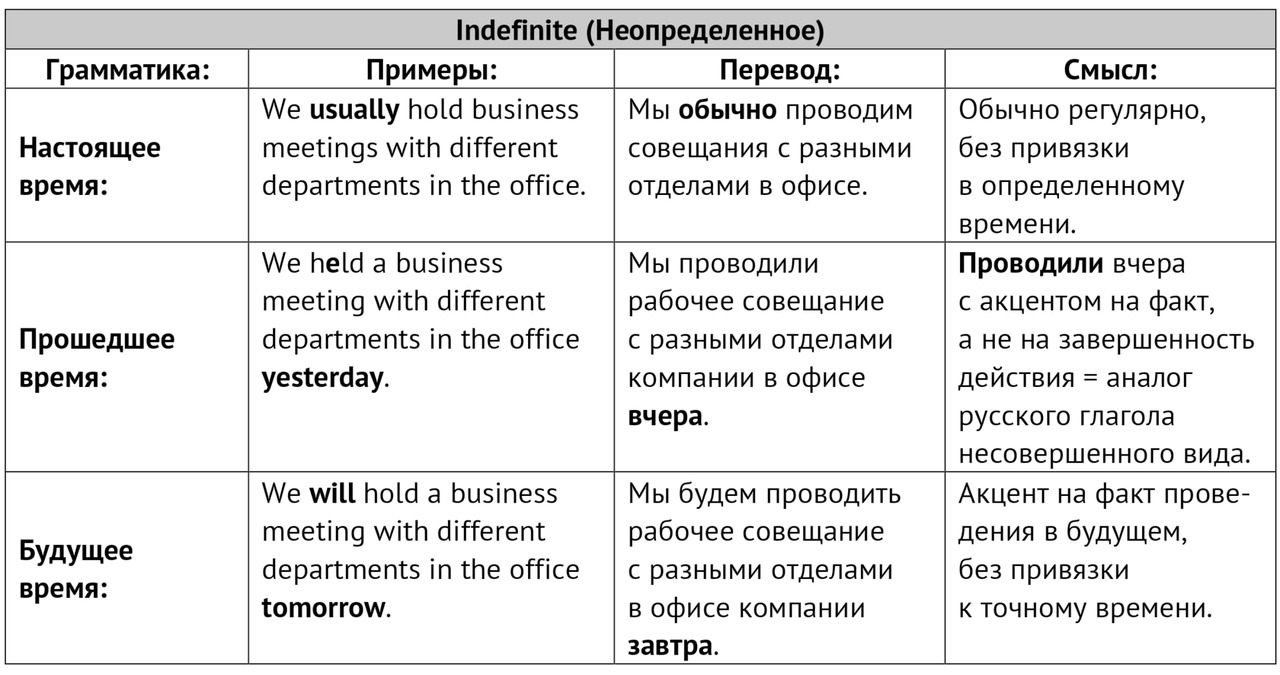
Примеры действий, передаваемых группой времен Continues:
• Я пишу отчет о визите (подразумевается сейчас). — настоящее время группы времен Continues;
• Вчера в это время я встречался с профессором Ивановым. — прошедшее время группы времен Continues;
• Завтра в девять часов утра мы будем совершать визит в поликлинику №10. — будущее время группы времен Continues.
Лексическими индикаторами группы времен Continues являются следующие обстоятельства времени:
• сейчас (now);
• с 3-х до 5-ти часов (from 3 o’clock till 5 o’clock);
• в это время вчера (завтра) — at this time yesterday/tomorrow;
• когда ты пришел… (when you came);
• в это время (at this time).
Вспомогательными глаголами для группы времен Continues являются:
• для настоящего времени: -be (спрягается для различных лиц и чисел — см. таблицу ниже);

• для прошедшего времени: — was (для подлежащих в единственном числе) и –were (для подлежащих во множественном числе);
• для будущего времени: will + be (для подлежащих во всех лицах и числах).
Схемы образование повествовательных предложений в группе времен Continues приводится в таблице ниже:
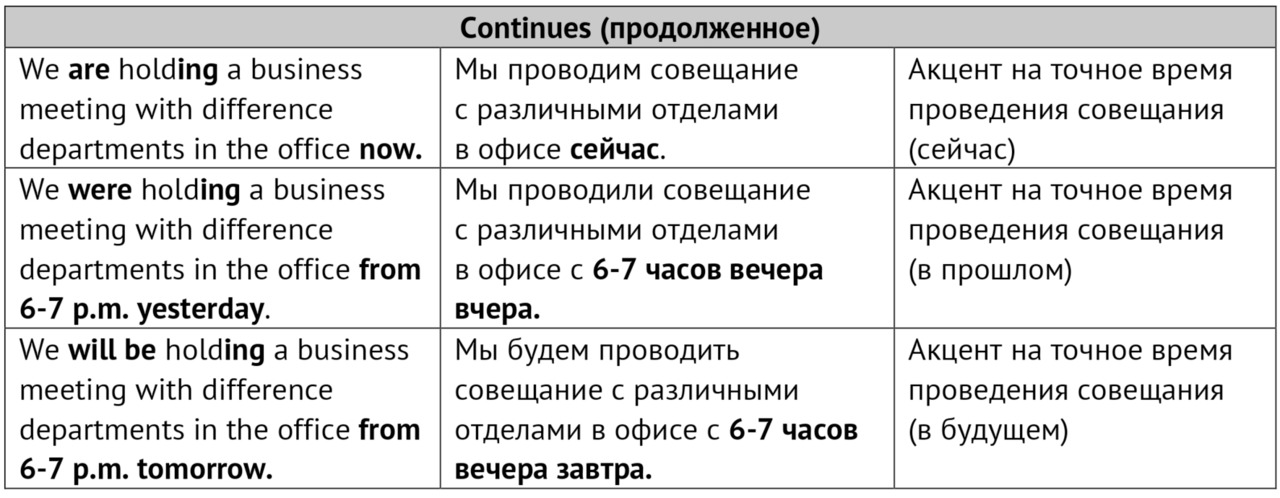
Примеры действий, передаваемых группой времен Perfect:
• Я уже совершил визиты к врачам в этом кардиологическом центре. (Результат: могу ехать в другое медицинское учреждение) — настоящее время группы времен Perfect;
• Вчера к 3 часам они уже вернулись из поликлиники. (Результат: могли принять участие во вчерашнем совещании) — прошедшее время группы времен Perfect;
• Когда Вы мне позвоните завтра, я уже сделаю презентацию в больнице. (Результат: я буду свободен и, мы сможем обсудить этот вопрос) — будущее время группы времен Perfect.
Лексические индикаторы группы времен Perfect помимо передаваемого смысла законченности, завершенности действия являются следующие обстоятельства времени:
• уже (завершилось) already;
• еще не (закончилось) yet;
• к двум часам завтра (будет готово что-то) by two o’clock;
• вчера к этому времени (завершилось что-то) by this time yesterday;
• только что (сделал что-то) — just.
Вспомогательными глаголами для группы времен Perfect являются:
• для настоящего времени: -have (для подлежащих во всех лица и числах кроме третьего лица, ед. числа), has (только для подлежащего в третьем лице, ед. числа);
• для прошедшего времени: — had (для подлежащих во всех лицах и числах);
• для будущего времени: will have (для подлежащих во всех лицах и числах);
Схемы образование повествовательных предложений в группе времен Perfect приводится в таблице ниже:
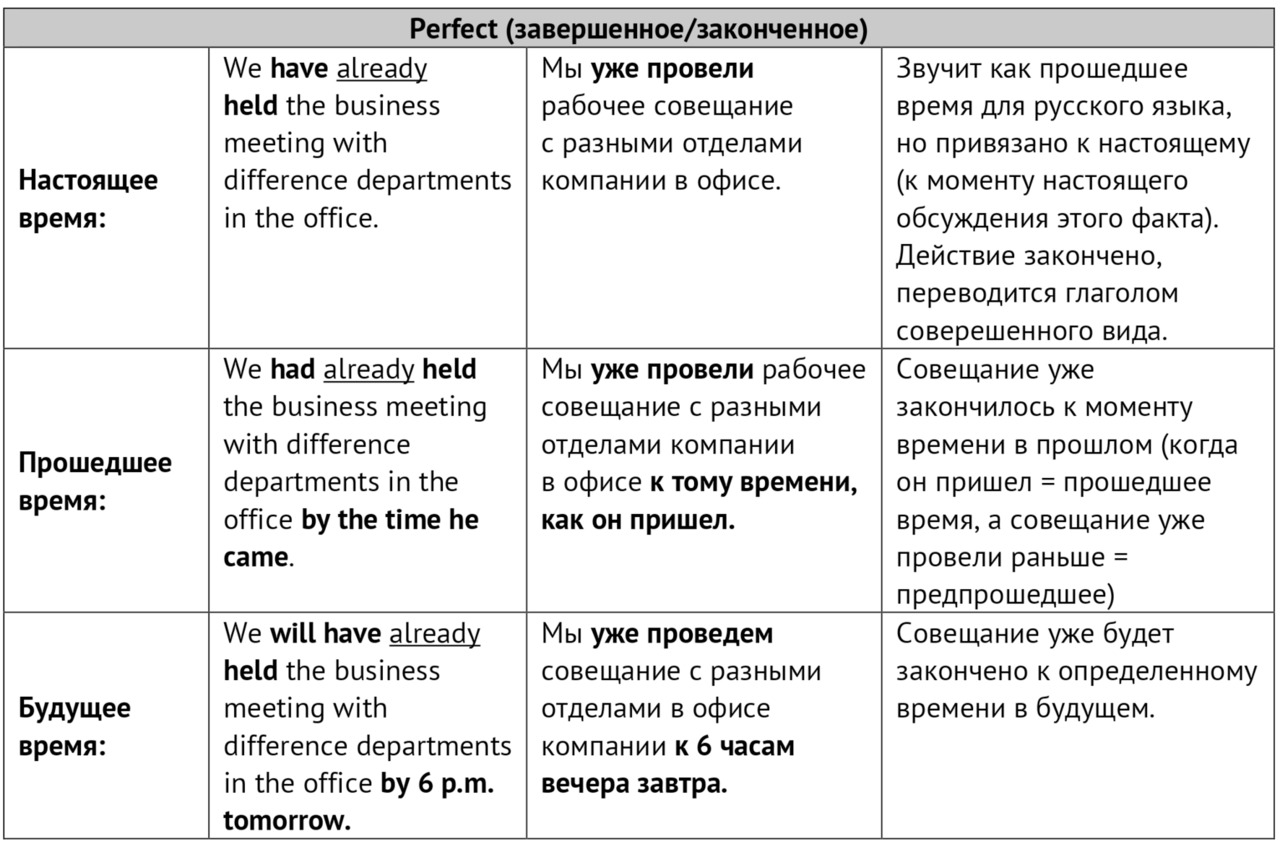
Учебный модуль №2. Текст:
Andrei Teetov is a Medical Representative
Andrei Teetov is a young man of 29 years old. He has a medical background and several years ago worked as cardiologist in a city policlinic. But in 2020 he decided to start a new career and joined one of the international well-respected pharmaceutical companies as a professional Medical Representative. He likes his new job. Besides decent salary it enables him to bring up-to-date treatment to the healthcare workers, establish and develop strong business and friendly relations with many interesting people. He is also proud of his occupation. Medical or Sales Representatives are the company’s bottom line. They do not only sell products they shape the doctors’ prescribing habits and what is most important represent the company.
His company produces and promotes a wide range of both ethical pharmaceutical products covering a variety of therapeutic areas and self-medication medicines. The company has a big portfolio of products and has a strong commitment to research and development of products in many areas.
The company is especially well known in the field of asthma and cardiology treatments and has recently launched a new treatment for hypertension.
This new product, Cardiolin, is a second-generation ACE inhibitor which offers significant benefits over existing products in this therapy class.
Andrey Teetov is responsible for a wide territory of the city that contains more than 30 policlinics, 5 hospitals and about 50 pharmacies. Andrey’s objectives are very challenging. By the end of the year he must make about 2,000 face to face visits to physicians and pharmacies and some 50 group presentations. His target group consists of cardiologists and general practitioners with high prescribing potential. Andrey must cover 50% of general practitioners and 100% of all specialists and ensure the frequency of 6 calls to each cardiologist by the end of this year. When Andrey meets specialists he has to detail Cardiolin in 100% of calls.
In order to meet these objectives the company provided Andrey with Scoda Filicia car to help him make not less than 10 calls every day. But the car itself is just a tool not a guaranty of success so Andrey has to plan carefully to reach his targets. It means that he should do his best to decrease the number of Administrative and Office days and increase Selling days in the field. He is also equipped with a mobile phone and an overhead projector for group presentations.
At the moment Andrey is preparing for a follow-up call on one of his target cardiologists —
Dr. Ivanov. Andrey has already met Dr. Ivanov several times before and on the last occasion he introduced Cardiolin to him and explained some of the benefits of this new therapy.
As a result of the next call Andrey will try to convince Dr. Ivanov to prescribe Cardiolin to some of his patients who visit him for the first time with hypertension. He will also attempt to persuade Dr. Ivanov to prescribe Cardiolin to some of his patients who cannot tolerate the side-effects of their current therapies.
Учебный модуль №3. Новые слова
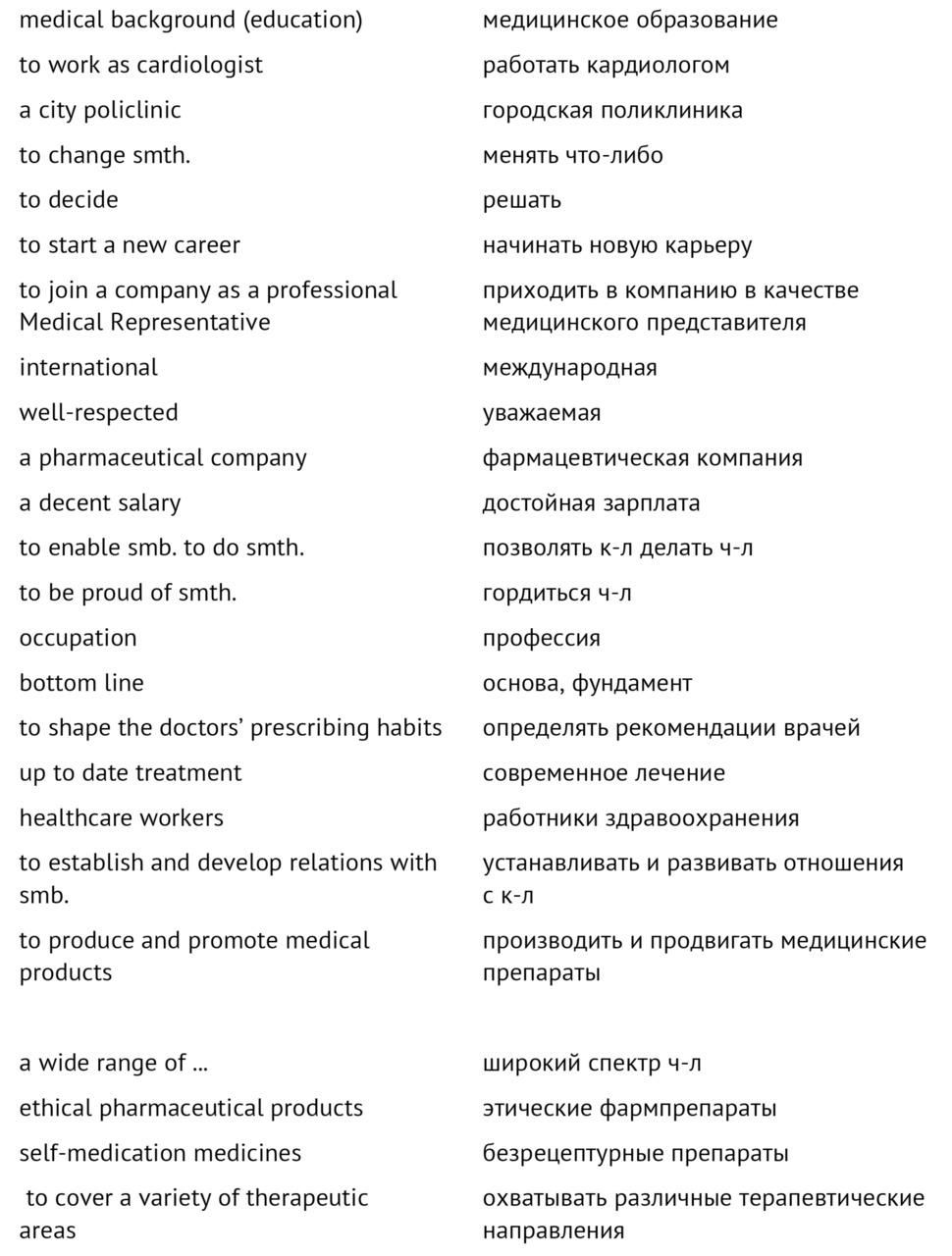
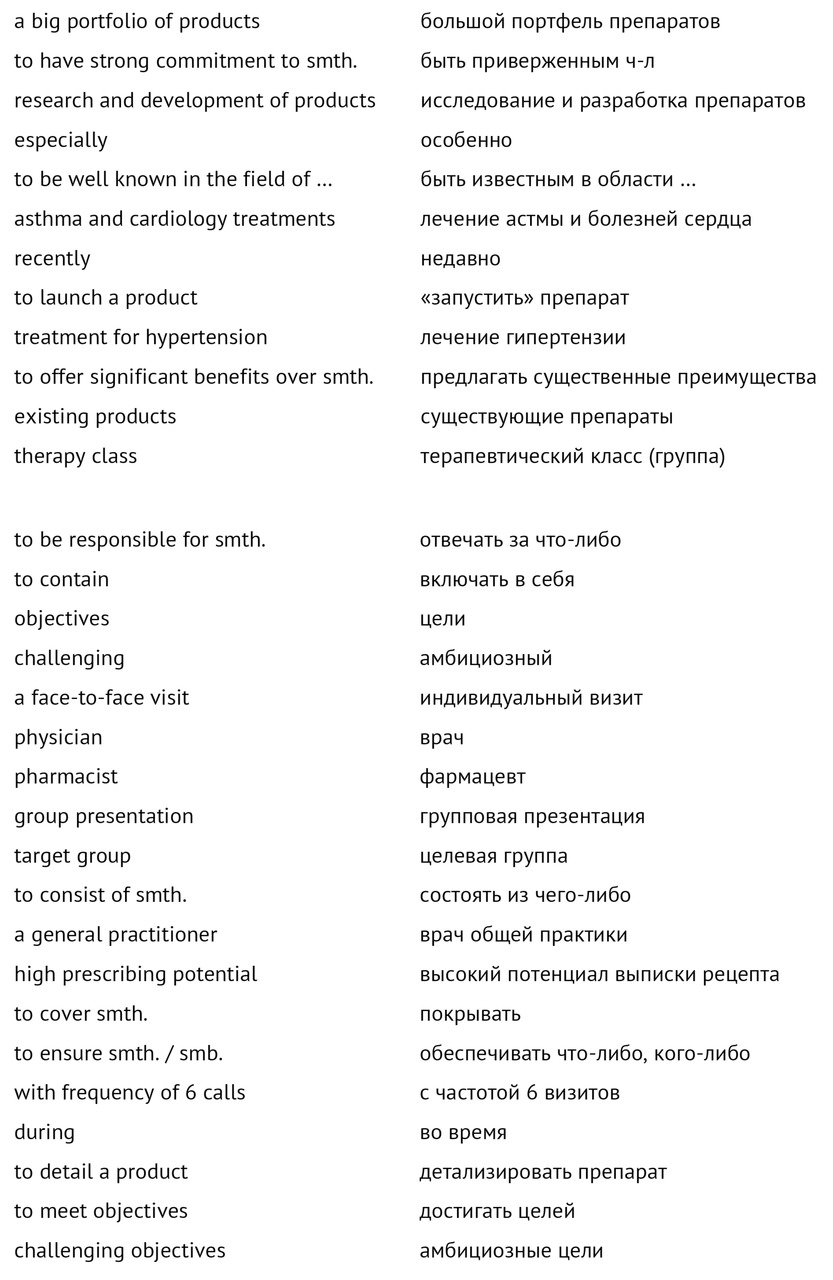
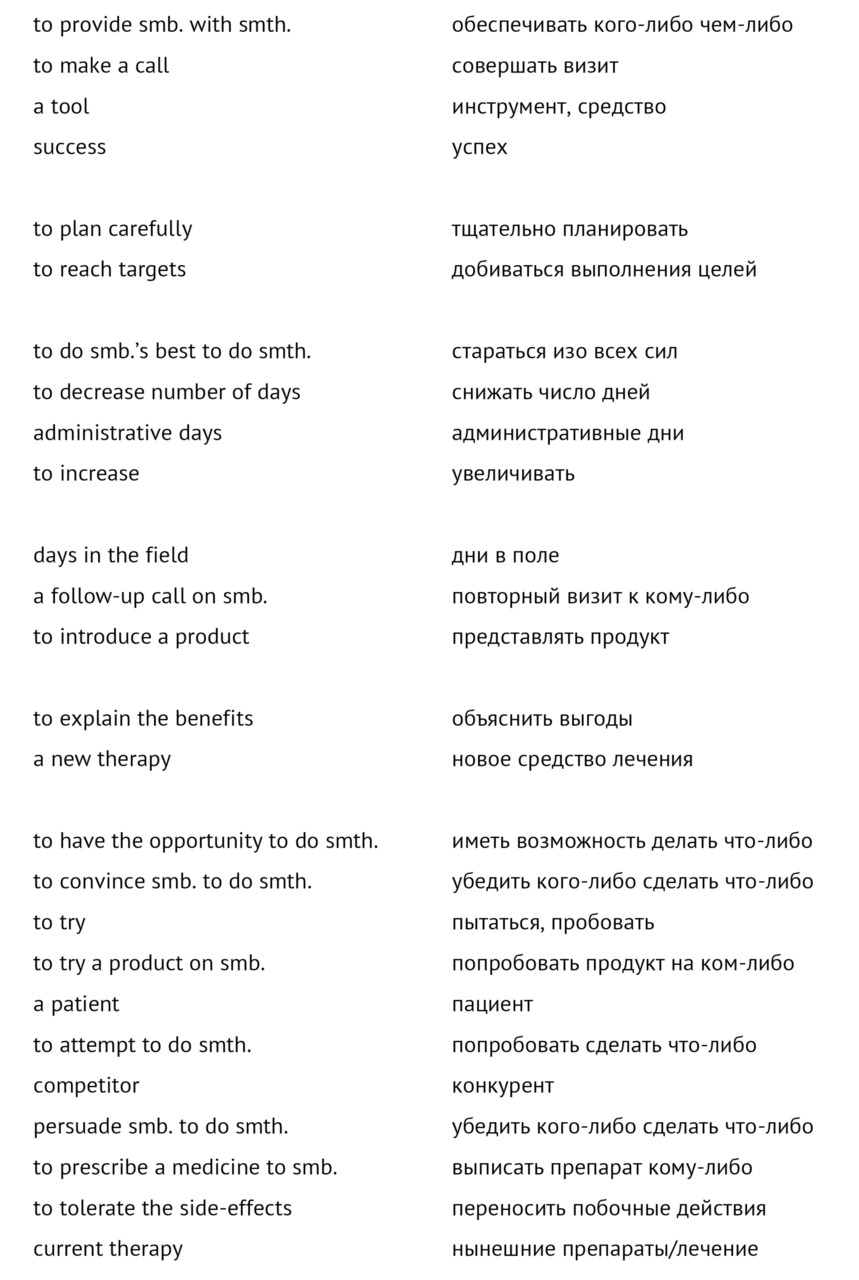
Учебный модуль №4.
Работа над текстом и грамматикой
Задание №1: Выучите наизусть формы спряжения глагола -to be в настоящем и прошедшем и будущем времени.
Задание №2: В приведенном ниже рассказе определите и письменно зафиксируйте принадлежность всех сказуемых к определенной группе времен и сверьте с правильным вариантом ответа Модуле №7.
• Группа времен Indefinite;
• Группа времен Continues;
• Группа времен Perfect.
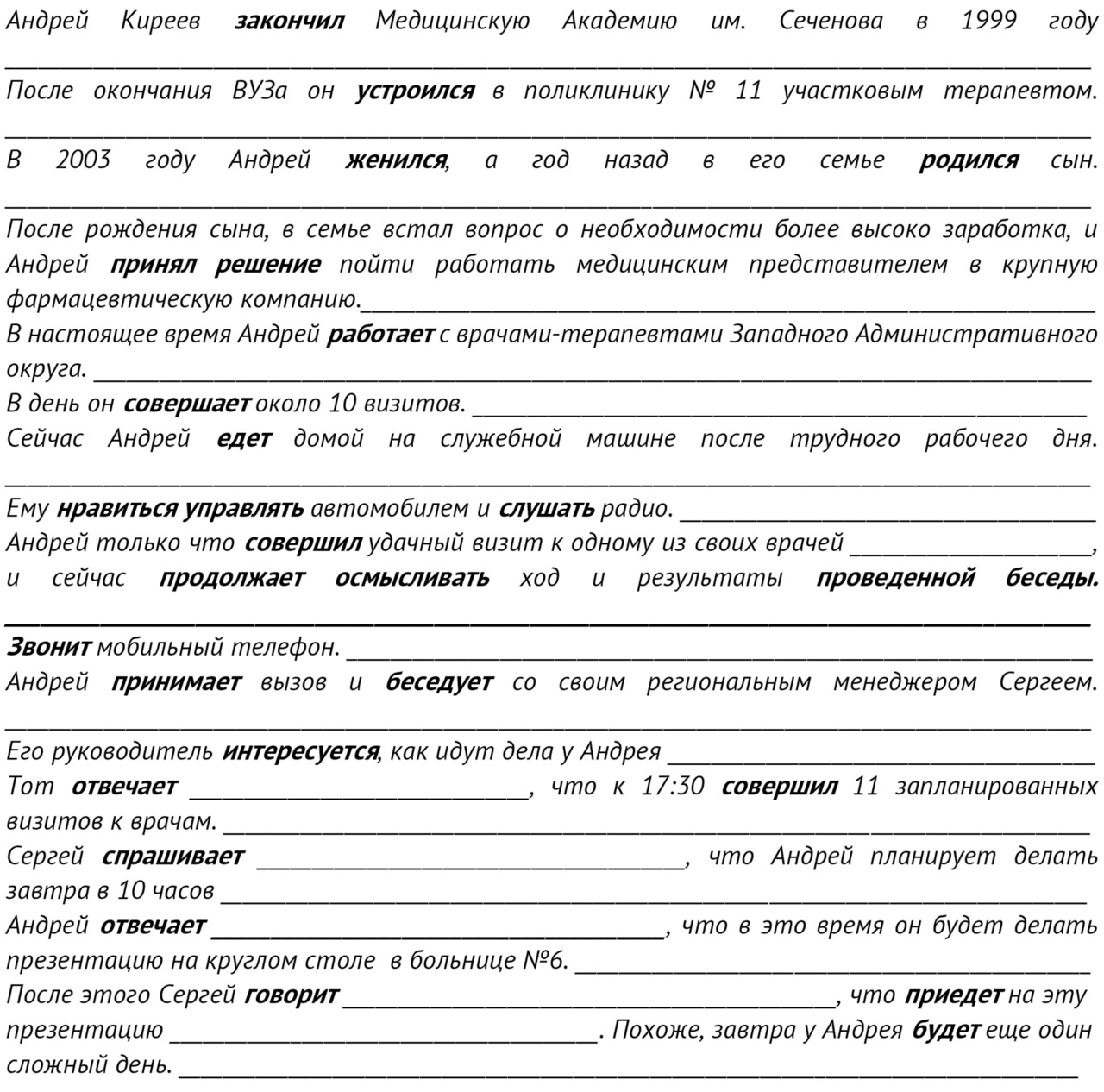
Задание №3: В приведенном ниже тексте определите и зафиксируйте письменно не только группу времен, но и время (настоящее — прошедшее — будущее) в рамках данной группы времен.
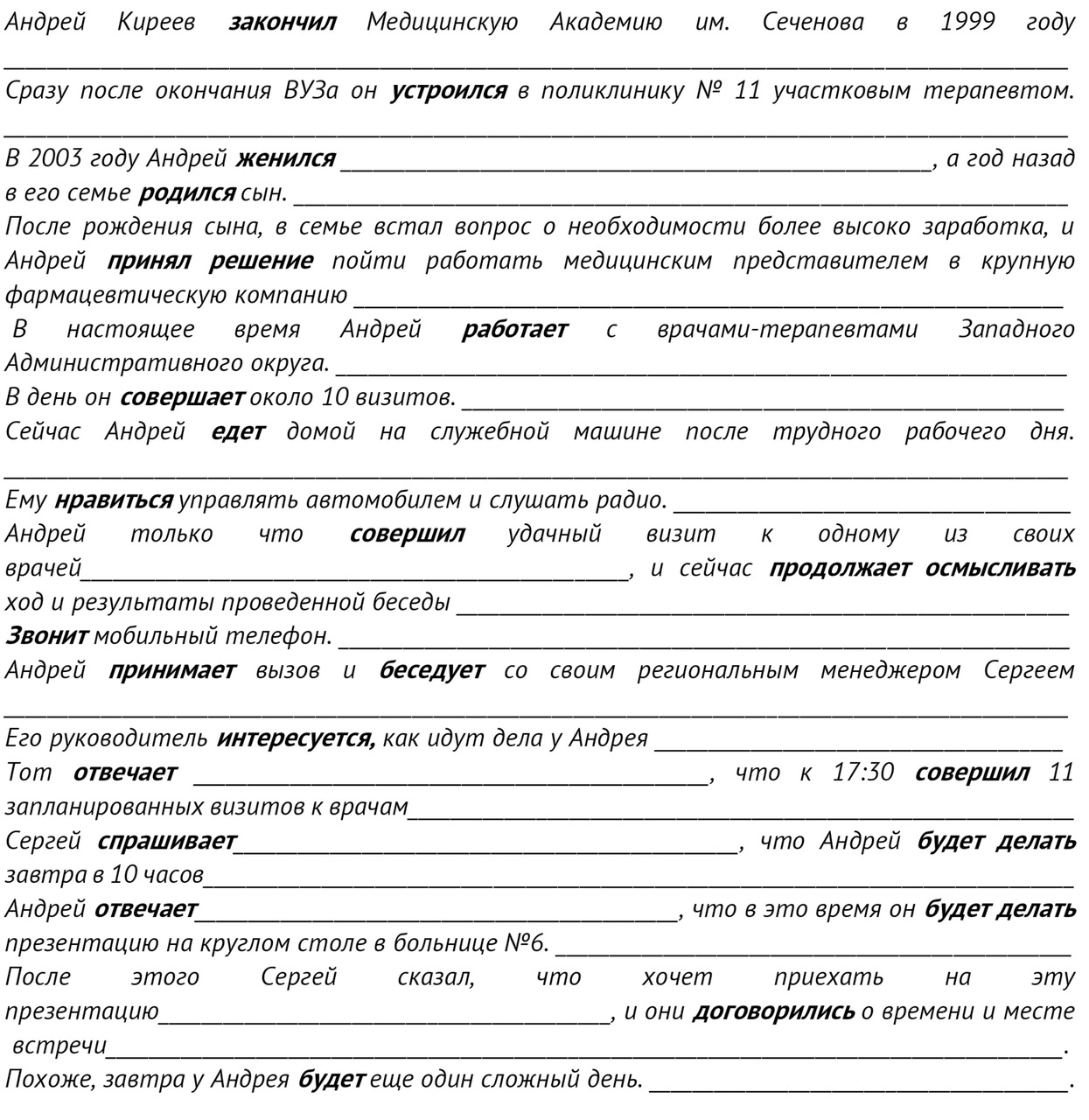
Задание №4: Прочитайте и переведите текст с опорой на аудиозапись.
Задание №5: Устно ответьте на следующие вопросы с опорой на текст:
1. What is Andrei Titov?
2. How did Andrey become a Medical Representative?
3. Why does he like his new job?
4. Why is Andrey so proud of his occupation?
5. What makes his company so well known in the pharmaceutical market?
6. What kind of products is the company especially famous for?
7. What can you say about the new product that the company has recently launched?
8. What territory is Andrey Titov responsible for?
9. How many policlinics does his territory contain?
10. What objectives does Andrey have?
11. How many face visits to physicians must Andrey make by the end of the year?
12. What customers does his territory consist of?
13. What percentage of his target group must Andrey cover by the end of the year?
14. What frequency must Andrey ensure in his target group by the end of the year?
15. In what percentage of calls must Andrey detail his product?
16. What does Andrey do to increase his effectiveness?
17. What is Andrey equipped with to make group presentations?
18. What was the result of Andrey’s last call to Dr. Ivanov?
19. What will Andrey try to do with Dr. Ivanov during his next call?
20. What patients will Andrey focus on during his next call to Dr. Ivanov?
Задание №6: Устно завершите приведенные ниже фразы с опорой на текст:
1. Andrei has a medical background and…
2. He decided to start a new career and…
3. Besides decent salary the new job enables him…
4. Andrei is proud of his occupation because…
5. Medical or Sales Representatives do not just only sell company products they…
6. Andrei’s company produces and promotes…
7. The company has a strong commitment to…
8. The company is especially well known…
9. The company recently launched ….
10. This new product offers…
11. Andrey Titov is responsible for…
12. His territory contains…
13. By the end of the year he must make…
14. His target group consists of…
15. Andrey must cover 50%…
16. Andrey must ensure…
17. When Andrey meets specialists he has to…
18. In order to meet these objectives the company…
19. Andrey has to plan carefully to…
20. Andrey must do his best to…
21. At the moment Andrey is preparing for…
22. During his last call to Dr. Ivanov Andrey…
23. As a result of the next call Andrey will try…
24. Andrey will also convince Dr. Ivanov to…
Задание №7: Письменно ответьте на вопросы сначала в краткой, а затем и полной форме в соответствии с приведенными моделями.
А. Model: Will you stay in the polyclinic? Yes, I will.
B. Model: Will you stay in the polyclinic? Yes, I will stay in the polyclinic.
C. Model: Will you stay in the polyclinic? No, I shan’t (=shall not).
D. Model: Will you stay in the polyclinic? No, I shan’t (=shall not) stay in the polyclinic.
1. Are you a physician?
2. Were you in the pharmacy yesterday?
3. Will Dr. Frolov attend the conference?
4. Were you tired after so many calls?
5. Does Sergey cover such a big territory?
6. Has Michael achieved his monthly objectives?
7. Have you ever visited this medical centre before?
8. Did Рrofessor Reznikov take part in the discussion?
Задание №8: а) Письменно ответьте на следующие утверждения с использованием конструкции: I don’t think he did (was, will…):
1. Did Andrei like the last visit to Dr. Ivanova?
2. Will you take part in the next Area meeting?
3. Has he achieved his monthly targets?
4. Does he like his work as a Medical Representative?
5. Has Andrei ever worked as a doctor?
6. Is he happy with the results of his work?
7. Will they meet their objectives?
8. Will you go abroad for your Cycle Conference?
b) Письменно переведите предложения на английский язык, начиная с конструкции I don’t think…
1. Я думаю, что менеджеру не понравятся эти результаты.
2. Думаю, что он не совершит 10 визитов каждый день.
3. Думаю, что ему не нравится работать с опинион лидерами.
4. Думаю, что он не пройдет тест по знанию препарата (to pass a product test).
5. Думаю, что он не выполнит свой план (to fulfill a plan).
6. Думаю, что менеджер не откажется помочь ему (to refuse to do smth.).
7. Думаю, она не найдет эту поликлинику (to find smth.).
Учебный модуль №5.
Слова и выражения для диалогов по теме

Задание №9: Устно согласитесь с указанными ниже утверждениями на основе приведенных ранее разговорных вариантов ответа (каждый раз меняйте форму своего согласия):
Пример:
— Andrei Titov is a young man of 29 years old.
— Right you are.
1. He has a medical background.
2. Several years ago he worked as cardiologist in a city policlinic.
3. Then he decided to start a new career.
4. Andrei joined a pharmaceutical company as a professional Medical Representative.
5. He likes his new job.
6. His new job enables Andrei to bring up-to-date treatment.
7. Andrei is also proud of his occupation.
8. Medical or Sales Representatives are the company’s bottom line.
9. Medical Representatives sell the company products.
10. Medical Representatives shape the doctors’ prescribing habits.
11. Medical or Sales Representatives represent the company.
12. Andrei’s company is well known in the market.
13. His company produces and promotes a wide range of ethical pharmaceutical products.
14. The company portfolio covers a variety of therapeutic areas.
15. The company has a strong commitment to research and development of products in many areas.
16. Andrei’s company is especially well known in the field of asthma.
17. Her company is especially well known in cardiology treatment.
18. Our company has recently launched a new treatment for hypertension.
19. This product offers significant benefits over existing products in this therapy class.
Задание №10: Устно согласитесь с указанными ниже утверждениями на основе приведенных ранее разговорных вариантов (каждый раз меняйте форму своего согласия). Дополняйте свое согласие полным повтором фразы:
Пример:
— Andrei Titov is a young man of 29 years old.
— Right you are. Andrei Titov is a young man of 29 years old.
1. He has a medical background.
2. Several years ago he worked as cardiologist in a city policlinic.
3. But then he decided to start a new career.
4. Andrei joined a pharmaceutical company as a professional Medical Representative.
5. He likes his new job.
6. His new job enables Andrei to bring up-to-date treatment.
7. Andrei is also proud of his occupation.
8. Medical or Sales Representatives are the company’s bottom line.
9. Medical Representatives sell the company products.
10. Medical Representatives shape the doctors’ prescribing habits.
11. Medical or Sales Representatives represent the company.
12. Andrei’s company is well known in the market.
13. His company produces and promotes a wide range of ethical pharmaceutical products.
14. The company portfolio covers a variety of therapeutic areas.
15. The company has a strong commitment to research and development of products in many areas.
16. Andrei’s company is especially well known in the field of asthma.
17. Her company is especially well known in cardiology treatment.
18. Our company has recently launched a new treatment for hypertension.
19. This product offers significant benefits over existing products in this therapy class.
20. Andrey Teetov is responsible for a wide territory of the city.
21. His territory contains more than 30 policlinics, 5 hospitals and about 50 pharmacies.
22. Andrey’s objectives are very challenging.
23. By the end of the year Andrey must make about 2,000 face to face visits to physicians.
24. His target group consists of cardiologists and general practitioners.
25. Andrey’s target group has high prescribing potential.
26. Andrey must cover 50% of general practitioners and 100% of all his specialists.
27. Andrey must ensure the frequency of 6 calls to each cardiologist by the end of this year.
28. When Andrey meets specialists he has to detail Cardiolin in 100% of calls.
29. Andrey does his best to decrease the number of Administrative and Office days and increase Selling days in the field.
30. At the moment Andrey is preparing for a follow-up call to
Dr. Ivanov.
31. On his last call to Dr. Ivanov Andrey introduced Cardiolin.
32. On his last call to Dr. Ivanov Andrey explained some of the benefits of this new therapy.
33. As a result of the next call Andrey will try to convince Dr. Ivanov to prescribe Cardiolin.
34. Andrey will also attempt to persuade Dr. Ivanov to prescribe Cardiolin to some of his patients who cannot tolerate the side-effects of their current therapies.
Задание №11: С опорой на новые слова подготовьте и озвучьте краткий диалог (3—4 вопроса/ответа) на тему: Почему Вам интересно работать Медицинским представителем в современной фармкомпании.
Задание №12: С опорой на новые слова подготовьте и озвучьте краткий диалог (3—4 вопроса/ответа) на тему: Почему Вам интересно работать с большим портфелем разных препаратов.
Задание№13: С опорой на новые слова подготовьте и озвучьте краткий диалог (3—4 вопроса/ответа) на тему: Задачи и функции медицинского представителя.
Учебный модуль №6.
Контрольная работа по теме №1
Задание: переведите письменно предложения с английского языка на русский.
1. Они — медицинские представители фармацевтической компании.
2. Я поступила в крупную международную фармацевтическую компанию месяц назад.
3. Само собой разумеется, что медицинские представители гордились своей профессией.
4. Медицинский представитель уже встретился с врачом и сейчас идет в аптеку.
5. Наша компания производит и продвигает широкий ряд медицинских препаратов.
6. После того, как медицинский представитель встретился с врачом, врач выписал наш своему пациенту.
7. Она постарается убедить врача назначать этот препарат всем пациентам, кто не переносить побочных действий от нынешней терапии.
8. Я уверен, что медицинские представители — основа фармацевтической компании.
9. Наша компания очень привержена научным исследованиям и развитию продуктов во многих направлениях.
10. Я полагаю, что медицинские представители формируют предпочтения врачей в выписке препаратов.
11. Это препарат первого поколения, а врачи хотят назначать препараты второго поколения.
12. В прошлом году представители компании покрыли 100% целевых врачей и аптек на территории.
13. Похоже, что эти представители отвечают за большую территорию.
14. Их территория состоит из 30 поликлиник и 70 аптек.
15. К концу года мы должны сделать более 5 000 индивидуальных визитов и около 30 групповых презентаций.
16. Я думаю, что наши задачи — очень амбициозные.
17. Боюсь, что эта компания не известна на фармацевтическом рынке.
18. Я согласен с тобой, что в прошлом году он сделал все возможное, чтобы снизить количество административных дней и увеличить количество дней в поле.
19. Они будут продвигать этот препарат 50% врачам общей практики и 100% специалистам.
20. Наш препарат предлагает существенные преимущества над существующими препаратами в данно1 терапевтической группе.
Учебный модуль №7.
«Ключи» для проверки правильности выполнения заданий
Работа с текстом: перевод и заучивание (выделено жирным шрифтом)
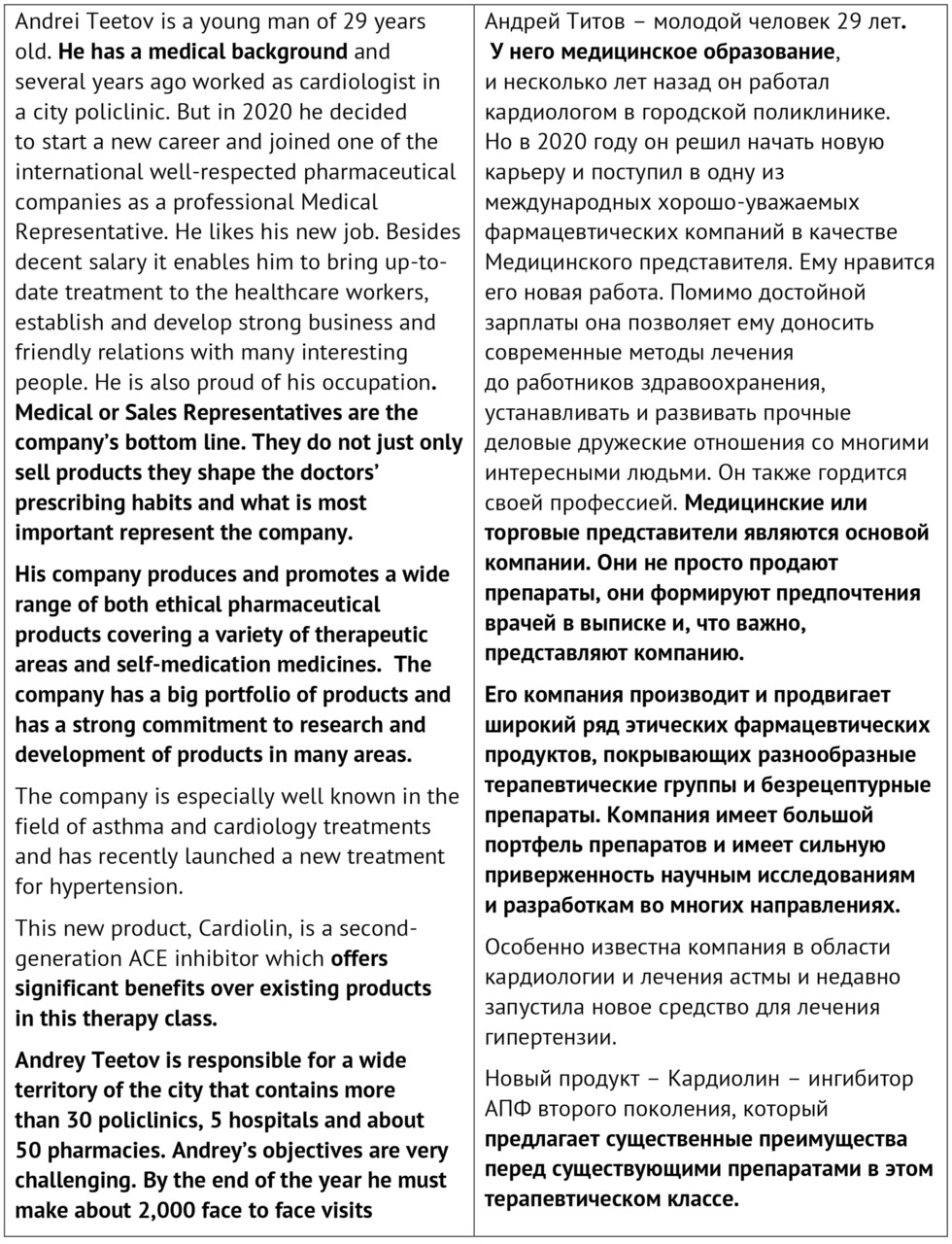
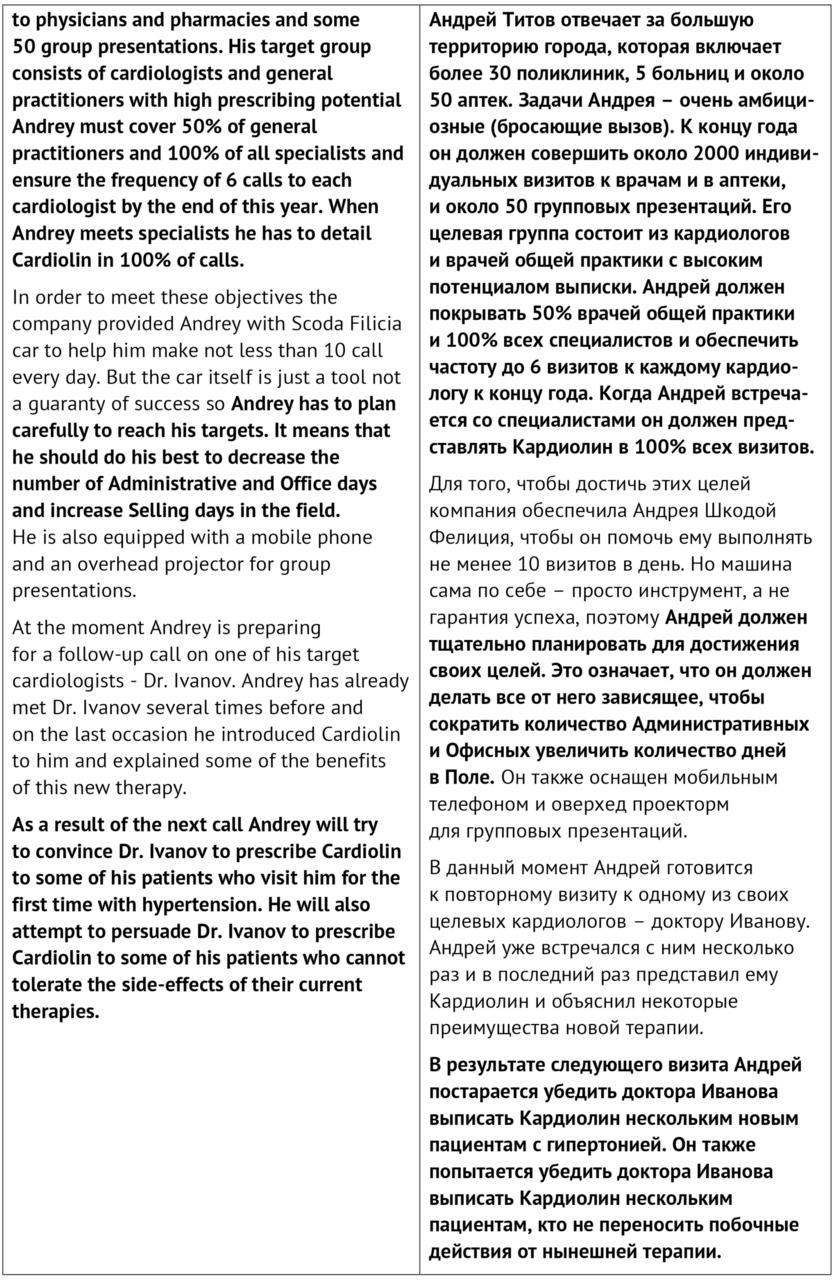
Задание №2
Андрей Киреев закончил Медицинскую Академию им. Сеченова в 1999 году — Привязка к году говорит о неопределенности времени действия (Прошедшее время Группа времен Indefinite).
Сразу после окончания ВУЗа он устроился в поликлинику №11 участковым терапевтом. — Простое перечисление последовательности событий. (Прошедшее время Группа времен Indefinite).
В 2003 году Андрей женился (Прошедшее время Группа времен Indefinite), а год назад в его семье родился сын. — Простое перечисление последовательности событий (Прошедшее время Группа времен Indefinite).
После рождения сына, в семье встал вопрос о необходимости более высоко заработка, и Андрей принял решение пойти работать медицинским представителем в крупную фармацевтическую компанию — Простое перечисление последовательности событий. (Прошедшее время Группа времен Indefinite).
В настоящее время Андрей работает с врачами-терапевтами Западного Административного округа. — Формулировка «в настоящее время» имеет смысл «работает на регулярной основе» (Настоящее время Группа времен Indefinite).
В день он совершает около 10 визитов. — Регулярно повторяющееся действие (Настоящее время Группа времен Indefinite).
Сейчас Андрей едет домой на служебной машине после трудного рабочего дня. — Происходит сейчас, в настоящее время в момент разговора о нем. (Настоящее время Группа времен Continues).
Ему нравиться управлять автомобилем и слушать радио. — Повседневное увлечение, регулярно повторяющееся ощущения. (Настоящее время Группа времен Indefinite).
Андрей только что совершил удачный визит к одному из своих врачей — Действие только что завершилось и имеется результат, который можно обдумать — (Настоящее время Группа времен Perfect), и сейчас продолжает осмысливать ход и результаты проведенной беседы — Одно действие «осмысливает» привязано к другому «управляет машиной» (Настоящее время Группа времен Continues).
Звонит мобильный телефон. — Действие происходит сейчас, в момент разговора об Андрее и в ходе управления автомобилем — (Настоящее время Группа времен Continues).
Андрей принимает вызов и беседует со своим региональным менеджером Сергеем — Действие происходит сейчас, в момент разговора об Андрее и в ходе управления автомобилем (Настоящее время Группа времен Continues).
Его руководитель интересуется, как идут дела у Андрея — Действие происходит сейчас, в момент разговора об Андрее и в ходе управления автомобилем (Настоящее Группа времен Continues).
Тот отвечает — Действие происходит сейчас, в момент разговора об Андрее и в ходе управления автомобилем (Настоящее время Группа времен Continues), что к 17:30 совершил 11 запланированных визитов к врачам — Действие закончилось к времени, находящемуся не в настоящем, а в прошлом, потому что после этого Андрей сел в машину и поехал домой, то есть сейчас уже больше, чем 17:30 — (Прошедшее время Группа времен Perfect).
Сергей спрашивает — Действие происходит сейчас, в момент разговора об Андрее и в ходе управления автомобилем (Настоящее время Группа времен Continues), что Андрей будет делать завтра в 10 часов — Точное указание на время в будущем (Будущее время Группа времен Continues).
Андрей отвечает — Действие происходит сейчас, в момент разговора об Андрее и в ходе управления автомобилем (настоящее время Группа времен Continues), что в это время он будет делать презентацию на круглом столе в больнице №6. — Точная привязка действия к времени в будущем (Будущее время Группа времен Continues).
После этого Сергей говорит (Настоящее время Группы времен Continues), что приедет на эту презентацию — Общее указание на будущее время без точной привязки ко времени. (Будущее время Группа времен Indefinite).
Похоже, завтра у Андрея будет еще один сложный день. — Не привязанное к определенному времени событие в будущем. (Будущее время Группа времен Indefinite).
Задание №7: Письменно ответьте на вопросы сначала в краткой, а затем и полной форме в соответствии с приведенными моделями:
1. Are you a physician?
A. Yes I am. B. No, I am not. I am/not a physician.
2. Were you in the pharmacy yesterday?
A. Yes, I was. B. No, I was not (=wasn’t). I was/was not at the pharmacy yesterday.
3. Will Dr. Frolov attend the conference?
A. Yes, he will. B. No, he will not (=won’t). Dr. Frolov will/not attend the conference.
4. Were you tired after so many calls?
A. Yes, I was. B. No, I was not (=wasn’t). I was/not tired after so many calls.
5. Does Sergey cover such a big territory?
A. Yes, he does. B. No, he does not (=doesn’t). Sergey covers such a big territory
6. Has Michael achieved his monthly objectives?
A. Yes, he does. B. No, he does not (=doesn’t). Michael has/not achieved his monthly objectives.
7. Have you ever visited this medical centre before?
A. Yes, I have. B. No, I have not (=haven’t). I have/not visited this medical centre before.
8. Did Рrofessor Reznikov take part in the discussion?
A. Yes, he did. B. No, he did not (=didn’t). Рrofessor Reznikov didn’t take part in the discussion.
Задание №8: а) Письменно ответьте на следующие утверждения с использованием конструкции: I don’t think he did (was, will…):
1. Did Andrei like the last visit to Dr. Ivanova? I don’t think he did.
2. Will you take part in the next Area meeting? I don’t think I will.
3. Has he achieved his monthly targets? I don’t think he has.
4. Does he like his work as a Medical Representative? I don’t think he does.
5. Has Andrei ever worked as a doctor? I don’t think he has.
6. Is he happy with the results of his work? I don’t think he is.
7. Will they meet their objectives? I don’t think they will.
8. Will you go abroad for your Cycle Conference? I don’t think I/we will.
b) Письменно переведите предложения на английский язык, начиная с конструкции I don’t think, обратите внимание на специфику перевода данной конструкции …:
1. Я думаю, что менеджеру не понравятся эти результаты. I don’t think the manager will like the results.
2. Думаю, что он не совершит 10 визитов каждый день. I don’t think will make 10 calls every day.
3. Думаю, что ему не нравится работать с опинион лидерами. I don’t think he likes to work with opinon leaders.
4. Думаю, что он не пройдет тест по знанию препарата. I don’t think he will pass the product test.
5. Думаю, что он не выполнит свой план. I don’t think he will fulfill the plan.
6. Думаю, что менеджер не откажется помочь ему. I don’t think the manager will refuse to help him.
7. Думаю, она не найдет эту поликлинику. I don’t think she will find the polyclinic.
«Ключ» для проверки контрольной работы по теме №1
1. They are Medical Representatives of the pharmaceutical company.
2. I joined a big international pharmaceutical company a month ago.
3. It goes without saying that Medical Representatives are proud of their occupation.
4. The Medical Representative has already met the physician and is going to the pharmacy now.
5. Our company produces and promotes a wide range of medical products.
6. After the Medical Representative met the physician, the doctor prescribed our product to his patient.
7. She will try to persuade the physician to all his patients who cannot tolerate the side-effects of their current therapies.
8. I am sure that Medical Representatives are the company’s bottom-line.
9. Our company has a strong commitment to research and development of products in many areas.
10. I believe that Medical Representatives shape the doctors’ prescribing habits.
11. This is the first generation product but the physicians want to prescribe the second generation products.
12. Last year the Medical Representatives of the company covered 100% of target pysicians and pharmacies.
13. Looks like the Medical Representatives are responsible for a wide territory.
14. Their territory consists of 30 polyclinics and 70 pharmacies.
15. By the end of the year, we will make more than 5 000 face-to-face calls and about 30 group presentations.
16. I think that our objectives are very challenging.
17. I am afraid this company is not known in the pharmaceutical market.
18. I agree with you that last year he did his best to decrease the number of Administrative days and increase the number of Days in the field.
19. They will promote this product to 50% of general practitioners and to 100% of all specialists.
20. Our product offers significant benefits over existing products in this therapy class.
Тема №2: Структура и содержания эффективного визита медицинского представителя к врачу
Учебный модуль №1. Грамматика:
Образование вопросительных и отрицательных предложений в различных группах времен англ. языка; общие и специальные вопросы
Для построения отрицательной и вопросительной формы в английском языке используется универсальная формула: вспомогательный глагол + отрицательная частица — not.
Таким образом, отрицательное предложения в настоящем неопределенном времени содержит вспомогательный глагол -do или -does (в зависимости от лица и числа), к которым добавляется отрицательная частица not. Поэтому формула отрицания здесь = do/does +1 форма смыслового глагола + not или сокращенно don’t, doesn’t.
Примеры:
I do not (don’t) like to work in the pharmacy.
Andrei Titov doesn’t come home early.
Medical Representatives usually don’t spend much time in the office.
Английский язык предполагает четкую структуру и порядок слов для общих и специальных вопросов (медицинские представители из курса Техники Продажи знают их под терминами «закрытый» и «открытый» вопрос). Для образования вопроса в настоящем неопределенном времени используется все тот же вспомогательный глагол do/does. Общий (закрытый) вопрос предполагает следующий порядок слов:
• на 1-ом месте — вспомогательный глагол do для (i, you, we, they) и does для (he, she, it);
• на 2-м месте — подлежащее;
• на 3-м месте — сказуемое;
• далее — другие второстепенные члены предложения (дополнение, обстоятельство места, обстоятельство времени и т.д.)
Грамматическими особенностями образования вопроса в третьем лице единственного числа (he, she, it) являются, во-первых, вспомогательный глагол does, а, во-вторых, отсутствие у сказуемого окончания -s, характерного для повествовательного предложения. Образно говоря, окончание -s как бы перемещается от сказуемого во вспомогательный глагол в соответствии с формулой do + s = does.
Примеры:
1 2 3
Do you like your job as a medical representative?
1 2 3
Does Andrei Titov work_in a pharmaceutical company?
В специальном (открытом) вопросе в отличие от вопроса общего перед вспомогательным глаголом do/does ставится вопросительное слово (what, when, how, where, why, how many…).
Примеры:
1 2 3 4
What do you know about Andrei Titov?
1 2 3 4
Why does he like his new job?
1 2 3 4
How many calls a day do medical representatives make?
Особенностью построения специального (открытого) вопроса является также образование вопроса к подлежащему, начинающегося с вопросительного слова who. В этом случае в вопросе отсутствует вспомогательный глагол do/does, а в третьем лице единственного числа к сказуемому возвращается его законное окончание -s.
Примеры:
1 2
Who works in a well known pharmaceutical company?
1 2
Who makes calls to physicians every day?
Вопросительные и отрицательные формы с глаголом, передающим состояние в настоящем неопределенном времени, образуются не через использование вспомогательного глагола, а при помощи уже имеющегося в предложении части смыслового глагола, то есть присоединения к нему частицы -not в отрицательной форме или перемещение его на первое место в вопросительной конструкции. Например: Is Andrei busy today? No, he is not. Yes, he is.
Why is Andrei busy today?
Образование вопросительного предложения
в настоящем продолженном времени
Превращение повествовательного предложения в вопросительное происходит путем постановки на первое место вспомогательного глагола.
Примеры:
Повествовательное предложение: Andrei Titov is making a call to senior cardiologist now. Андрей Титов совершает визит к главному кардиологу (подразумевается, сейчас).
Общий вопрос: Is Andrei Titov making a call to senior cardiologist now?
Специальный вопрос: To whom is Andrei Titov making a call now?
Как Вы видите, перед вспомогательным глаголом ставится специальное вопросительное слово.
Вопрос к подлежащему: Who is making a call to senior cardiologist now?
Образование отрицательного предложения
в настоящем продолженном времени
Образуется по формуле: вспомогательный глагол -be в соответствующей подлежащему форме (am, are, is) + отрицательная частица not, которая ставится перед смысловом глаголом в первой форме с окончанием -ing. Примеры:
I am not filling in my call report forms now. Я сейчас не заполняю формы отчета по визитам.
He is not talking to the product manager now. Сейчас он не разговаривает с менеджером по препарату.
They are not making a presentation now. Сейчас они не делают презентацию.
Образование отрицательного предложения
в прошедшем продолженном времени
Образуется также по формуле: вспомогательный глагол -be в соответствующей подлежащему форме (was, were) + отрицательная частица not, которая ставится перед смысловом глаголом в первой форме с окончанием -ing.
Примеры:
I was not filling in my call report forms at that time yesterday. Я не заполнял формы отчета по визитам вчера в это время.
He was not talking to the product manager at that time yesterday. Он не разговаривал с менеджером по препарату вчера в это время.
They were not making a presentation from 10 to 11 o’clock yesterday. Они не делали презентацию с 10 до 11 часов вчера.
Образование вопросительной формы в настоящем
завершенном времени
Подчиняется общему правилу, когда вспомогательный глагол выносится на первое место.
Примеры:
Общий вопрос:
Have you already finished to fill in the call report forms?
Has Andrei Titov returned from his summer vocation?
Специальный вопрос:
Why has he finished his visit so fast?
Why haven’t you reported the adverse event immediately? Так называемый вопрос с отрицанием, передающий высокую степень эмоциональности (в данном случае — негодования). Почему Вы немедленно не сообщили о нежелательном явлении (при использовании препарата)?
What have you already done to solve the problem in the policlinic? Обратите внимание, что наречие -already находится в предложении между подлежащим и сказуемым.
Вопрос к подлежащему: Обратите внимание, что вспомогательный глагол стоит в единственном числе.
Who hasn’t handed in call report forms yet? Кто еще не сдал форму отчета?
Who has already made all presentations to the target physicians? Кто уже сделал все презентации для целевой группы врачей?
Образование отрицания в Present Perfect
Отрицательные предложения образуются путем присоединения частицы -not к вспомогательному глаголу -have (have not = haven’t или has not = hasn’t). В отрицательных предложениях в этой группе времен очень часто используется наречие «еще» — yet, которое ставится в самый конец предложения.
Примеры:
These medical representatives haven’t handed in their call reports yet. Эти медицинские представители еще не сдали свои формы отчетов.
Our product manager hasn’t prepared new promotional materials yet. Наш продакт — манеджер еще не подготовил новые промоционные материалы.
Образование отрицания в Past Perfect
Отрицательные предложения образуются путем присоединения частицы -not к вспомогательному глаголу -had (had not = hadn’t).
Примеры:
These medical representatives hadn’t handed in their call reports by 19 o’clock yesteday. Эти медицинские представители не сдали свои формы отчетов вчера к 19 часам.
Our product manager hadn’t prepared new promotional materials by the beginning of the cycle. Наш продакт — манеджер не подготовил новые промоционные материалы к началу промоционного цикла.
Учебный модуль №2. Текст:
An effective sales call on a physician
Every Medical Rep must do some pre-call planning because good preparation is more than 50% of the call success. The special technique that the Sales Reps use to prepare for the call is known as SMART. It means that the sales objectives have to be… Specific, Measurable, Ambitious but Achievable and finally Timed.
To make your call specific you have to know what you want to achieve — for example: you want the doctor to try the product that you are promoting on a specific group of patients.
Measurable means that you have in mind how many patients the doctor will try your product on and for how long.
Ambitious objective means that you should aim high — for example: to persuade a physician to try your product on at least six new patients and probably three or four of his existing patients with no or small progress on their current therapy. Being ambitious don’t forget to stay Realistic too.
And finally… the sales call objective must be Timed. It means that a Sales Rep must have in mind the time period for the physician to use the new product and so that he/she could build some confidence loyalty in it. For example if the doctor starts using the new product right away, he/she should be able to get the right patients within two weeks, one month’s initial treatment should be enough for him to measure the effect so you can probably be back to him/her for results in six weeks.
In addition to setting objectives for the call an effective Sales Rep must in advance prepare promotional literature because physicians always like to see proof of the benefits so it is important to have a copy of the clinical paper on the comparative study.
Every sales call also needs a good opening to focus the direction of the call, and to identify what both the salesperson and the customer will gain from their meeting. The skill of opening will enable a Sales Rep to get his customer’s interest and to see value in spending time with him. You need to recognize the appropriate time to open, state the purpose of the call, then reveal what the customer will get from the call. Finally, gain agreement to proceed.
Exploring is the single most powerful and effective skill in selling. By the skillful use of exploring techniques, you can discover your customer’s personal, organizational and buying needs. By asking open questions you can make your customer respond freely, and by asking closed questions, you can gain «yes’ or «no’ responses. By using the information you obtain through skillful exploring, you can proceed much more effectively through the sales call. The most effective and well known technique of exploring customer’s needs is SPIN techniques where S stands for a group of situational questions, P — a group of problem questions, I — implication questions and N — navigation questions.
After you’ve uncovered a customer’s need through exploring, and you understand and respect that need fully and clearly, then you provide the information about the relevant features, advantages and benefits of your product to show the customer specifically how you can satisfy their needs.
However, during the call the Sales Reps often face some real challenges. These challenges include doubts and misconceptions, limitations and indifference. In order to manage these challenges, one needs to explore to understand the challenge, listen carefully, respect the customer’s point of view and show that you understand it.
Doubts and misconceptions can occur because the customer may doubt whether your product really does have the features or benefits that you say it has, or he may have incomplete or inaccurate information. It is not surprising that customers question you in depth. They want to be sure that you really can deliver what you claim.
Every product has its limitations. That is something that cannot be offered or satisfied by that product. To manage this challenge properly you will need to explore to understand the limitation fully, acknowledge the limitation, put the limitation into perspective and balance it with relevant accepted benefits. You then need to gain the customer’s agreement that the limitation has been managed.
Indifference is when the customer is not at all interested in what you have to say, doesn’t want your product and feels that it would not add any value to his/her practice. This is classic indifference. It is one of the most challenging situations any salesperson can face. To manage indifference, you need to acknowledge the customer’s point of view before requesting permission to proceed with the call; then explore, to build up the customer’s perception of the current situation; and uncover the opportunities, implications and needs arising out of that situation.
Closing can be a challenge to many salespeople. Often, people see it as the final step and are afraid to ask for commitment because they fear that the customer will say «No!» However, the skill of closing is an integral part of the whole sales process and if you fail to do it, you fail to sell. You need to recognize the appropriate time to close, and recognize when the customer gives a buying signal. Then you need to remind the customer of the accepted benefits, suggest a future plan, and gain agreement. If you follow these steps, asking the customer for commitment at the end of a call seems much less difficult. In fact, it will seem natural both to you and your customer.
Учебный модуль №3. Новые слова
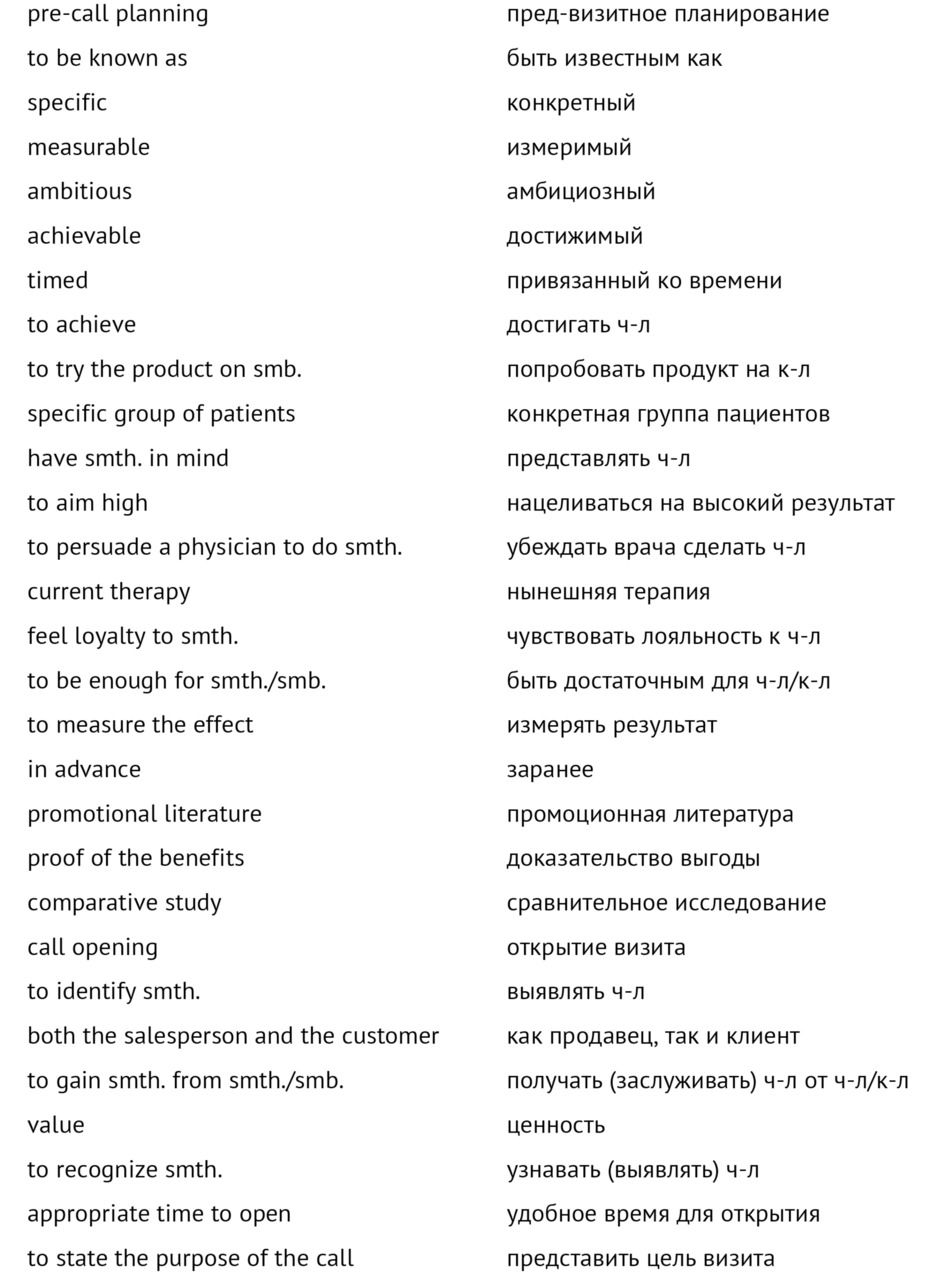
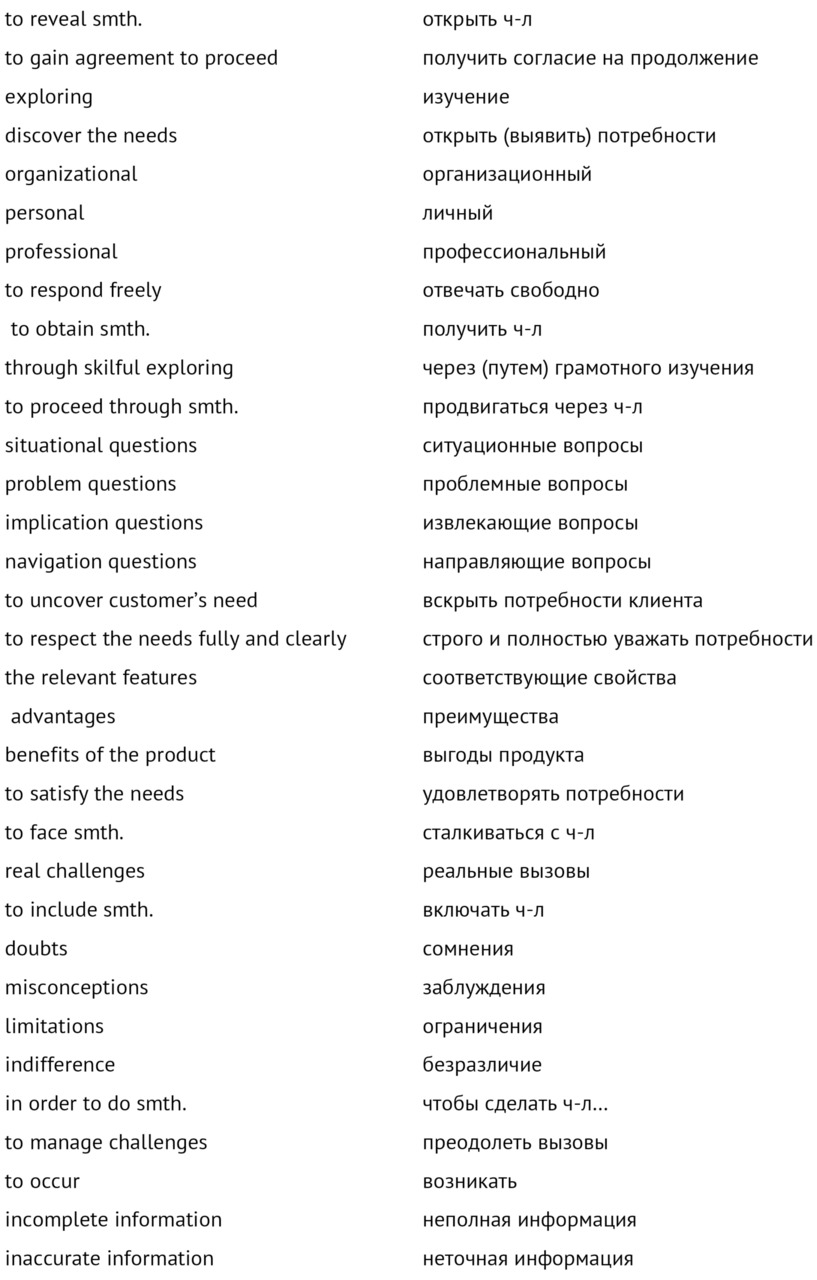
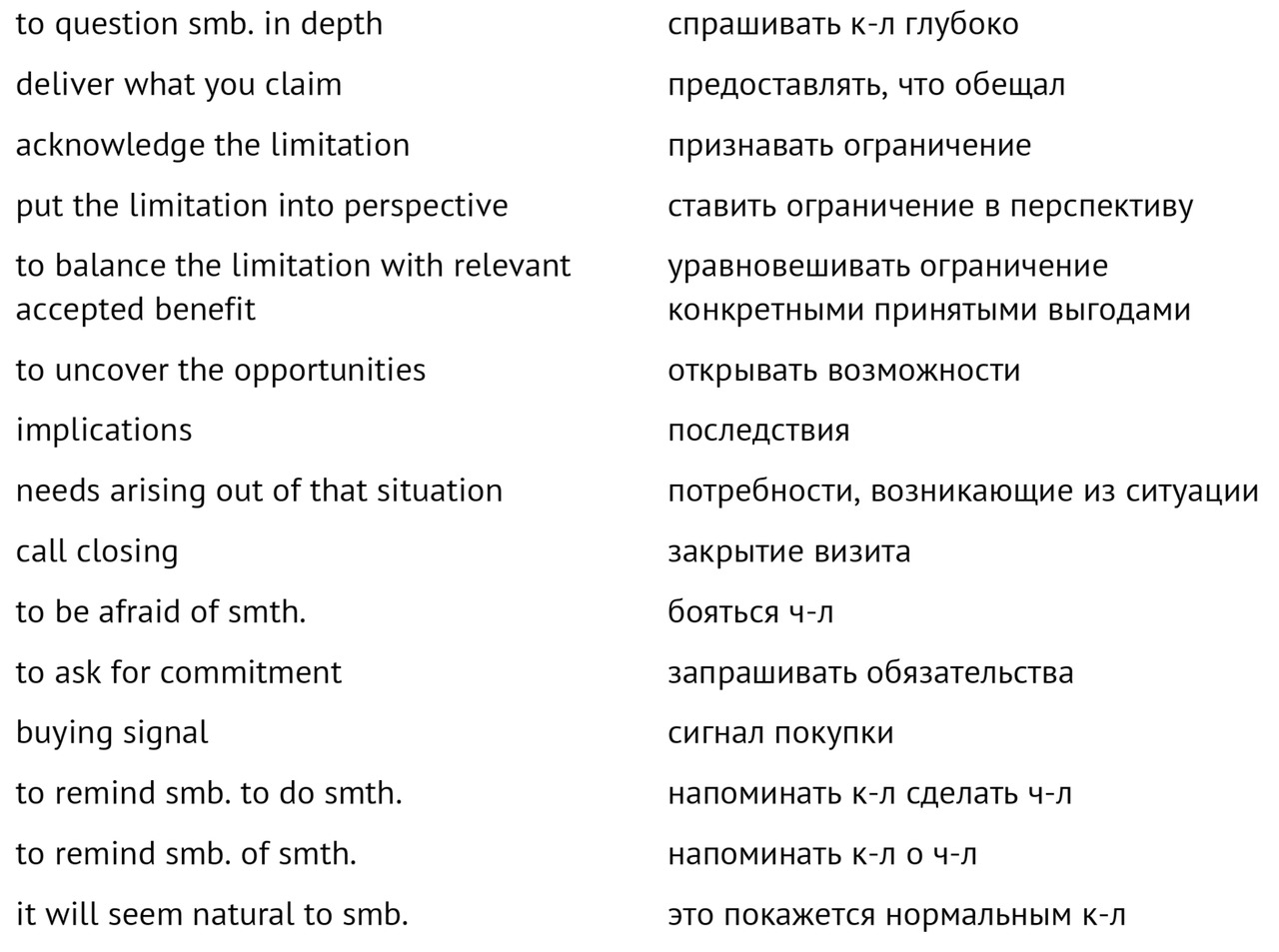
Учебный модуль №4.
Работа над текстом и грамматикой
Задание №1: Прочитайте и переведите текст с опорой на аудиозапись.
Задание №2: Устно ответьте на следующие вопросы с опорой на текст.
1. Why must every Medical Rep do some pre-call planning?
2. What is a special technique that the Sales Reps use to prepare for the call?
3. What does SMART mean?
4. What does Specific mean in SMART?
5. What does Measurable mean in SMART?
6. What does Ambitious mean in SMART?
7. What does Timed mean in SMART?
8. Why must Sales Rep prepare promotional literature for a call?
9. Why is a good opening so important for a sales call?
10. What does the skill of opening enable a Sales Rep?
11. What does the skill of opening include?
12. Why is exploring the most powerful and effective skill in selling?
13. What does exploring help a Sales Rep to discover?
14. What can a Sales Rep achieve by asking open questions?
15. What can a Sales Rep achieve by asking close questions?
16. What is the most effective and well known technique of exploring customer’s needs?
17. What does SPIN mean?
18. What does S mean in SPIN?
19. What does P mean in SPIN?
20. What does I mean in SPIN?
21. What does N mean in SPIN?
22. Why is it important to ask a customer situation questions?/What is the use of asking…?
23. Why is it important to ask a customer problem questions?
24. Why is it important to ask a customer implication questions?
25. Why is it important to ask a customer navigation questions?
26. When must a Sales Rep provide the information about the relevant features, advantages and benefits of your product?
27. Why is it important to provide the information about the relevant features, advantages and benefits of your product?
28. What can a Sales Rep achieve by providing the information about the relevant features, advantages and benefits of your product?
29. What do Sales Reps often face during the call?
30. Why do Sales Reps often face challenges during the call?
31. What do challenges include?
32. What must a Sales Rep do to manage these challenges?
33. Why do doubts and misconceptions occur?
34. Why does indifference occur?
35. Why do limitations occur?
36. What must a Sales Rep do to manage the product limitation?
37. What does it mean to balance the limitation with a relevant accepted benefit?
38. What makes indifference the most difficult challenge for a Sales Rep?
39. What must a Sales Rep do to manage a customer indifference?
40. Why can closing be a challenge for many Sales Reps?
41. What does closing include?
42. Why is closing so important for a sales call?
Задание №3: Устно завершите приведенные ниже фразы c опорой на текст:
1. Every Medical Rep must do…
2. A good preparation is…
3. SMART means that the sales objectives have to be…
4. To make your call specific you must…
5. Specific in SMART means that…
6. Measurable in SMART means that…
7. Ambitious in SMART means that…
8. Timed in SMART means that…
9. In addition to setting objectives for the call an effective Sales Rep must…
10. Physicians always like…
11. A good opening helps…
12. The skill of opening will enable a Sales Rep…
13. In order to have a good opening a Sales Rep must…
14. By the skillful use of exploring techniques a sales Rep can…
15. By the skillful use of exploring techniques a sales Rep can…
16. By asking open questions a Sales Rep can…
17. By asking close questions a Sales Rep can…
18. SPIN is…
19. S in SPIN stands for…
20. P in SPIN stands for…
21. I in SPIN stands for…
22. N in SPIN stands for…
23. After a Sales Rep has uncovered a customer’s need…
24. During the call the Sales Reps often face…
25. These challenges include…
26. In order to manage these challenges, one needs to…
27. Doubts and misconceptions can occur because…
28. When customers question Sales Reps in depth…
29. Every product has not only benefits but…
30. To manage limitations properly a Sales Rep…
31. Indifference is when…
32. Indifference is one of the most challenging situations for salesperson because…
33. To manage indifference a Sales Rep needs…
34. Sales Reps are often afraid…
35. The skill of closing is an integral part…
36. If a Sales Rep fails to close…
37. To do an effective closing a Sales Rep must…
Задание №4: Письменно поставьте повествовательные предложения в:
а) отрицательную; в) вопросительную форму:
1. Every Medical Rep must do some pre-call planning.
2. Good preparation is more than 50% of the call success.
3. You want the doctor to try the product you are promoting on a specific group of patients.
4. You have in mind how many patients the doctor will try your product on.
5. The sales call objective must be Timed.
6. Sales Rep must have in mind the time period for the physician to use the new product.
7. The doctor will start to use the new product right away.
8. He should be able to get the right patients within two weeks.
9. An effective Sales Rep must in advance prepare promotional literature.
10. Physicians always like to see proof of the benefits.
11. It is important to have a copy of the clinical paper on the comparative study.
12. Every sales call also needs a good opening.
13. Both the salesperson and the customer will gain benefits from the call.
14. The skill of opening will enable a Sales Rep to get his customer’s interest.
15. Every customer wants to see value in spending time with a Sales Rep.
16. A Sales Rep needs to recognize the appropriate time to open.
17. An effective sales person must state the purpose of the call.
18. He then explained what the customer would get from the call.
19. Exploring is the effective skill in selling.
20. By asking questions, the Sales Rep has discovered the customer’s buying needs.
21. By asking open questions, you can make your customer respond freely.
22. By asking closed questions, you can gain «yes’ or «no’ responses.
23. The Sales Rep has proceeded very effectively through the sales call.
24. The experienced Sales Rep has uncovered the customer’s needs.
25. After exploring the customer’s needs the Sale Rep has provided the information about the relevant features, advantages and benefits of the product.
26. During the call the Sales Rep faced some real challenges.
27. He explored challenge and listened carefully.
28. The sales rep must respect the customer’s point of view.
29. Doubts and misconceptions can occur at every stage of the call.
30. The customer doubted whether your product really had the features or benefits.
31. After the call the customer had incomplete or inaccurate information.
32. It is not surprising that the customer was questioning you in depth.
33. They wanted to be sure that you really could deliver what you claimed.
34. Every product has its limitations.
35. A limitation is something that your product can’t offer or satisfy.
36. You will need to explore the limitation fully.
37. You must put the limitation into perspective.
38. He balanced the limitation with relevant accepted benefits.
39. In the end of the call he has gained the customer’s agreement.
40. He feels that the product will add some value to his practice.
41. The Sales Rep has uncovered all opportunities.
42. He has found implications and needs arising out of that situation.
43. Many sales Reps are afraid to ask for commitment
44. He feared that the customer would say «No!»
45. The Sales Rep has failed to close the call.
46. During his last call he recognized the appropriate time to close.
47. The customer has given a buying signal.
48. The Sales Rep has reminded the customer of the accepted benefits.
49. Tomorrow you will need to suggest an action-plan.
Задание №5: Письменно задайте вопросы к подчеркнутым словам в предложении:
1. Every MedicalRep must do some pre-call planning because goodpreparation is more than 50% of the call success.
2. The doctor wants to try the product on a specificgroup of patients.
3. The Sales Rep aimed high.
4. A Sales Rep must have in mind the customer’s profile.
5. The physician started to use the new product tofeel some loyalty to it.
6. The physician got the right patients within two weeks.
7. One month’sinitial treatment was enough forthe patient to feel some progress.
8. The Sales Rep must in advance prepare promotionalliterature.
9. Physicians always like to see proof of the benefits.
10. It is importantto have a copy of the clinical paper for the call.
11. Every salescall also needs a good opening.
12. Both thesalesperson and the customer will gain benefitsfrom the call.
13. The skill ofopening will enable a Sales Rep toget his customer’s interest.
14. Every customer wants to see value in spending time with aSales Rep.
15. A Sales Rep needs to recognize the appropriate timeto open.
16. An effectivesales person must always state the purpose of the call.
17. He explained what the customer would get fromthe call.
18. Exploring is the most effective skill in selling.
19. By askingquestions, the Sales Rep has discoveredthe customer’s buying needs.
20. By asking openquestions, you can make your customer respondfreely.
21. By asking closedquestions, you can gain «yes’ or «no’ responses.
22. The Sales Rep has proceeded very effectively through thesales call.
23. The experiencedSales Rep has uncovered the customer’s needs.
24. After exploringthe customer’s needs the SaleRep provided the information about the relevant features, advantages andbenefits of the product.
25. During the call the Sales Rep faced some real challenges.
26. He explored the challenges and listened carefully.
27. The SalesReps must respect the customer’s point of view.
28. Doubts andmisconceptions can occur at every stage of thecall.
29. The customer doubted whether your product really had thefeatures or benefits.
30. After your call the customer had incomplete or inaccurateinformation.
31. It is notsurprising that the customer was questioningyou in depth.
32. They wanted to be sure that you really could deliverwhat you claimed.
33. Every product has its limitations.
34. A limitation issomething that can be offered or satisfied by that product.
35. You will need to explore the limitation fully.
36. You must put the limitation into perspective.
37. He balanced the limitation with relevantaccepted benefits.
38. In the end ofthe call he has gained thecustomer’s agreement.
39. The customer was not at all interested in what you were saying.
40. He doesn’t want your product.
41. He feels that the product will add some value to hispractice.
42. The Sales Rephas uncovered all opportunities.
43. He has found implications and needs arisingout of that situation.
44. Many Sales Repsare afraid to ask for commitment.
45. He feared thatthe customer would say «No!»
46. The Sales Rep has failed to close the call.
47. During his last call he recognized the appropriate time to close.
48. The customer has given a buying signal.
49. The Sales Rep has reminded the customer ofthe accepted benefits.
50. Tomorrow you will need tosuggest an action-plan.
Учебный модуль №5.
Слова и выражения для диалогов по теме
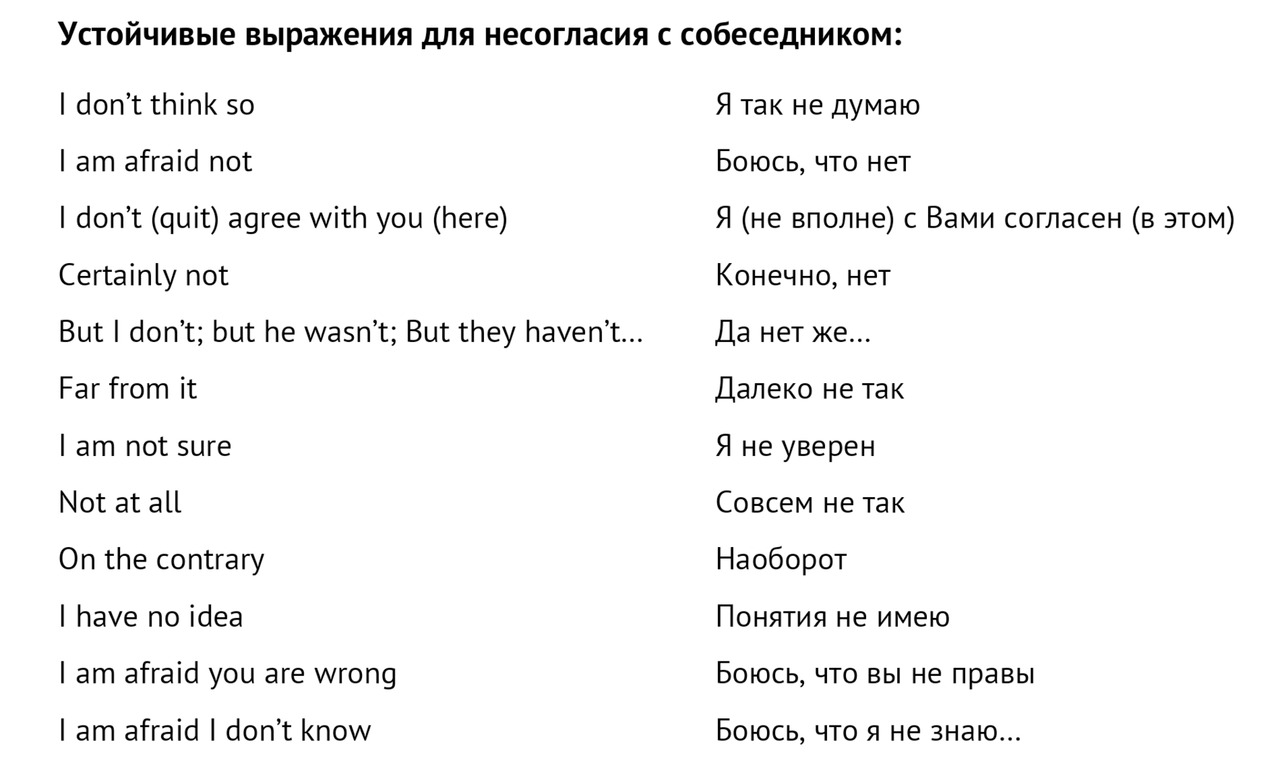
Задание №6: Устно прореагируйте на следующие реплики. Исправьте утверждения не соответствующие содержанию текста.
1. Every Medical Rep must do some pre-call planning.
2. Good preparation is more than 50% of the call success.
3. The special technique that the Sales Reps use to prepare for the call is known as SPIN.
4. To make your call specific you have to know what you want to achieve.
5. Measurable means that you have in mind the time for the call.
6. Ambitious objective means that you should plan the closing.
7. Ambitious and Realistic are the same thigs.
8. Timed means that a Sales Rep must have in mind the duration of the call.
9. Promotional literature is not that much important for doctors.
10. For effective call a Sales Rep must prepare promotional literature in advance.
11. Physicians always like to see proof of the benefits.
12. It isn’t important to have a copy of the clinical paper on the comparative study.
13. Every sales call needs a good opening.
14. A customer doesn’t need to see value in spending time with a Sales Rep.
15. Sometimes physicians see no value in spending time with a Sales Rep.
16. It is very bad when physicians see no value in spending time with Sales Reps.
17. It is very good when both the salesperson and the customer see what they gain from their meeting.
18. Exploring is not needed when the physician is very busy.
19. By the use of exploring techniques a Sales Rep can discover all customer’s needs.
20. By the use of exploring techniques a Sales Rep can discover only professional needs of the customer.
21. By asking open questions a Sales Rep can gain «yes’ or «no’ responses.
22. By asking close questions a Sales Rep can get some new information about the customer.
23. The most effective and well known technique of exploring customer’s needs is SMART technique.
24. In SPIN technique S stands for a group of situational questions.
25. In SPIN technique P stands for a group of professional questions.
26. After a Sales Rep has uncovered a customer’s need through exploring he/she closes the call.
27. Advantages and benefits of the product show the customer how a Sales Rep can satisfy his/her need.
28. Doubts and misconceptions, limitations and indifference don’t present any challenges for a Sales Rep.
29. An experienced Sales Rep never faces challenges with customers.
30. Every product has its limitations.
31. Modern products don’t have any limitations.
32. It is very surprising when customers question a Sales Rep in depth.
33. An indifferent customer never questions a Sales Rep in depth.
34. Limitation is something that can not be offered or satisfied by the product.
35. To manage this challenge a Sales Rep will need to explore to understand the limitation fully, acknowledge the limitation, put the limitation into perspective and balance it with relevant accepted benefits.
36. Closing can’t be a challenge to experienced salespeople.
37. Many sales persons are afraid to ask for commitment because they fear that the customer will say «No!»
38. If a sale Rep fails to close the call he/she can fail to sell.
39. The skill of closing is an integral part of the whole sales process.
Задание №7: Устно выразите свое несогласие с приведенными утверждениями и исправьте их:
Model: Andrei Titov is a cardiologist. But he isn’t. Andrei Titov is a Medical Representative of a well known pharmaceutical company.
1. Medical Representatives work in the office.
2. Alexey has left for the pharmacy.
3. Dr. Petrov has just returned from an international congress on athma treatment.
4. The manager will make several double calls tomorrow.
5. Sales representatives work in shops and supermarkets.
6. Vishnevsky was a Medical Representative.
7. It is a private medical centre.
8. There is just one Medical Representative in our company.
9. There are only 10 selling days in August.
10. You don’t like the job of a Medical Representative.
11. You company is small.
12. You company is not known in the market.
13. This hospital is in the North of the city.
14. The product manager has not returned to the office yet.
15. The marketing Director won’t go to the Cycle Conference.
Задание №8: a) Устно согласитесь или не согласитесь с приведенными высказываниями, используя следующие модели:
Model: Yes, he is (did, will…)
But he isn’t (didn’t, won’t…)
Example: Medical Representatives work in the office. But they don’t. They mainly work in the field with the customers.
1. You don’t have enough product knowledge.
2. Andrei Titov is an opinion leader.
3. Medical Representatives make calls to pharmacies only.
4. Andrei works in a pharmaceutical company for many years.
5. Doctors like it when Medical Representatives visit them.
6. Andrei’s yearly objectives are very easy to achieve.
7. There are many decision makers in a medical institution.
8. You have just made a presentation of a product to a group of doctors.
9. You are filling in a call report.
10. Andrei doesn’t know the product he promotes.
11. You have never worked as a doctor.
12. Andrei didn’t work yesterday.
13. Product managers always visit doctors with medical representatives.
14. It is very easy to become a medical representative.
b) Письменно переведите предложения на английский язык:
1. Она работает врачом. Да нет же. Она работает медицинским представителем в фармацевтической компании.
2. Д-р Сергеева еще не вернулась с международного конгресса. Да нет же. Она вернулась месяц назад.
3. Андрей Титов поедет в Турцию на цикловую конференцию. Да, это действительно так.
4. Медицинские представители обычно работают в офисе. Да, нет же. Они всегда работают «в поле» со своими клиентами.
5. В больших фармкомпаниях обычно работают мало медицинских представителей. Да, нет же, в больших фармкомпаниях работает много медицинских представителей.
6. Медицинские представители, как правило, не имеют машин. Да, нет же, медицинские представители обычно имеют машины.
7. Медицинские представители сами покупают мобильные телефоны. Да, нет же, компания покупает для них мобильные телефоны.
Задание №9: Устно, исправьте неправильные высказывания, начиная предложение с конструкции Excuse me, but …:
Model: Andrei Titov is a local opinion leader. Excuse me, but Andrei Titov isn’t an opinion leader, he is a Medical Representative.
1. You company is well known in the market for its asthma portfolio.
2. Andrei Titov is an old man.
3. Our product manager is not experienced enough.
4. There are no samples (образцы) in your bag.
5. You work in a pharmaceutical plant.
6. Your territory is situated next to Andrei’s territory.
7. The representative office of your company is situated in Nizhny Novgorod.
8. All medical representatives have cars.
9. Not all managers have company cars.
Задание №10: Устно исправьте приведенные ниже высказывания. Начните предложение с конструкций: Not at all; On the contrary; Far from it…:
1. Andrei doesn’t like to work as a Medical Representative.
2. He is a good product manager.
3. Your pharmaceutical company is not known in the Russia market.
4. Medical Representatives are usually engineers.
5. Product managers make many calls a day.
6. Andrei Titov usually comes home very early every day.
7. They don’t establish good relations with physicians.
8. He doesn’t plan his visits beforehand.
9. Managers don’t help their medical representatives.
10. Opinion leaders usually like to meet medical representatives.
Задание №11: Устно отреагируйте на приведенные ниже высказывания. Исправьте неправильные утверждения:
1. Andrei Titov always comes to his customers on foot.
2. You company is small.
3. There are no Medical Representatives in Russia.
4. Your territory coverage is high.
5. You studied in a medical Institute.
6. Your manager made a presentation at the last Cycle Meeting.
7. Your colleagues can’t ensure the necessary territory coverage.
8. The general manager of your company is a foreigner.
9. Medical Representative shouldn’t visit their customers without good preparation.
10. It is necessary for each sales person to demonstrate excellent selling skills.
11. My colleagues have never been abroad.
12. Medical Representatives never attend area meetings.
13. It is difficult to sell anything if you don’t know your customer’s needs.
14. It is easy to convince a doctor to write out a prescription.
Задание №12: Письменно, ответьте, что Вы не знаете ответа на заданный вопрос, используя приведенные ниже модели:
• I am afraid I don’t know…
• I am afraid I can’t say…
• I have no idea…
I am afraid I don’t know why every Medical Rep must do some pre-call planning.
I am afraid I can’t say why every Medical Rep must do some pre-call planning.
I have no idea why every Medical Rep must do some pre-call planning.
1. What is a special technique that the Sales Reps use to prepare for the call?
2. What does SMART mean?
3. What does Specific mean in SMART?
4. What does Measurable mean in SMART?
5. What does Ambitious mean in SMART?
6. What does Timed mean in SMART?
7. Why must Sales Rep prepare promotional literature for a call?
8. Why is a good opening so important for sales call?
9. What does the skill of opening enable a Sales Rep?
10. What does the skill of opening include?
11. Why is exploring the most powerful and effective skill in selling?
12. What does exploring help a Sales Rep to discover?
13. What can a Sales Rep achieve by asking open questions?
14. What can a Sales Rep achieve by asking close questions?
15. What is the most effective and well known technique of exploring customer’s needs?
16. What does SPIN mean?
17. What does S mean in SPIN?
18. What does P mean in SPIN?
19. What does I mean in SPIN?
20. What does N mean in SPIN?
21. Why is it important to ask a customer situation question?
22. Why is it important to ask a customer problem question?
23. Why is it important to ask a customer implication question?
24. Why is it important to ask a customer navigation question?
25. When must a Sales Rep provide the information about the relevant features, advantages and benefits of your product?
26. Why is it important to provide the information about the relevant features, advantages and benefits of your product?
27. What can a Sales Rep achieve by providing the information about the relevant features, advantages and benefits of your product?
28. What do Sales Reps often face during the call?
29. Why do Sales Reps often face during the call?
30. What do challenges include?
31. What must a Sales Rep do to manage these challenges?
32. Why do doubts and misconceptions occur?
33. Why does indifference occur?
34. Why do limitations occur?
35. What must a Sales Rep do to manage the product limitation?
36. What does it mean to balance the limitation with a relevant accepted benefit?
37. What makes indifference the most difficult challenge for a Sales Rep?
38. What must a Sales Rep do to manage a customer indifference?
39. Why can closing be a real challenge for many Sales Reps?
40. What does call closing include?
41. Why is closing so important for a sales call?
Задание №13: Подготовьте краткий (3—4 вопроса/ответа) диалог на тему: Важность хорошей подготовки к визиту к врачу.
Задание №14: Подготовьте краткий (3—4 вопроса/ответа) диалог на тему: Что такое SPIN.
Задание №15: Подготовьте краткий (3—4 вопроса/ответа) диалог на тему: Роль «завершения» в достижении цели визита.
Учебный модуль №6.
Контрольная работа по теме №2
Задание: переведите письменно предложения с английского языка на русский.
1. Я не уверен, что каждый Медицинский представитель выполняет подготовку к визиту.
2. Какой специальной техникой пользуется Медицинский представитель, чтобы подготовиться к визиту?
3. Что означает SMART mean?
4. Я не уверен, что Медицинские представители используют промоционные материалы на каждом визите.
5. Почему хорошее открытие так важно для визита?
6. Что позволяет Медицинскому представителю делать навык открытия визита?
7. Боюсь, что Вы не правы, когда говорите, что навык выявления потребностей включает активное слушание.
8. Я не согласен с Вами, что Медицинский представитель ничего не достигает, задавая открытые вопросы.
9. Какая наиболее эффективная и хорошо известная техника изучения потребностей клиента?
10. Почему важно задавать клиенту открытые вопросы?
11. Почему Медицинский представитель представил информацию по препарату до выявления потребностей клиента?
12. Боюсь, что я не знаю, почему Медицинские представители часто встречаются с возражениями/вызовами во время визита.
13. Что включают в себя возражения?
14. Что сделал Медицинский представитель, чтобы преодолеть эти возражения?
15. Почему возникают сомнения и непонимания?
16. Как Медицинский представитель преодолел реальный недостаток препарата?
17. Что делает безразличие наиболее сложным возражением для Медицинского представителя?
18. Что Вы сделаете, чтобы преодолеть возражение клиента?
19. Почему он провалил продажу?
20. Не думаю, что завершение так важно для визита.
Учебный модуль №7. «Ключи» для проверки правильности выполнения заданий
Работа с текстом: перевод и заучивание (выделено жирным шрифтом)
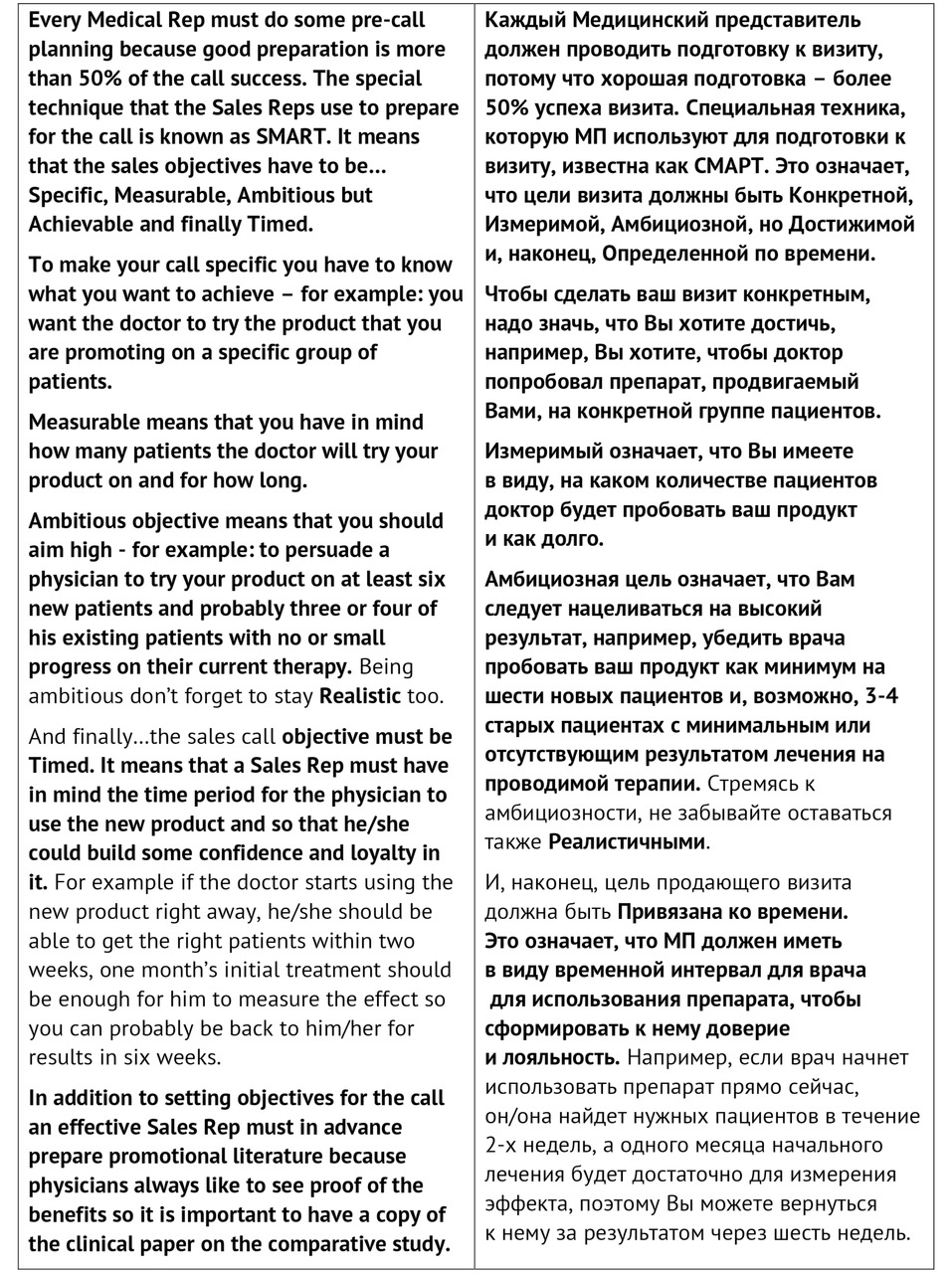
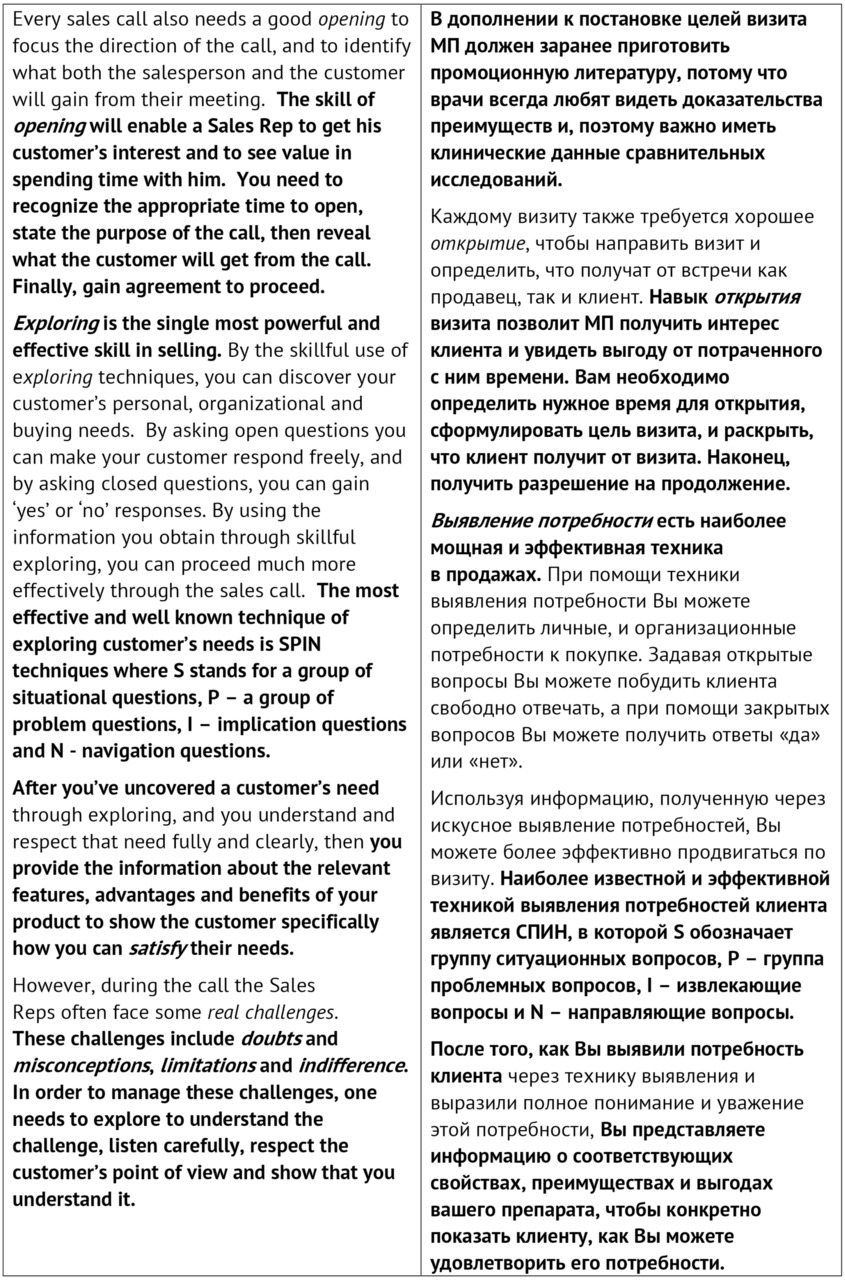
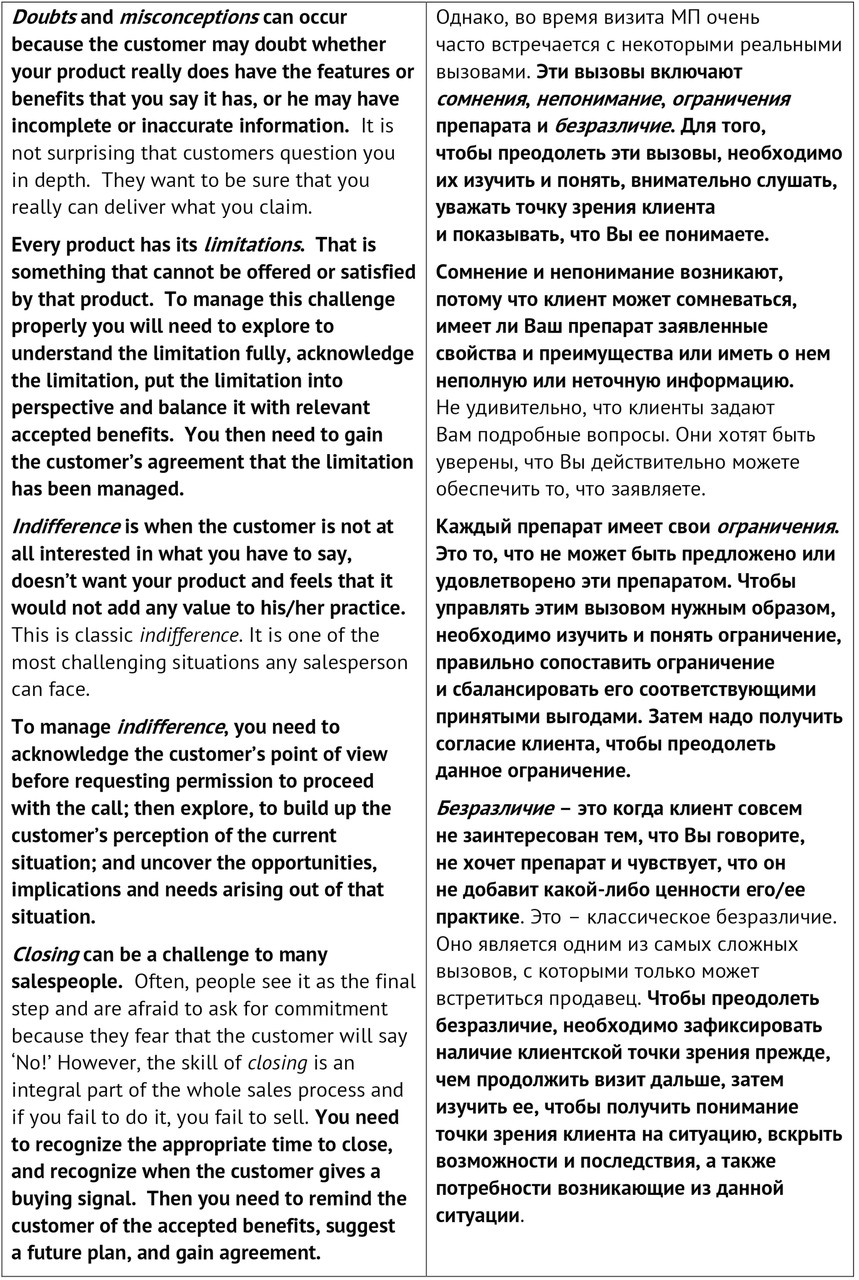
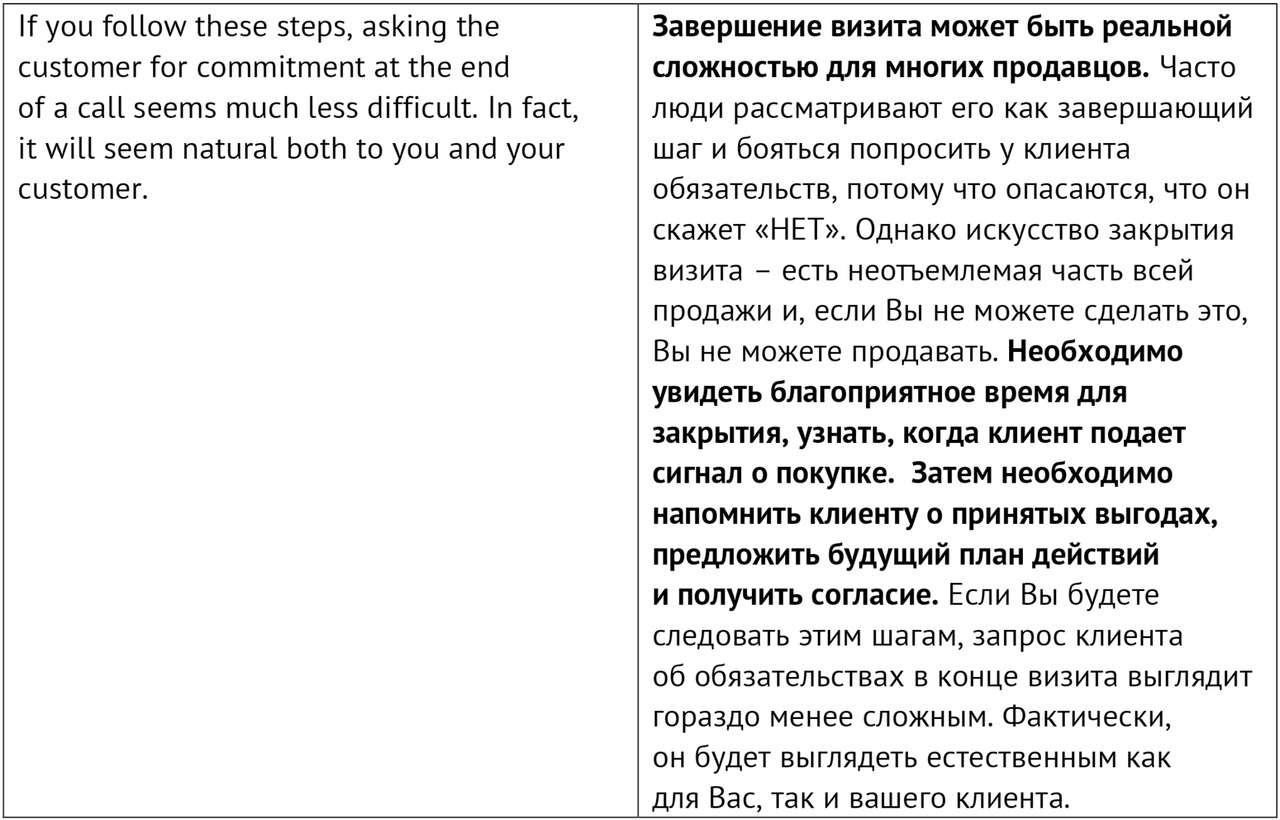
Задание №4: Поставьте повествовательные предложения в: отрицательную форму и в) вопросительную форму:
1. Every Medical Rep must not do some pre-call planning/Must every Medical Rep do some pre-call planning?
2. Good preparation is not more than 50% of the call success/Is good preparation more than 50% of the call success?
3. I don’t want the doctor to try the product you are promoting on a specific group of patients/Do you want the doctor to try the product you are promoting on a specific group of patients?
4. I don’t have in mind how many patients the doctor will try your product on/Do you have in mind how many patients the doctor will try your product on?
5. The sales call objective must not be Timed/Must the sales call objective be Timed?
6. The Sales Rep must not have in mind the time period for the physician to use the new product/Must the Sales Rep have in mind the time period for the physician to use the new product?
7. The doctor will not start to use the new product right away/Will the doctor start to use the new product right away?
8. He should not be able to get the right patients within two weeks/Should he be able to get the right patients within two weeks?
9. An effective Sales Rep must not in advance prepare promotional literature/Must an effective Sales Rep in advance prepare promotional literature?
10. Physicians don’t always like to see proof of the benefits/Do physicians always like to see proof of the benefits?
11. It isn’t important to have a copy of the clinical paper on the comparative study/Is it important to have a copy of the clinical paper on the comparative study?
12. Every sales call doesn’t also need a good opening/Does every sales call also need a good opening?
13. Both the salesperson and the customer won’t gain benefits from the call/Will both the salesperson and the customer gain benefits from the call?
14. The skill of opening won’t enable a Sales Rep to get his customer’s interest/Will the skill of opening enable a Sales Rep to get his customer’s interest?
15. Every customer doesn’t want to see value in spending time with a Sales Rep/Does every customer want to see value in spending time with a Sales Rep?
16. A Sales Rep doesn’t need to recognize the appropriate time to open/Does a Sales Rep need to recognize the appropriate time to open?
17. An effective sales person mustn’t state the purpose of the call/Must an effective sales person state the purpose of the call?
18. He didn’t then explain what the customer would get from the call/Did he then explain what the customer would get from the call?
19. Exploring isn’t the effective skill in selling/Is exploring the effective skill in selling?
20. The Sales Rep hasn’t discovered the customer’s buying needs by asking questions/Has the Sales Rep discovered the customer’s buying needs by asking questions?
21. You can’t make your customer respond freely by asking open questions/Can you make your customer respond freely by asking open questions?
22. I can’t gain «yes’ or «no’ responses by asking closed questions/Can you gain «yes’ or «no’ responses by asking closed questions?
23. The Sales Rep hasn’t proceeded very effectively through the sales call/Has the Sales Rep proceeded very effectively through the sales call?
24. The experienced Sales Rep hasn’t uncovered the customer’s needs/Has the experienced Sales Rep uncovered the customer’s needs?
25. the Sale Rep hasn’t provided the information about the relevant features, advantages and benefits of the product after exploring the customer’s needs/Has the Sale Rep provided the information about the relevant features, advantages and benefits of the product after exploring the customer’s needs?
26. The Sales Rep didn’t face some real challenges during the call/Did the Sales Rep face some real challenges during the call?
27. He didn’t explore challenge and listen carefully/Did he explore challenge and listen carefully?
28. The Sales Rep mustn’t respect the customer’s point of view/Must the Sales Rep respect the customer’s point of view?
29. Doubts and misconceptions can’t occur at every stage of the call/Can doubts and misconceptions occur at every stage of the call?
30. The customer didn’t doubt whether your product really had the features or benefits/Did the customer doubt whether your product really had the features or benefits?
31. The customer didn’t have incomplete or inaccurate information after the call/Did the customer have incomplete or inaccurate information after the call?
32. It isn’t surprising that the customer was questioning you in depth/Is it not surprising that the customer was questioning you in depth?
33. They didn’t want to be sure that you really could deliver what you claimed/Did they want to be sure that you really could deliver what you claimed?
34. Every product doesn’t have its limitations/Does every product have its limitations?
35. A limitation isn’t something that you product can’t offer or satisfy/Is a limitation something that you product can’t offer or satisfy?
36. You won’t need to explore the limitation fully/Will you need to explore the limitation fully?
37. You mustn’t put the limitation into perspective/Must you put the limitation into perspective?
38. He didn’t balance the limitation with relevant accepted benefits/Did he balance the limitation with relevant accepted benefits?
39. He hasn’t gained the customer’s agreement in the end of the call/Has he gained the customer’s agreement in the end of the call?
40. He doesn’t feel that the product will add some value to his practice/Does he feel that the product will add some value to his practice?
41. The Sales Rep hasn’t uncovered all opportunities/Has the Sales Rep uncovered all opportunities?
42. He hasn’t found implications and needs arising out of that situation/Has he found implications and needs arising out of that situation?
43. Many sales Reps aren’t afraid to ask for commitment/Are many sales Reps afraid to ask for commitment?
44. He didn’t fear that the customer would say «No’/Did he fear that the customer would say «No’?
45. The Sales Rep hasn’t failed to close the call/Has the Sales Rep failed to close the call?
46. He didn’t recognize the appropriate time to close during his last call/Did he recognize the appropriate time to close during his last call?
47. The customer hasn’t given a buying signal/Has the customer given a buying signal?
48. The Sales Rep hasn’t reminded the customer of the accepted benefits/Has the Sales Rep reminded the customer of the accepted benefits?
49. You won’t need to suggest an action-plan tomorrow/Will you need to suggest an action-plan tomorrow?
Задание №5: Задайте вопросы к подчеркнутым словам в предложении:
1. Every Medical Rep must do some pre-call planning because good preparation is more than 50% of the call success.
• What Medical Rep must do some pre-call planning because…..?
• Who must do some pre-call planning because…..?
• What must Every Medical Rep do…..?
• Why must every Medical Rep do some pre-call planning?
2. The doctor wants to try the product on a specific group of patients.
• Who wants to try the product on a specific group of patients?
• What does doctor want to try on a specific group of patients?
• On what patients does the doctor to try the product?
3. The Sales Rep aimed high.
• Who aimed high?
• How did the Sales Rep aim?
4. A Sales Rep must have in mind the customer’s profile.
• Who must have in mind the customer’s profile?
• What must a Sales Rep have in mind?
5. The physician started to use the new product to feel some loyalty to it.
• Who started to use the new product to feel some loyalty to it?
• What did the physician start to do?
• What product did the physician start to use?
• Why did the physician start to use the new product?
6. The physician got the right patients within two weeks.
• Who got the right patients within two weeks?
• What patients did the physician get within two weeks?
• Within what time did the physician get the right patients?
7. One month’s initial treatment was enough for the patient to feel some progress.
• What was enough for the patient to feel some progress?
• What initial treatment was enough for the patient to feel some progress?
• For whom was one month’s initial treatment enough to feel some progress?
8. The Sales Rep must in advance prepare promotional literature.
• Who must in advance prepare promotional literature?
• What must the Sales Rep do in advance?
• What must the Sales Rep prepare in advance?
• What literature must the Sales Rep prepare in advance?
9. Physicians always like to see proof of the benefits.
• Who always like to see proof of the benefits?
• What do physicians always like to do?
• What proof do physicians always like to see?
10. It is important to have a copy of the clinical paper for the call.
• What is it important to have for the call?
• What paper is it important to have for the call?
11. Every sales call also needs a good opening.
• What needs a good opening?
• What does every sales call need?
• What opening does every sales call need?
12. Both the salesperson and the customer will gain benefits from the call.
• Who will gain benefits from the call?
• What will both the salesperson and the customer gain from the call?
13. The skill of opening will enable a Sales Rep to get his customer’s interest.
• What will enable a Sales Rep to get his customer’s interest?
• What skill will enable a Sales Rep to get his customer’s interest?
• Whose interest will the skill of opening enable a Sales Rep to get?
14. Every customer wants to see value in spending time with a Sales Rep.
• Who wants to see value in spending time with a Sales Rep?
• What customer wants to see value in spending time with a Sales Rep?
• What does every customer want to do?
• What does every customer want to see?
15. A Sales Rep needs to recognize the appropriate time to open.
• Who needs to recognize the appropriate time to open?
• What does a Sales Rep need?
• What time to open does a Sales Rep need to recognize?
16. An effective sales person must always state the purpose of the call.
• Who must always state the purpose of the call?
• What sales person must always state the purpose of the call?
• What must an effective sales person always state?
• What purpose must an effective sales person always state?
17. He explained what the customer would get from the call.
• Who explained what the customer would get from the call?
• What did he do?
• What did he explain?
18. Exploring is the most effective skill in selling.
• What is the most effective skill in selling?
• Where is exploring the most effective skill?
19. By asking questions, the Sales Rep has discovered the customer’s buying needs.
• Who has discovered the customer’s buying needs?
• How has the Sales Rep discovered the customer’s buying needs?
20. By asking open questions you can make your customer respond freely.
• How can you make your customer respond by asking open questions?
• By asking what questions can you make your customer respond freely?
21. By asking closed questions you can gain «yes» or «no» responses.
• By asking what questions can you gain «yes» or «no» responses?
• What responses can you gain by asking closed questions?
22. The Sales Rep has proceeded very effectively through the sales call.
• Who has proceeded very effectively through the sales call?
• How has the Sales Rep proceeded through the sales call?
23. The experienced Sales Rep has uncovered the customer’s needs.
• Who has uncovered the customer’s needs?
• What Sales Rep has uncovered the customer’s needs?
24. After exploring the customer’s needs the Sale Rep provided the information about the relevant features, advantages and benefits of the product.
• Who provided the information about the relevant features, advantages and benefits of the product after exploring the customer’s needs?
• About what did the Sale Rep provide the information after exploring the customer’s needs?
• When did the Sale Rep provide the information about the relevant features, advantages and benefits of the product?
• About what features, advantages and benefits of the product did Sale Rep provide the information?
25. During the call the Sales Rep faced some real challenges.
• Who faced some real challenges during the call?
• What did the Sales Rep face during the call?
• What challenges did the Sales Rep face during the call?
26. He explored the challenges and listened carefully.
• Who explored the challenges and listened carefully?
• What did he explore?
• How did he listen?
27. The Sales Reps must respect the customer’s point of view.
• Who must respect the customer’s point of view?
• What must the Sales Reps do?
• What must the Sales Reps respect?
• Whose point of view must the Sales Reps respect?
28. Doubts and misconceptions can occur at every stage of the call.
• What can occur at every stage of the call?
• When can doubts and misconceptions occur?
• At what stage of the call can doubts and misconceptions occur?
29. The customer doubted whether your product really had the features or benefits.
• Who doubted whether your product really had the features or benefits?
• What did the customer doubt about?
30. After your call the customer had incomplete or inaccurate information.
• Who had incomplete or inaccurate information after the call?
• After whose call did the customer have incomplete or inaccurate information?
• What information did the customer have after the call?
• When did the customer have incomplete or inaccurate information?
31. It is not surprising that the customer was questioning you in depth.
• Who was questioning you in depth?
• What was the customer doing?
• How was the customer questioning you?
32. They wanted to be sure that you really could deliver what you claimed.
• Who wanted to be sure that you really could deliver what you claimed?
• What did they want to be sure?
33. Every product has its limitations.
• What has its limitations?
• What does every product have?
34. A limitation is something that can be offered or satisfied by that product.
• What is a limitation?
35. You will need to explore the limitation fully.
• Who will need to explore the limitation fully?
• What will you need?
• How will you need to explore the limitation?
36. You must put the limitation into perspective.
• Who must put the limitation into perspective?
• What must put into perspective?
• Where must you put the limitation?
37. He balanced the limitation with relevant accepted benefits.
Who balanced the limitation with relevant accepted benefits?
• What did he balance with relevant accepted benefits?
• With what did he balance the limitation?/What did he balance the limitation with?
• With what benefit did he balance the limitation?/What benefit did he balance the limitation with?
38. In the end of the call he has gained the customer’s agreement.
• Who has gained the customer’s agreement?
• What has he gained in the end of the call?
• Whose agreement has he gained in the end of the call?
39. The customer was not at all interested in what you were saying.
• Who was not at all interested in what you were saying?
• In what wasn’t the customer interested at all?
40. He doesn’t want your product.
• Who doesn’t want your product?
• What doesn’t he want?
• Whose product doesn’t he want?
41. He feels that the product will add some value to his practice.
• Who feels that the product will add some value to his practice?
• What value will he feel the product add to his practice?
• To whose practice will the product add some value?
42. The Sales Rep has uncovered all opportunities.
• Who has uncovered all opportunities?
• What has the Sales Rep done?
• What has the Sales Rep uncovered?
• What opportunities has the Sales Rep uncovered?
43. He has found implications and needs arising out of that situation.
• Who has found implications and needs arising out of that situation?
• What has he found?
• What needs has he found?
44. Many Sales Reps are afraid to ask for commitment.
• Who is afraid to ask for commitment?
• How many Sales Reps are afraid to ask for commitment?
• What are many Sales Reps afraid of?
45. He feared that the customer would say «No!»
• Who feared that the customer would say «No!»?
• What did he fear?
46. The Sales Rep has failed to close the call.
• Who has failed to close the call?
• What has he failed to do?
• What has he failed to close?
47. During his last call he recognized the appropriate time to close.
• Who recognized the appropriate time to close during the last call?
• What did he recognize?
• What time did recognize to close during the last call?
48. The customer has given a buying signal.
• Who has given a buying signal?
• What has the customer done?
• What signal has the customer given?
49. The Sales Rep has reminded the customer of the accepted benefits.
• Who has reminded the customer of the accepted benefits?
• Whom has the customer reminded of the accepted benefits?
• Of what benefits has the Sales Rep reminded the customer?
50. Tomorrow you will need to suggest an action-plan.
• Who will need to suggest an action-plan tomorrow?
• What will you need to do tomorrow?
• What plan will you need to suggest tomorrow?
• When will you need to suggest an action-plan?
Задание 8 b) Письменно переведите предложения на английский язык:
1. She works as a physician. But she doesn’t! She works as a Sales Rep in a pharmaceutical company.
2. Doctor Sergeeva has not returned from from the international congress yet. But she has! She returned a month ago.
3. Andrey Teetov will go to the cycle conference in Turkey. Yes, that is right.
4. Medical Reps usually work in the office. But they don’t! They always work in the field with their customers.
5. Few Medical Reps work in big pharmaceutical companies. It is not correct! Many Medical Reps work in I big pharmaceutical companies.
6. As a rule, Medical Reps don’t have cars. But they do! Medical Reps usually have cars.
7. Medical Reps buy mobile phones for themselves. But they don’t the company buys mobile phones for them.
Задание №12: Письменно, ответьте, что Вы не знаете ответа на заданный вопрос, используя приведенные ниже модели:
• I am afraid I don’t know…
• I am afraid I can’t say…
• I have no idea…
1. I am afraid I don’t know what a special technique is that the Sales Reps use to prepare for the call.
2. I am afraid I can’t say what SMART means.
3. I have no idea what Specific means in SMART.
4. I am afraid I don’t know what Measurable means in SMART.
5. I am afraid I can’t say what Ambitious means in SMART.
6. I have no idea what Timed means in SMART.
7. I am afraid I don’t know why Sales Reps prepare promotional literature for a call.
8. I am afraid I can’t say why a good opening is so important for sales call.
9. I have no idea what the skill of opening enables a Sales Rep.
10. I am afraid I don’t know what the skill of opening includes.
11. I am afraid I can’t say why exploring is the most powerful and effective skill in selling.
12. I have no idea what exploring helps a Sales Rep to discover.
13. I am afraid I don’t know what a Sales Rep can achieve by asking open questions.
14. I am afraid I can’t say what a Sales Rep can achieve by asking close questions.
15. I have no idea what the most effective and well known technique of exploring customer’s needs is.
16. I am afraid I can’t say what SPIN means.
17. I am afraid I can’t say what S means in SPIN.
18. I have no idea what P means in SPIN.
19. I am afraid I don’t know what I means in SPIN.
20. I am afraid I can’t say what N means in SPIN.
21. I have no idea why it is important to ask a customer situation questions.
22. I am afraid I don’t know why it is important to ask a customer problem questions.
23. I am afraid I can’t say why it is important to ask a customer implication questions.
24. I have no idea why it is important to ask a customer navigation questions.
25. I am afraid I don’t know when a Sales Rep must provide the information about the relevant features, advantages and benefits of your product.
26. I have no idea why it is important to provide the information about the relevant features, advantages and benefits of your product.
27. I have no idea what a Sales Rep can achieve by providing the information about the relevant features, advantages and benefits of your product.
28. I am afraid I don’t know what Sales Reps often face during the call.
29. I am afraid I can’t say why Sales Reps often face challanges during the call.
30. I have no idea what challenges include.
31. I am afraid I don’t know what a Sales Rep must do to manage these challenges.
32. I am afraid I can’t say why doubts and misconceptions occur.
33. I have no idea why indifference occur.
34. I am afraid I don’t know why limitations occur.
35. I am afraid I can’t say what a Sales Rep must do to manage the product limitation.
36. I have no idea what it means to balance the limitation with a relevant accepted benefit.
37. I am afraid I don’t know what makes indifference the most difficult challenge for a Sales Rep.
38. I have no idea what a Sales Rep must do to manage a customer indifference.
39. I am afraid I can’t say why closing can be a real challenge for many Sales Reps.
40. I am afraid I don’t know what call closing includes.
41. I have no idea why closing is so important for a sales call.
«Ключ» для проверки контрольной работы по теме №2:
1. I am not sure that every Medical Rep does some pre-call planning.
2. What is a special technique that the Sales Reps use to prepare for the call?
3. What does SMART mean?
4. I am not sure that Sales Reps use promotional literature in every call.
5. Why is a good opening so important for a sales call?
6. What does the skill of opening enable a Sales Rep to do?
7. I am afraid you are wrong when you say that the skill of exploring includes active listening.
8. I don’t agree with you that Sales Reps achieve nothing by asking open questions.
9. What is the most effective and well known technique of exploring customer’s needs?
10. Why is it important to ask a customer problem questions?
11. Why did the Sales Rep provide/present the information about the product before exploring the customer’s needs?
12. I am afraid I don’t know why Sales Reps often face challenges during the call.
13. What do challenges include?
14. What has the Sales Rep done to manage these challenges?
15. Why do doubts and misconceptions occur?
16. How did the Sales Rep manage the product limitation?
17. What makes indifference the most difficult challenge for a Sales Rep?
18. What will you do to manage a customer indifference?
19. Why has he failed to sale?
20. I don’t think closing is so important for a sales call.
Тема №3: Определение менеджером стратегий работы на территории и постановка бизнес цели на основе анализа ее потенциала
Учебный модуль №1. Грамматика:
Модальные глаголы английского языка
Модальность — выражение отношения говорящего к происходящим действиям. Модальные глаголы — одно из средств выражения отношения к происходящему. Модальные глаголы выражают:
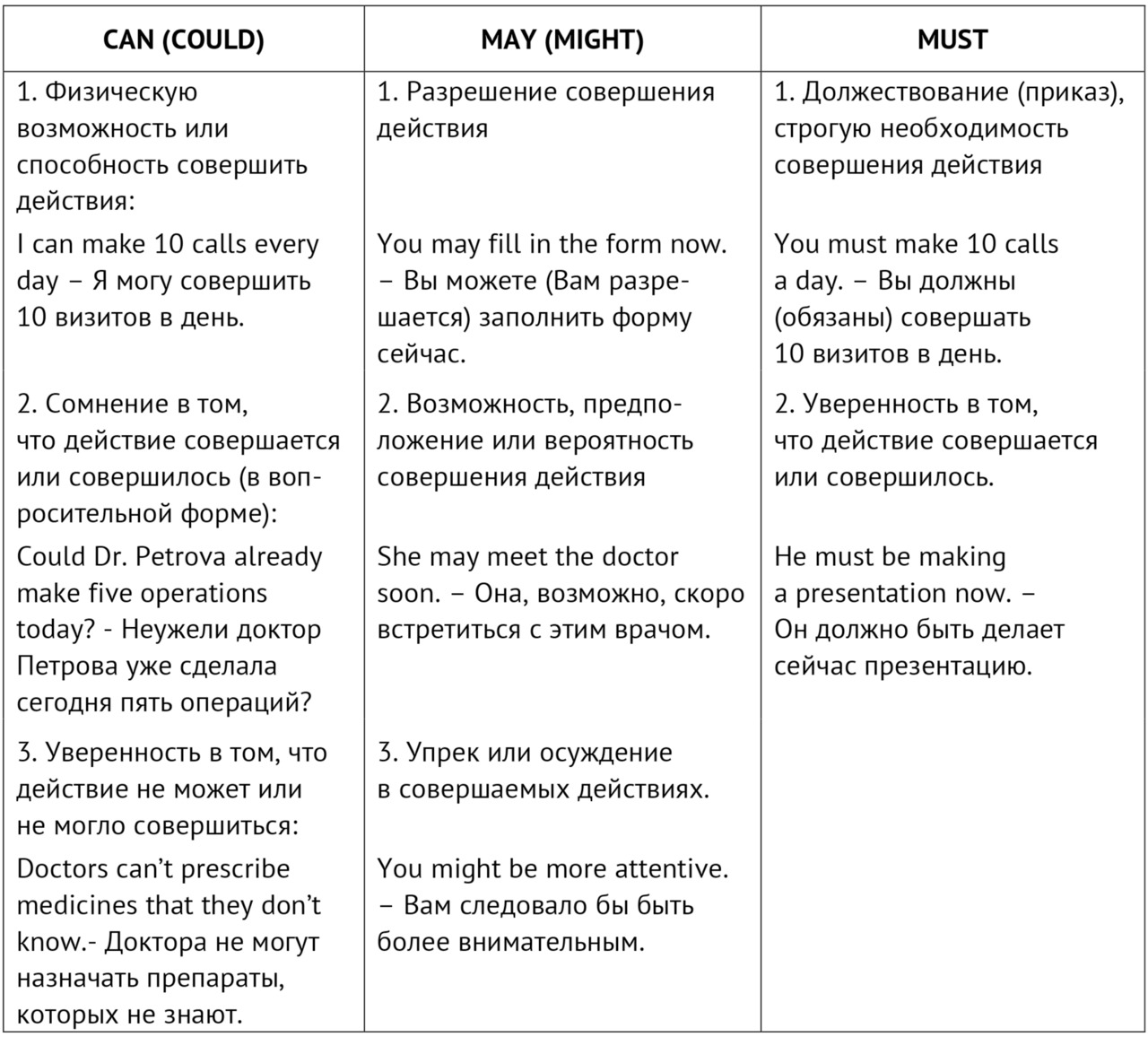
В английском языке модальные глаголы can и must не имеют формы будущего времени.
Значение глагола can в будущем времени передается его эквивалентом to be able to, обозначающим «быть в состоянии сделать что-либо».

Для выражения необходимости совершить какое-либо действие в будущем вместо must употребляется глагол -to have to.

В общении с руководителями следует иметь в виду, что формы прошедшего времени глаголов can = could и may = might не только служат для выражения собственно прошедшего времени, но и используются для придания вашим обращениями и просьбам дополнительной вежливости и большей деликатности.
Например:
Can I take it? Мне можно это взять? (формальная просьба)
Could you do me a favour? Не могли бы Вы оказать мне услугу?
(большая степень вежливости).
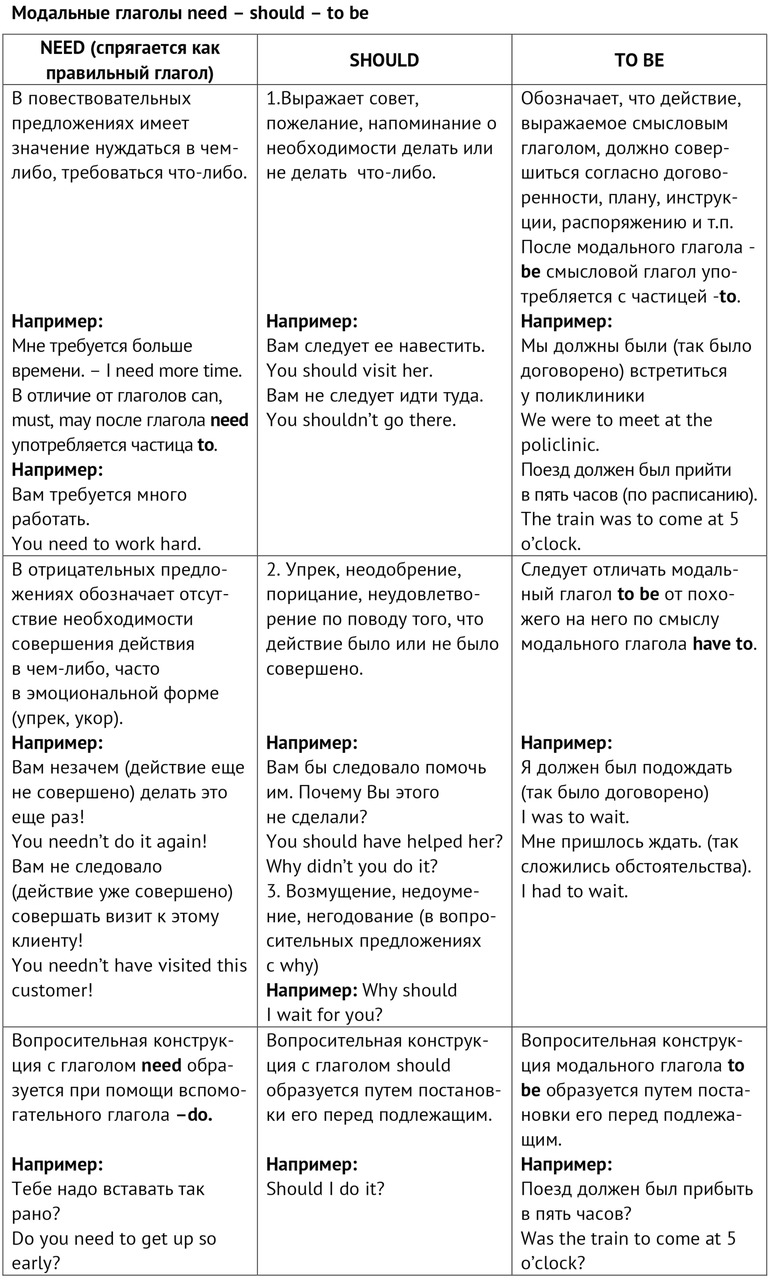
В разговорной речи вместо глагола -have to часто употребляется выражение have got to (с последующим инфинитивом=неопределенной формой глагола), которое обычно передает действие, относящееся к будущему.

Учебный модуль №2. Текст:
Тerritory management: promotional strategies and business objectives
An effective management of the territory for the regional manager starts with an objective evaluation of territory potential. The first thing to do is to compare with each other several key marketing indicators reflecting the territory potential in terms of sales and market share growth. They are:
• relevant* market growth (relevant* means a specific therapy group segment for our product);
• our product sales growth;
• our product market share growth.
Each of the key market indicators mentioned above must be compared in terms of time (for example 2020 vs 2019) and in terms of territory (for example region vs region/or region vs country) for better understanding of a territory potential.
At this stage of territory analysis a regional manager is recommended to use BCG-Matrix (developed by Boston Consulting Group specialists) to visualize potential business strategy for a product/business in a territory (see picture below). A Business Strategy — is a justified concentration of promotional resources to reach the appropriate objectives in the appropriate market environment.
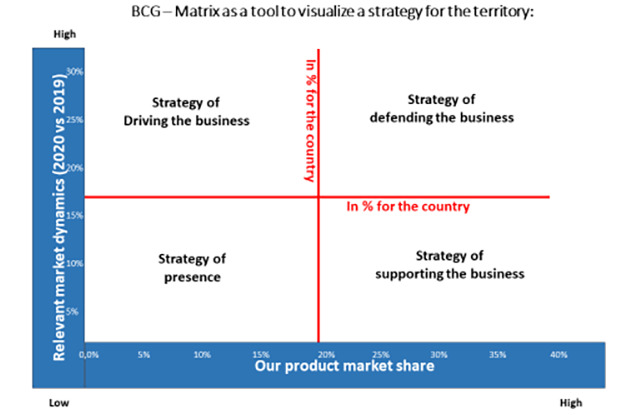
As you can see BCG-Matrix has two scales where a vertical one represents relevant market dynamics in percent (for example, 2020 vs 2019) and horizontal scale represents our product market share (for example, for 2020) also in percent. The lines marked red in the BCG-Matrix dividing it into four segments are relevant market dynamics for the country and our product market share for the country. They give us the benchmark for further analysis of our territory potential vs the country potential.
As you can see in the picture above there are basically four main business strategies for a territory:
1. The strategy of driving the business (upper left segment of BCG-Matrix) is chosen when the relevant business grows up (above the country) while our market share is small (lower than in the country). Under these circumstances, it is reasonable for the company to invest high promotional resources to drive the market share and to boost our sales. The strategy of driving the business requires very high resources because it is aimed at reaching high coverage of A and B customers (with low loyalty to our products) high call frequency and big number of group promotional activities (medical conferences, round table discussions, group presentations). The average balance between individual calls and group promotional activities is not less than 6+2 for each physician where the first number (6) reflects individual calls and the second — participation of each physician in group promotional activities. This balance (6+2) is calculated for a promotional cycle equal to three months.
2. The strategy of defending the business (upper right segment of BCG-Martix) is chosen when the relevant business dynamics in the territory is growing or standing still while our market share is high. In such circumstances our business objective is to aim the necessary promotional resources at active defense of the gained market share against our competitors. The strategy of defending our business means a certain limitation of individual calls to high potential customers with high loyalty to our products in favor of group promotional activities: medical conferences, round table discussions and group presentations. The average balance between individual contacts and participation of customers in group promotional activities does not exceed 2+3 per promotional cycle (three months).
3. The strategy of supporting the business (the low right segment of the BCG-Matrix) is chosen when the relevant business dynamics in the territory is standing still or falling (below country level) while our market share is still high. In such circumstances our business objective is to aim the necessary promotional resources at the defense of the gained market share against our competitors. But unlike previous strategy (=defending business) the strategy of supporting business means even bigger limitation of individual calls to high potential customers with high loyalty to our products in favor of group promotional activities: medical conferences, round table discussions and group presentations. The average balance between individual contacts and participation of customers in group promotional activities does not exceed 1–2+3 per promotional cycle (three months).
4. The strategy of presence in the territory (low left segment of BCG-Matris) is usually chosen when the relevant market in the territory stagnates or is falling while our market share is low. Under these circumstances the investment of significant resources in the territory in terms of return of investment (ROI indicator) is not justified. The objective of this strategy is to limit the promotional resources to a reasonable minimum of less expensive promotional activities to ensure high coverage. When business environment in the territory changes, for example it starts to grow up the business strategy changes accordingly, for example from presence to driving the business. Thus following the strategy of presence the MRs and KAMs call on customers with low coverage and frequency and concentrate their attention to group activities to detail the company products. The average balance between individual contacts and participation of customers in group promotional activities is close to 1+1 or even 0+1.
Sometimes when the regional manager is short of promotional resources and the relevant business dynamics is falling down the company is forced to implement the strategy of withdrawal when MRs and KAMs have to stop calling on potential customers (even A and B categories).
Now when we understand the main business strategies and their objectives and we are fully ready to analyze some particular territory/city business potential. In order to do it let us place some territories/cities business indicators given in the table below into the BCG — Matrix.
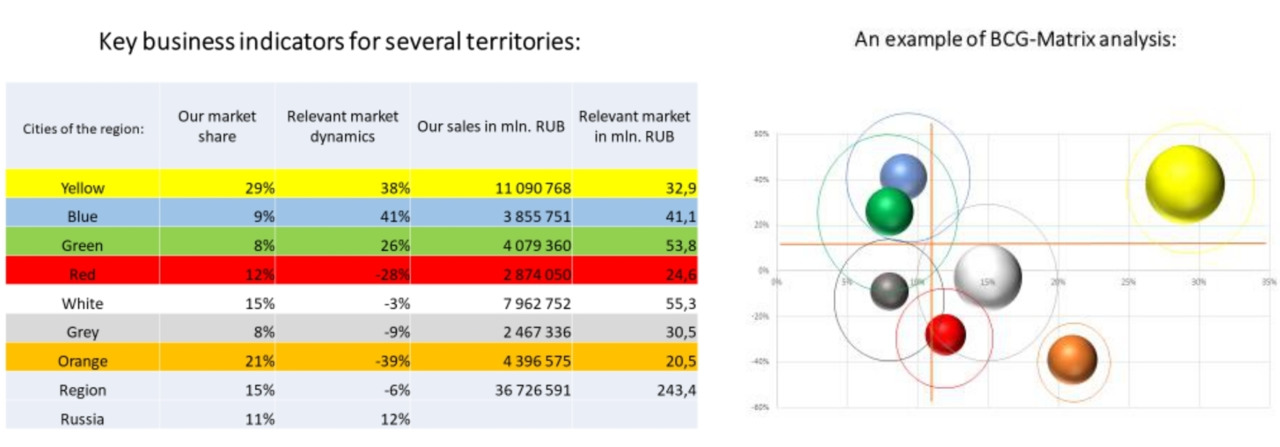
Please be ready to analyze business potential of every city in the BCG-Matrix and give your arguments and proofs presenting their business strategies.
When the strategy for a territory is determined a regional manager can set a business objective for this territory for the next year or promotional cycle. Business objectives are usually set in terms of market share (in percent) and in sales volume (in money/packages).
Let us do it together, for example, for BLUE city. As we can see this city is placed in the upper left segment of the BCG-Matrix which means that it has very high business potential (compared to business potential of the country). Our main conclusions are:
• relevant business dynamics in this city is 3,5 times higher than in the country (41% vs 12%);
• our product market share is less than in the country (9% vs 11%) which means that it can be increased;
• our sales in this city are comparable with sales in GREEN and ORANGE and exceeds our sales in GREY, RED;
• Relevant market in this city exceeds all other citied (even YELLOW one) except WHITE and GREEN (=very big business potential).
If positive tendencies of business development in BLUE city remain (relevant market dynamics growth) the regional manager can set the following business objectives:
• MAX objective in terms of our product market share — to reach 15% of relevant market share;
• MIN objective (if business development in the city is unstable) — to reach 12% of relevant market share.
Now that we know our business objectives in terms of market share and have a forecast for the relevant market for the next year (let’s say +10% growth vs this year = 4,2 mln. RUB) we can easily calculate our MAX sales objectives in BLUE for the next year: 4,2 mln. RUB x 15% = 0,62 mln. RUB. Our MIN sales objectives will be: 4,2 mln. RUB x 12% = 0,5 mln. RUB.
Учебный модуль №3. Новые слова
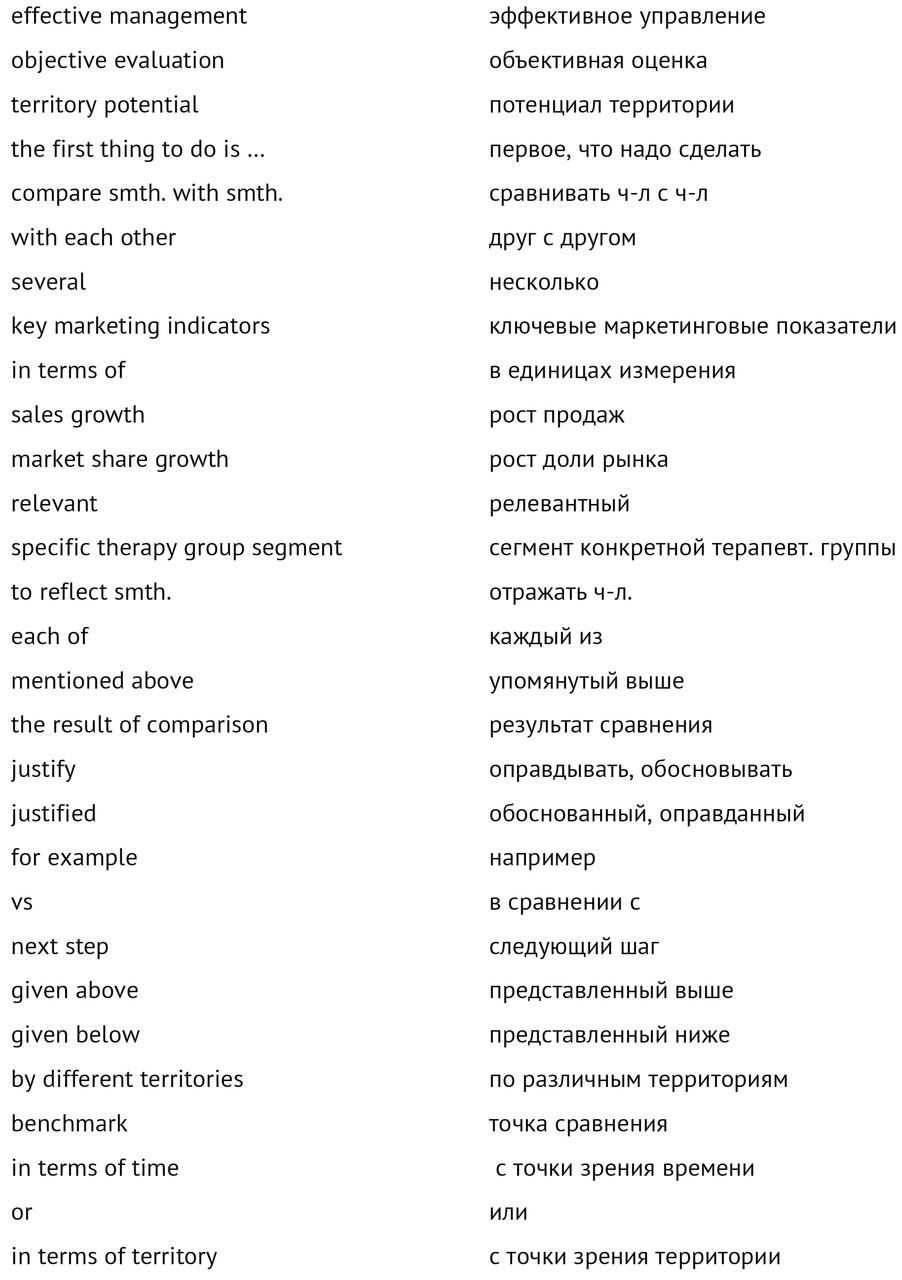
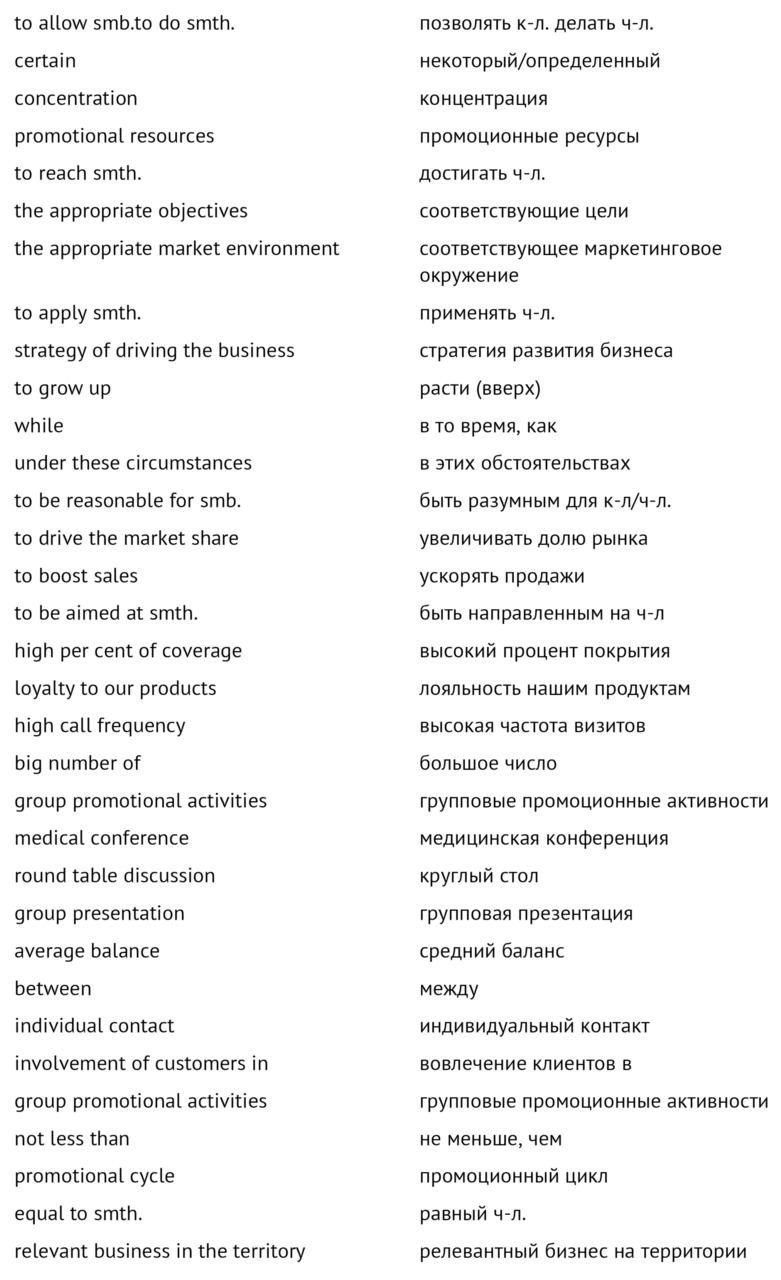
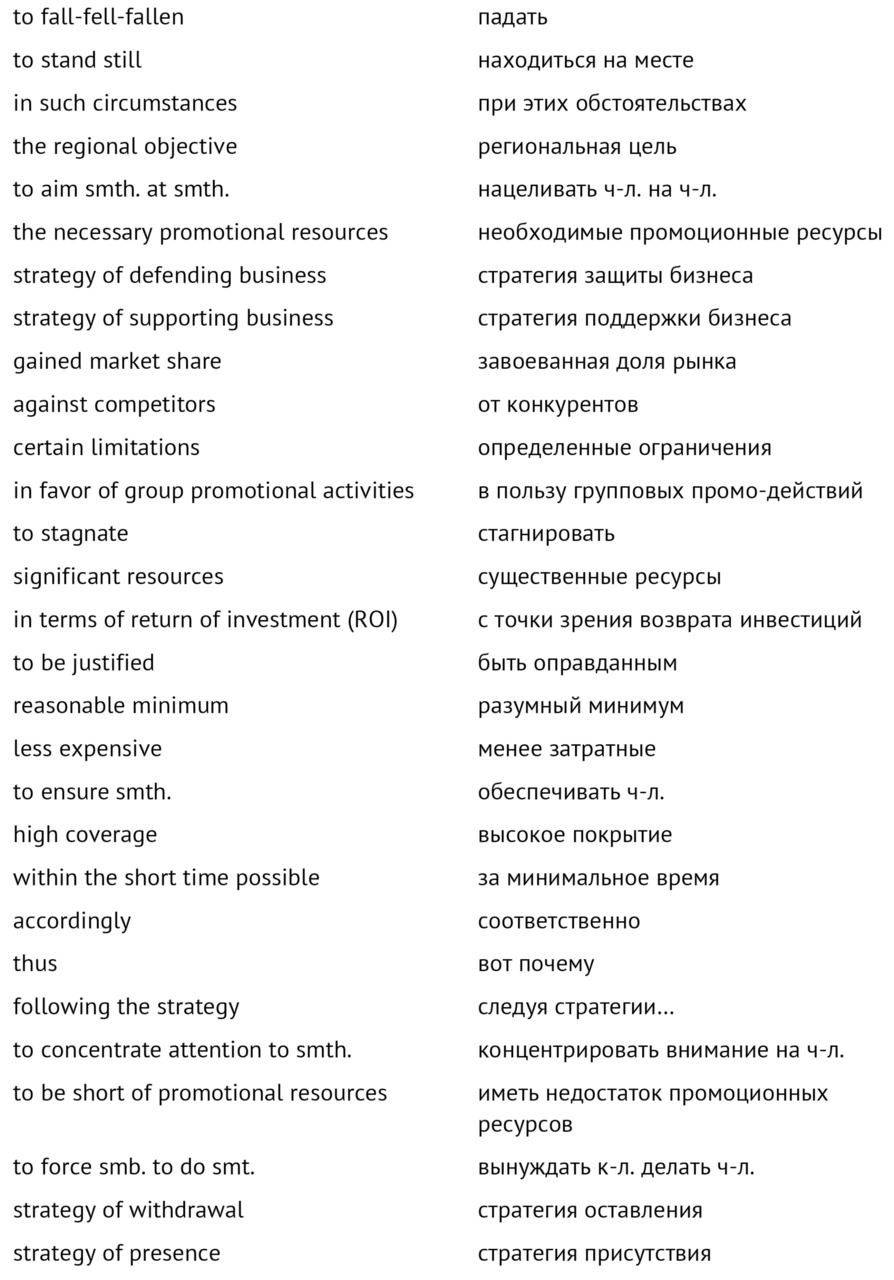
Учебный модуль №4.
Работа над текстом и грамматикой
Задание №1: Прочитайте и переведите текст с опорой на аудиозапись.
Задание №2: Устно ответьте на следующие вопросы с опорой на текст:
1. What is the first step in the territory management?
2. What are the key marketing indicators reflecting the territory potential?
3. How should manager compare the key marketing indicators?
4. What is the result of comparison of key marketing indicators in terms of time (one year vs another)?
5. What is a business strategy?
6. What business strategies do you know?
7. When does a regional manager choose the strategy of driving the business?
8. What is the strategy of driving the business aimed at?
9. What are the main elements of strategy of driving the business?
10. What can you say about the balance between individual contacts and group promotional activities in the strategy of driving the business?
11. In what circumstances is it reasonable for the company to invest high promotional resources in the territory?
12. In what circumstances is it not reasonable for the company to invest high promotional resources in the territory?
13. When is the strategy of defending the business chosen?
14. What is the objective of the strategy of defending the business?
15. What does the strategy of defending the business mean for the regional team?
16. What does the strategy of defending the business mean in terms of promotional activities?
17. What is the average balance between individual contacts and group activities for the strategy of defending the business?
18. Why is the investment of significant resources for the strategy of presence in the territory not justified?
19. What is the main form of promotional activity for the strategy of presence?
20. When does the regional manager start to implement the strategy of withdrawal in the territory?
Задание №3: Устно завершите приведенные ниже фразы с опорой на текст:
1. An effective territory management starts with…
2. For effective territory management the first thing to do is…
3. The key marketing indicators for an effective territory analysis are ….
4. Each of the key market indicators is analyzed in terms…
5. To visualize a potential business strategy for a product/business in a territory managers are recommended…
6. BCG-Matrix was developed by…
7. A Business Strategy — is…
8. Two main scales of the BCG-Matrix represent…
9. The lines marked red in the BCG-Matrix show…
10. Each of the four segment of the BCG-Matrix…
11. The main business strategies for a territory are…
12. An important benchmark for business potential analysis…
13. The strategy of driving the business is chosen when…
14. For the strategy of driving the business it is reasonable…
15. The strategy of driving the business is aimed at…
16. The average balance between individual calls and group promotional activities for the strategy of driving the business…
17. This balance (6+2) is given for…
18. The strategy of defending the business is chosen when…
19. For the strategy of defending the business it is reasonable…
20. The strategy of defending the business is aimed at…
21. The average balance between individual calls and group promotional activities for the strategy of defending the business…
22. The strategy of supporting business means…
23. Sometimes when the regional manager is short of promotional resources and the relevant business dynamics is falling down…
24. If you want to analyze some real territory potential and business strategy…
25. A regional manager sets business objective for this territory for…
26. Business objectives are usually set in terms of…
27. A regional manager sets MAX objectives for the territory when…
28. A regional manager set MIN objectives for the territory when…
29. A regional manager first sets objectives …. and then ….
30. Sales objectives can easily be calculated…
Задание №4: Устно прореагируйте на следующие реплики. Исправьте утверждения, не соответствующие содержанию текста:
1. An effective territory management starts with deep business analysis.
2. For effective territory management the first thing to do is to get a marketing forecast.
3. The key marketing indicators for an effective territory analysis are relevant market and our product sales.
4. Each of the key market indicators is analyzed in terms of time (year vs year) and in terms of territory (a smaller territory vs a bigger territory).
5. To visualize potential business strategy for a product/business in a territory managers are recommended to analyze a market forecast.
6. BCG-Matrix was developed by a group of American market specialists.
7. A Business Strategy is a process of setting business objective for some territory.
8. Two main scales of the BCG-Matrix represent relevant market and our sales.
9. The lines marked red in the BCG-Matrix show average country indicators.
10. Each of the four segment of the BCG-Matrix represents some business strategy.
11. The main business strategies for a territory are the strategy of attack and the strategy of defense.
12. The strategy of driving the business is chosen when the relevant business falls down and our market share is high.
13. For the strategy of driving the business it is reasonable to save resources.
14. The strategy of driving the business is aimed at increasing our market share.
15. The average balance between individual calls and group promotional activities for the strategy of driving the business should be about 3+3.
16. The strategy of defending the business is chosen when the company needs to keep our market share.
17. For the strategy of defending the business it is reasonable to invest a lot of resources in the territory.
18. The strategy of defending the business is aimed at increasing our market share.
19. The average balance between individual calls and group promotional activities for the strategy of defending the business is about 6+2.
20. The strategy of supporting business means that we make emphasis on group promotional activities.
21. Sometimes when the regional manager is short of promotional resources and the relevant business dynamics is falling down the company can implement the strategy of driving the business.
22. If you want to analyze some real territory potential and business strategy you need reliable information.
23. A regional manager sets business objective for this territory for the period of three months.
24. Business objectives are always set in terms of sales/money.
25. A regional manager first sets objectives in terms of sales and only then in terms of market share.
Задание №5: Письменно поставьте повествовательные предложения в отрицательную и вопросительную форму:
1. An effective territory management starts with deep business analysis.
2. The regional manager has analyzed the key marketing indicators for a business strategy.
3. All key market indicators must be analyzed in terms of time (year vs year) and in terms of territory.
4. BCG Matrix is recommended to visualize potential business strategy for a product/business.
5. BCG-Matrix was developed by a group of Canadian market specialists.
6. A Business Strategy is a process of setting business objective and calculating promotional resources for the territory.
7. Two main scales of the BCG-Matrix represent relevant market and our product market share.
8. The lines marked red in the BCG-Matrix show the average country indicators in relevant market dynamics and in our product market share.
9. Each of the four segment of the BCG-Matrix represents some business strategy.
10. The most ambitious business strategy for a territory is the strategy of driving the business.
11. The strategy of driving the business is chosen when the relevant business grows and our market share is small.
12. For the strategy of driving the business it is reasonable to invest a lot of resources.
13. The strategy of driving the business is aimed at increasing our market share.
14. The average balance between individual calls and group promotional activities for the strategy of driving the business should be about 6+3.
15. The strategy of defending the business is chosen when the company needs to keep our market share.
16. The average balance between individual calls and group promotional activities for the strategy of defending the business is about 3+3.
17. The strategy of supporting business means that we make emphasis on group promotional activities.
18. Our company is ready to implement the strategy of driving the business.
19. You need reliable information.
20. A regional manager sets business objective for this territory for the period of three months.
21. Business objectives are always set in terms of sales and money.
22. A regional manager first sets objectives in terms of sales.
Задание №6: Письменно задайте вопросы к подчеркнутым словам в предложении:
1. An effective territory management starts with deep business analysis.
2. The regional manager has analyzed the key marketing indicators for a business strategy.
3. All key market indicators must be analyzed in terms of time (year vs year) and in terms of territory.
4. BCG Matrix is recommended to visualize potential business strategy for a product/business.
5. BCG-Matrix was developed by a group of Canadian market specialists.
6. Two main scales of the BCG-Matrix represent relevant market and our product market share.
7. The lines marked red in the BCG-Matrix show the average country indicators in relevant market dynamics and in our product market share.
8. Each of the four segment of the BCG-Matrix represents some business strategy.
9. The strategy of driving the business is chosen when the relevant business grows and our market share is small.
10. For the strategy of driving the business it is reasonable to invest a lot of resources.
11. The strategy of driving the business is aimed at increasing our market share.
12. The average balance between individual calls and group promotional activities for the strategy of driving the business should be about 6+3.
13. The strategy of defending the business is chosen when the company needs to keep our market share.
14. The strategy of supporting business means that we should make emphasis on group promotional activities.
15. Our company is ready to implement the strategy of driving the business.
16. You need reliable information.
17. A regional manager sets business objective for this territory for the period of three months.
18. Business objectives are always set in terms of sales and money.
19. A regional manager first sets objectives in terms of sales.
Учебный модуль №5.
Слова и выражения для диалогов по теме
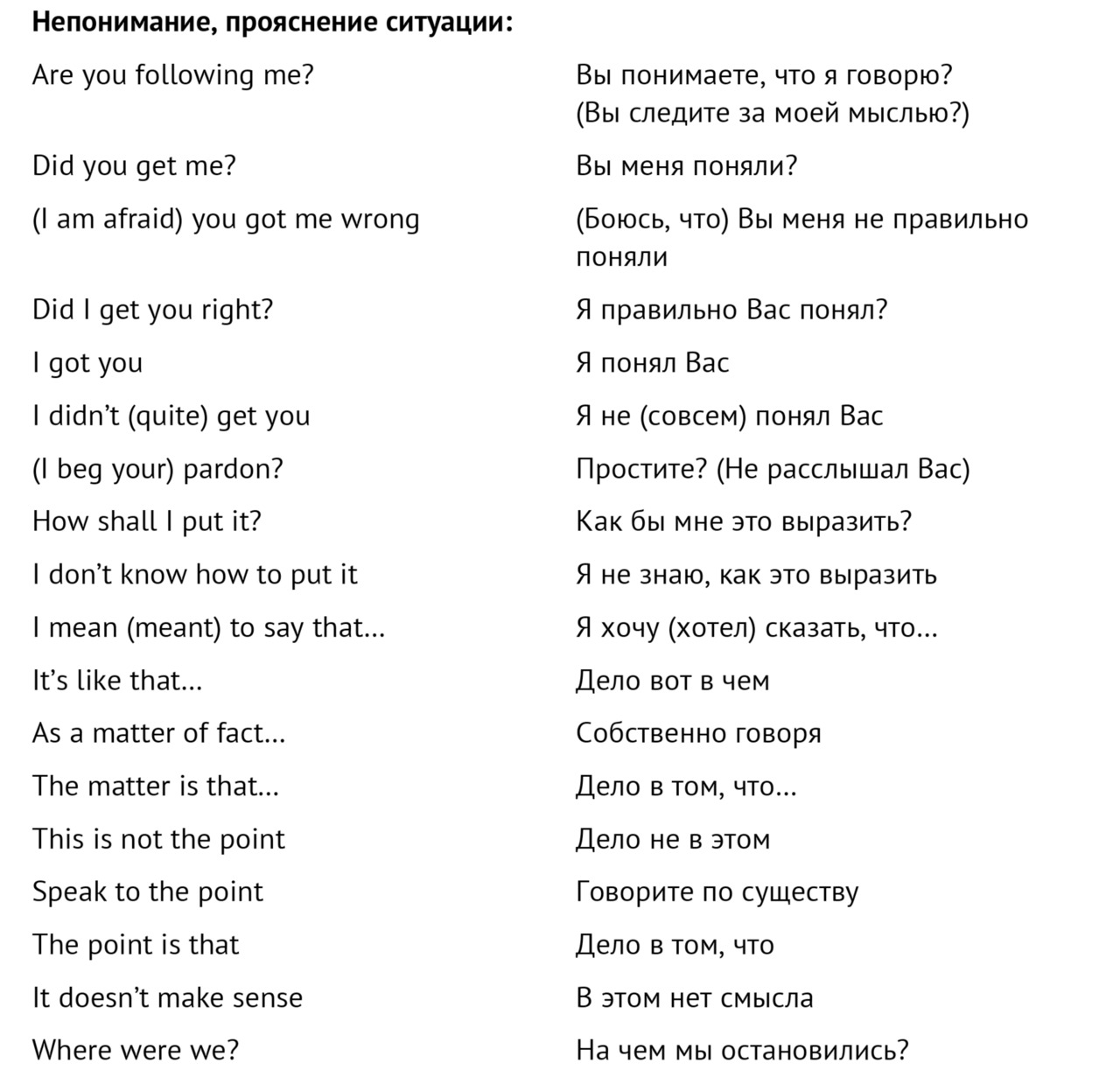
Задание №8: Устно ответьте на вопросы, используя фразы в скобках:
1. Did you get me? (Yes, I got you. No, I didn’t get you. I’m afraid not. I don’t think I did. Not at all. Yes, certainly.)
2. Did I get you right? (Not quite. I don’t think you did. Quite right. No, I am afraid you got me wrong. I believe so. Looks like that. No, this is not the point.)
3. Are you following me? (Yes, certainly. I think so. I don’t think I am. I’m afraid not. Not quite.
4. Where were we? (You were telling me about… You were speaking about… I was telling you about… We were discussing …You were going to say something about…)
Задание №9: Отвечая устно на приведенные ниже высказывания, используйте следующие фразы:
I mean to say that… It’s like this…
I meant to say that… As a matter of fact…
The matter is that…
1. I’m afraid I didn’t get you.
2. Did I get you right?
3. I beg your pardon?
4. Pardon?
5. I didn’t quite get you.
6. I am afraid it doesn’t make sense to me.
Задание №10: Подберите устно соответствующие друг-другу высказывания в различных частях таблицы. Закончите фразы в правой колонке:

Задание №11: Письменно приведите высказывания, соответствующие следующим фразам:
Model: …you didn’t understand the person you are talking to?
If I didn’t understand the person I am talking to I would say: I beg your pardon?
…you want someone to repeat what he said because you didn’t understand (hear it)?
…you are not sure the person you are talking to understands what you are saying?
…you want somebody to give additional explanation?
…you don’t remember what you were talking about when you were interrupted?
…you don’t know how to express some idea?
Задание №12: Письменно переведите следующие предложения на английский язык:
1. Андрей Титов — хороший медицинский представитель. Я в этом с Вами совершенно согласен.
2. Он часто работает в офисе. Я в этом с Вами не согласен, потому что Андрей всегда работает в «поле».
3. Я думаю, что презентация займет (will take) около получаса. Вы правы.
4. Могу ли я доехать (get …) до поликлиники автобусом? Конечно.
5. Мы будем работать на выставке? Само собой разумеется.
6. У нас достаточно времени еще на один визит? Совсем нет.
7. Это так трудно. Наоборот, это очень легко.
8. Сегодня вторник. Простите, но сегодня среда.
9. Когда состоится цикловая конференция компании? Понятия не имею.
10. Доктор выписал несколько рецептов. Похоже на то.
11. Я правильно Вас понял? Боюсь, что нет. Я хотел сказать, что это невозможно.
12. Боюсь, что я Вас не понял. Говорите, пожалуйста, по существу.
13. Простите (я Вас не расслышал)? Собственно говоря, это не так важно.
14. На чем мы остановились? Вы говорили мне о своих планах на следующую неделю.
15. Простите, я Вас не понял. Ну, как бы это сказать. Дело в том, что все это довольно необычно.
16. Это не имеет смысла. Пожалуйста, говорите по существу.
17. Вы знаете, что он хотел сказать? Да, дело в том, что он нашел несколько новых медицинских учреждений на своей территории.
18. Не знаю, как это выразить. В сущности говоря, он прав.
19. Не в этом дело. Дело в следующем.
Задание №13: С опорой на новые слова подготовьте краткий диалог (3–4 вопроса/ответа) на тему: Матрица BCG — инструмент для выбора стратегии бизнеса на территории.
Задание №14: С опорой на новые слова подготовьте краткий диалог (3–4 вопроса/ответа) на тему: Основные бизнес условия для выбора стратегии развития бизнеса на территории.
Задание №15: С опорой на новые слова подготовьте краткий диалог (3–4 вопроса/ответа) на тему: Как поставить бизнес цель для территории в рамках выбранной промоционной стратегии.
Учебный модуль №6.
Контрольная работа по теме №3
Задание: Письменно переведите предложения на английский язык
1. Вам следует начать анализ с объективной оценки потенциала территории.
2. Чтобы понять динамику, ему пришлось сравнить два бизнес индикатора территории по времени (2019 с 2020).
3. Чтобы визуализировать потенциальную бизнес стратегию по продукту/бизнесу на территории, Вы можете использовать BCG-Матрицу.
4. Бизнес стратегия — это обоснованная концентрация промоционных ресурсов для достижения соответствующих целей в соответствующих рыночных условиях. Я полностью с Вами здесь согласен!
5. Как Вы видите, в этих условиях нам придется выбрать стратегию защиты нашего бизнеса, потому что наша доля рынка — высокая, а рынок падает.
6. Дело в том, что на растущем рынке для компании разумно инвестировать большие промоционные ресурсы, чтобы увеличить долю рынка и ускорить рост продаж.
7. В сущности, средний баланс между индивидуальными контактами с врачами и их участием в групповых промоционных активностях не должен превышать 2+3 для промоционного цикла.
8. Если у менеджера не хватает промоционных ресурсов на территории он/она может (им позволено) выбрать стратегию сворачивания бизнеса.
9. Почему она не смогла проанализировать и представить потенциал территории?
10. Если позитивные тенденции развития бизнеса в городе СИНИЙ сохраняться, менеджер может поставить территориальной команде очень амбициозные задачи.
11. Нам необходимо выбрать стратегию развития бизнеса для города СИНИЙ. Я в этом с Вами полностью согласен!
12. Чтобы реализовать эту стратегию, мне необходимо много промоционных ресурсов. — Само собой разумеется!
13. Я правильно Вас понял? Вы пытаетесь (to try) сказать, что мы должны прекратить нашу промоционную активность на этой территории?
14. Боюсь, что Вы меня не правильно поняли. Я не могу дать Вам дополнительные ресурсы для этой территории.
15. Я имею в виду, что наша команда не сможет добиться амбициозных целей без дополнительных промоционных ресурсов.
16. Ваш анализ не имеет смысла! — Нет, имеет.
17. Я не понял Вас. Вы его защищаете? — Совсем наоборот!
18. Я правильно Вас понял? — Боюсь, что нет. Я имею в виду, что не могу помочь Вам с промоционными ресурсами.
19. Боюсь, что я Вас не понял. Пожалуйста, говорите по существу!
20. Не знаю, как это выразить. В сущности, он — прав!
Учебный модуль №7. «Ключи» для проверки правильности выполнения заданий
Работа с текстом: перевод и заучивание (выделено жирным шрифтом)
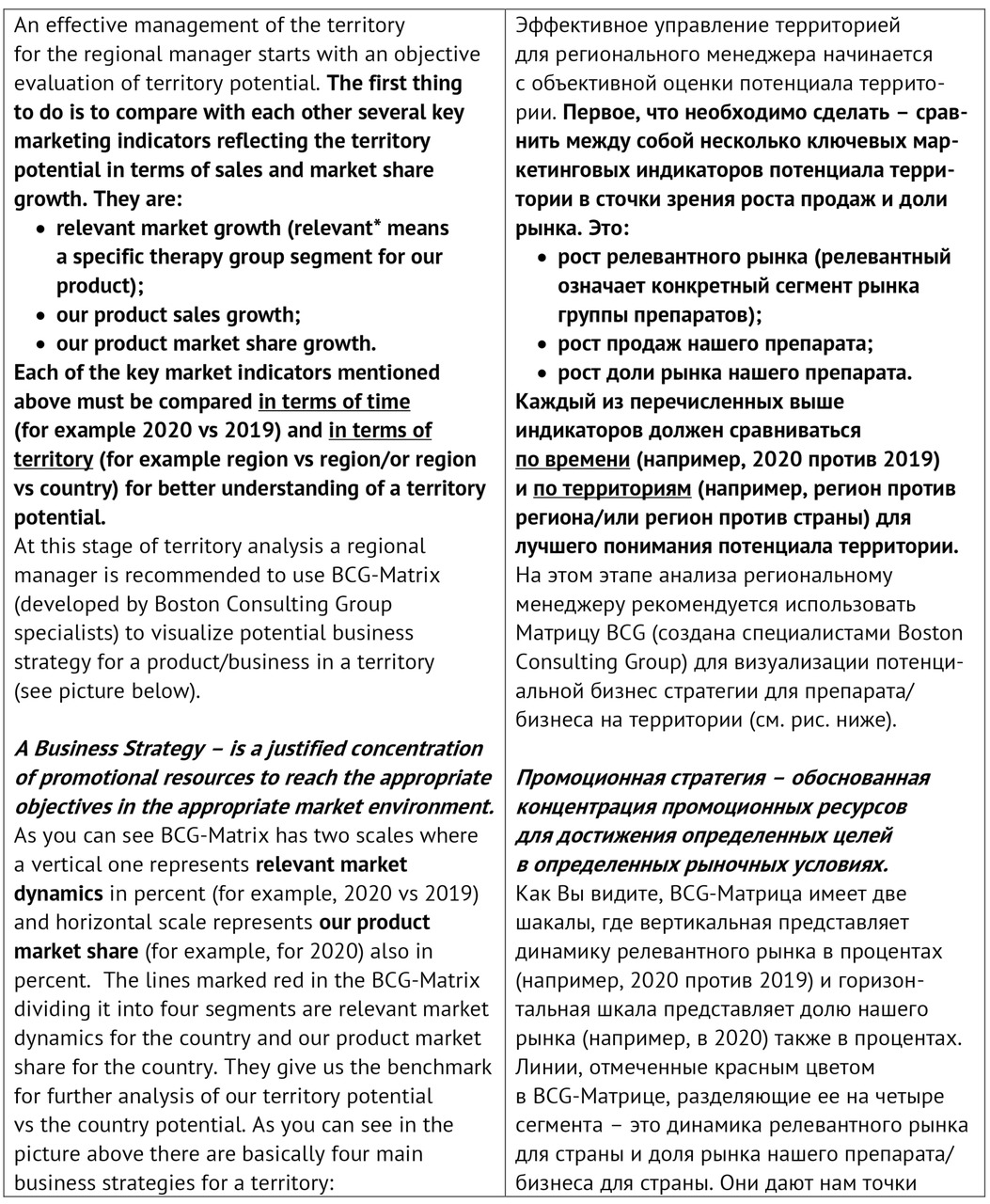
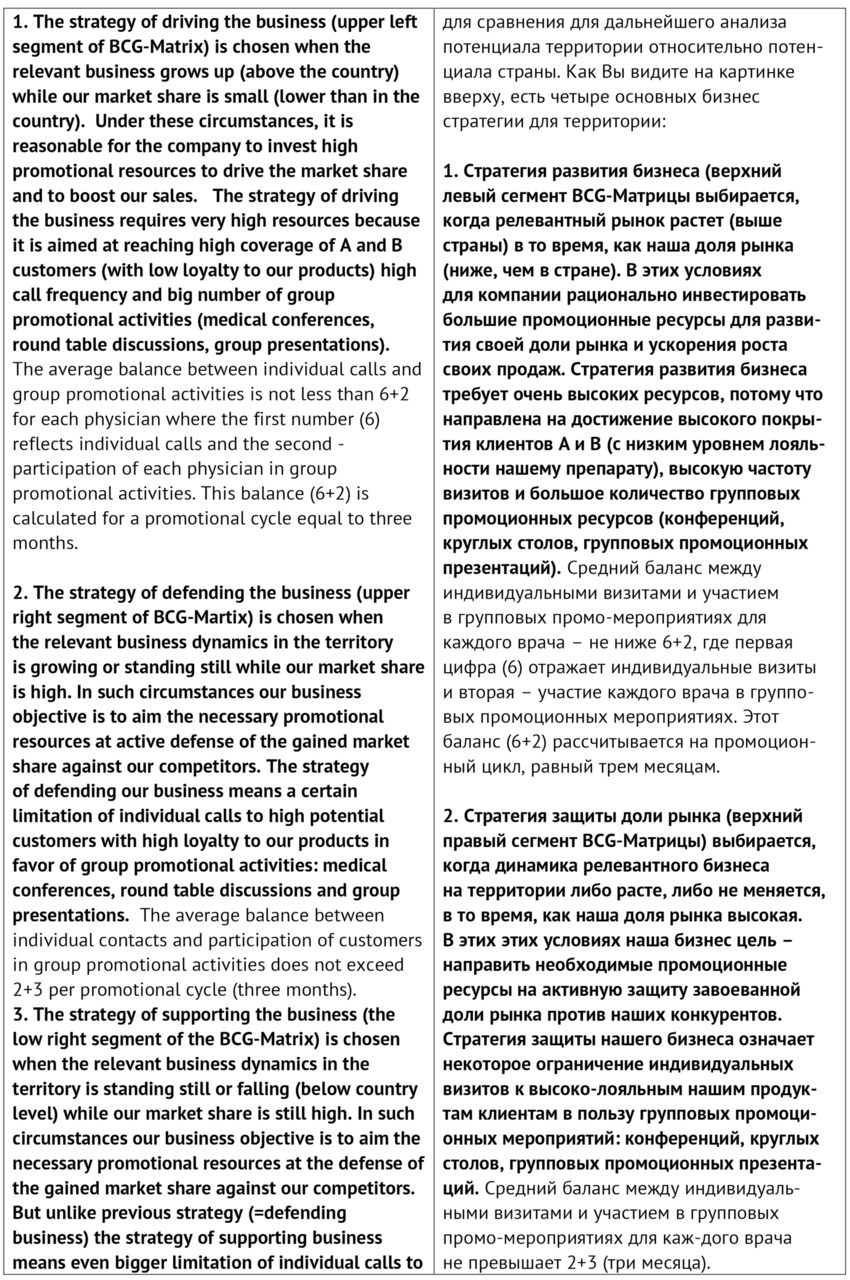
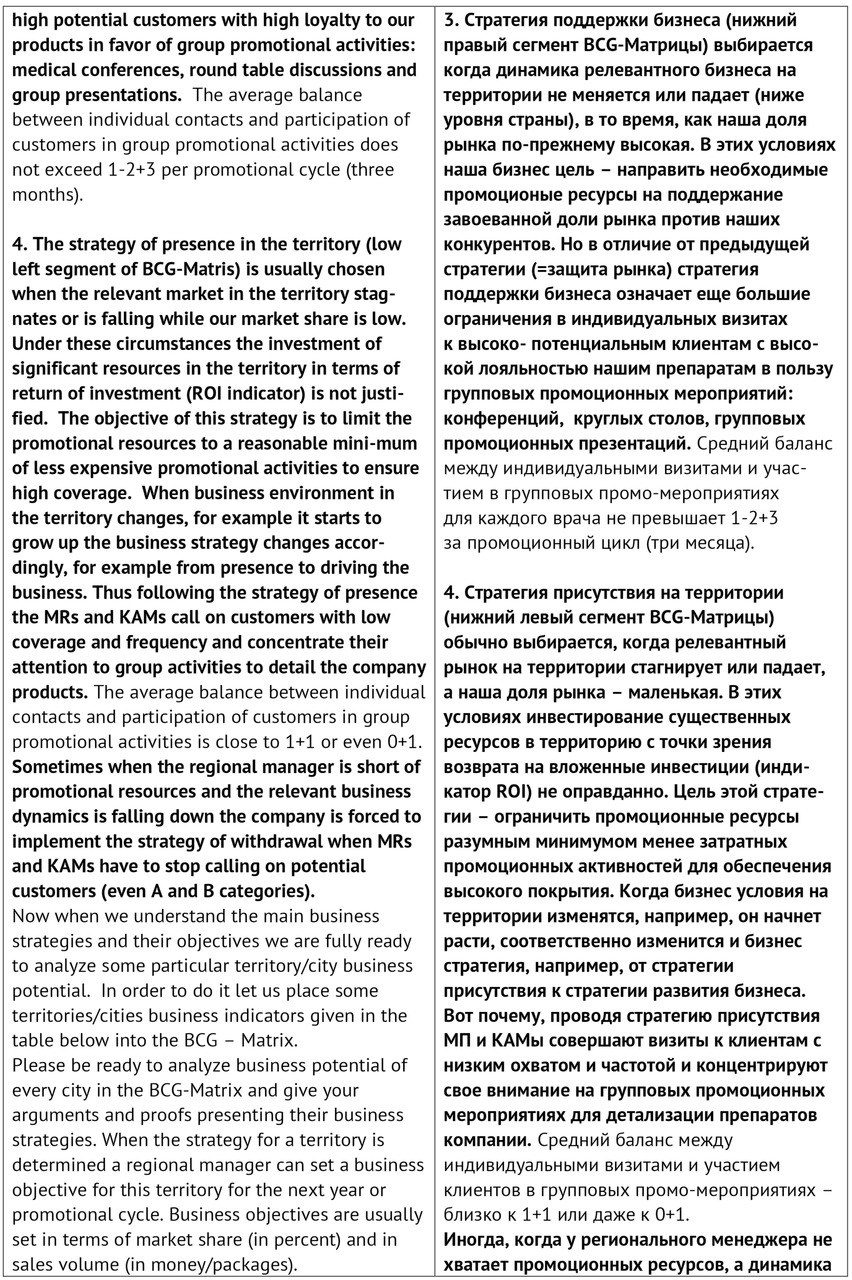
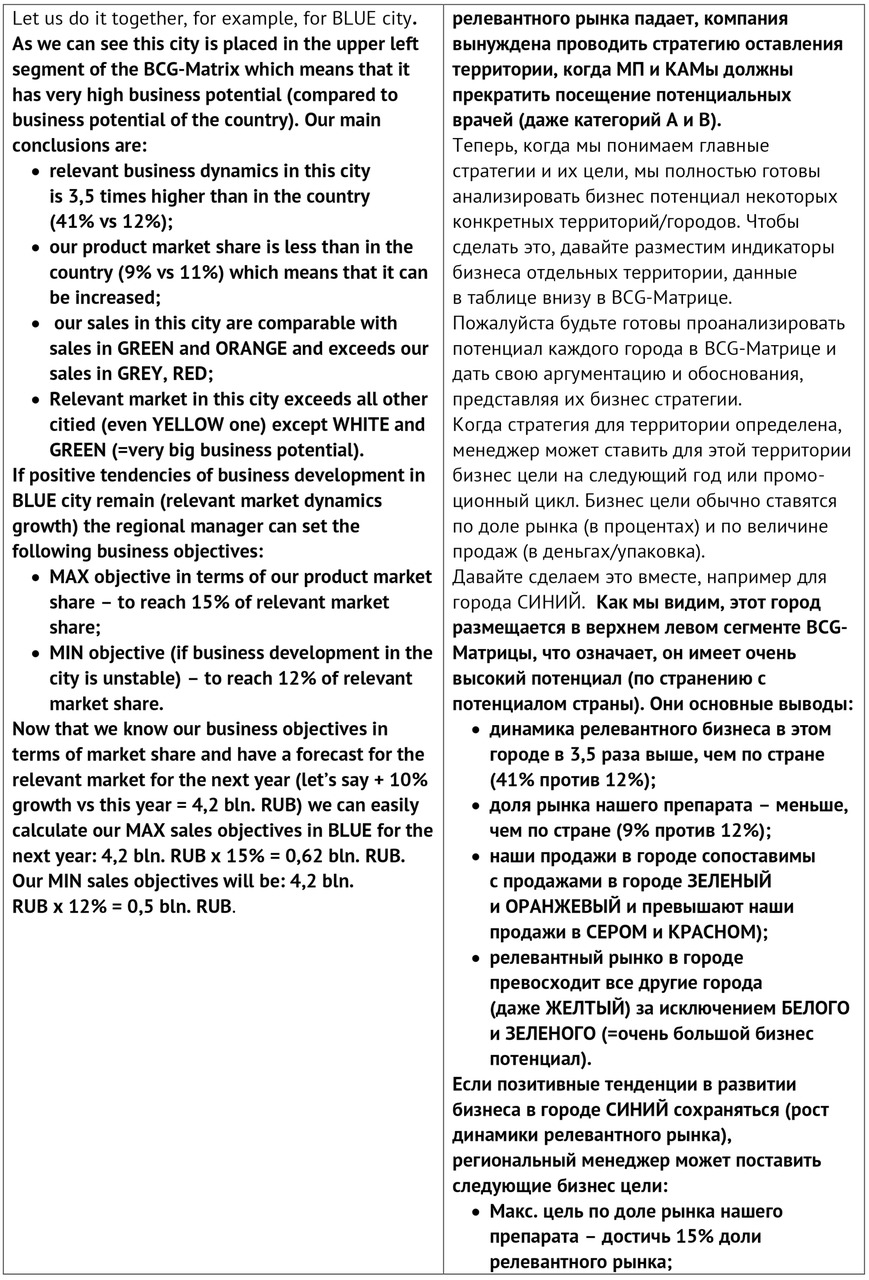
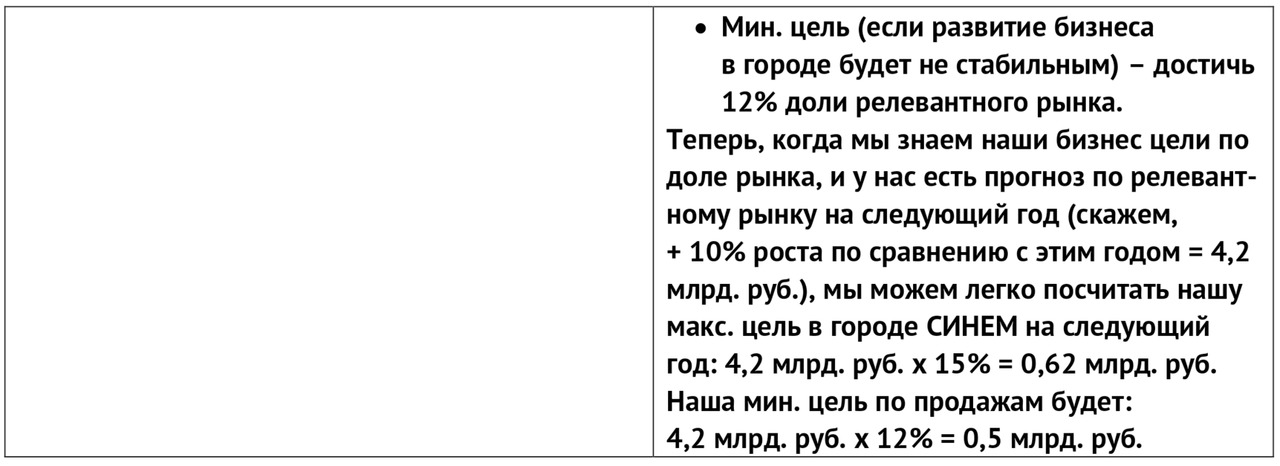
Задание №5: Письменно поставьте повествовательные предложения в отрицательную и вопросительную форму:
1. An effective territory management doesn’t start with deep business analysis/Does an effective territory management start with deep business analysis?
2. The regional manager hasn’t analyzed the key marketing indicators for a business strategy/Has the regional manager analyzed the key marketing indicators for a business strategy?
3. All key market indicators mustn’t be analyzed in terms of time (year vs year) and in terms of territory/ Must all key market indicators be analyzed in terms of time (year vs year) and in terms of territory?
4. BCG Matrix isn’t recommended to visualize potential business strategy for a product/business/ Is BCG Matrix recommended to visualize potential business strategy for a product/business?
5. BCG-Matrix wasn’t developed by a group of Canadian market specialists/Was BCG-Matrix developed by a group of Canadian market specialists?
6. A Business Strategy is not a process of setting business objective and calculating promotional resources for the territory/ Is Business Strategy a process of setting business objective and calculating promotional resources for the territory?
7. Two main scales of the BCG-Matrix don’t represent relevant market and our product market share/Do two main scales of the BCG-Matrix represent relevant market and our product market share?
8. The lines marked red in the BCG-Matrix don’t show the average country indicators in relevant market dynamics and in our product market share/Do the lines marked red in the BCG-Matrix show the average country indicators in relevant market dynamics and in our product market share?
9. Each of the four segment of the BCG-Matrix doesn’t represent some business strategy/ Does each of the four segment of the BCG-Matrix represent some business strategy?
10. The most ambitious business strategy for a territory isn’t the strategy of driving the business/Is the most ambitious business strategy for a territory the strategy of driving the business?
11. The strategy of driving the business isn’t chosen when the relevant business grows and our market share is small/ Is the strategy of driving the business chosen when the relevant business grows and our market share is small?
12. For the strategy of driving the business it is not reasonable to invest a lot of resources/ Is it reasonable to invest a lot of resources for the strategy of driving the business?
13. The strategy of driving the business is not aimed at increasing our market share/ Is the strategy of driving the business aimed at increasing our market share?
14. The average balance between individual calls and group promotional activities for the strategy of driving the business should not (=shouldn’t) be about 6+3/Should the average balance between individual calls and group promotional activities for the strategy of driving the business be about 6+3?
15. The strategy of defending the business is not chosen when the company needs to keep our market share/ Is the strategy of defending the business chosen when the company needs to keep our market share?
16. The average balance between individual calls and group promotional activities for the strategy of defending the business isn’t about 3+3/ Is the average balance between individual calls and group promotional activities for the strategy of defending the business about 3+3?
17. The strategy of supporting business doesn’t mean that we make emphasis on group promotional activities/ Does the strategy of supporting business mean that we make emphasis on group promotional activities?
18. Our company isn’t ready to implement the strategy of driving the business/ Is our company ready to implement the strategy of driving the business?
19. You don’t need reliable information/Do you need reliable information?
20. A regional manager doesn’t set business objective for this territory for the period of three months/Does a regional manager set business objective for this territory for the period of three months?
21. Business objectives are not always set in terms of sales and money/ Are business objectives always set in terms of sales and money?
22. A regional manager doesn’t first set objectives in terms of sales/ Does a regional manager first set objectives in terms of sales?
Задание №6: Письменно задайте вопросы к подчеркнутым словам в предложении:
1. An effective territory management starts with deep business analysis.
• Who starts an effective territory management with deep business analysis?
• What management starts with deep business analysis?
• With what business analysis does an effective territory management start?
2. The regional manager has analyzed the key marketing indicators for a business strategy.
• Who has analyzed the key marketing indicators for a business strategy?
• What manager has analyzed the key marketing indicators for a business strategy?
• What has the manager done?
• What has the regional manager analyzed?
• What strategy has the regional manager analyzed?
3. All key market indicators must be analyzed in terms of time (year vs year) and in terms of territory.
• What must be analyzed in terms of time (year vs year) and in terms of territory?
• What indicators must be analyzed in terms of time (year vs year) and in terms of territory?
• How must all key market indicators be analyzed?
4. BCG Matrix is recommended to visualize potential business strategy for a product/business.
• What is recommended to visualize potential business strategy for a product/business?
• What Matrix is recommended to visualize potential business strategy for a product/business?
• Why is BCG Matrix is recommended?
5. BCG-Matrix was developed by a group of Canadian market specialists.
• What was developed by a group of Canadian market specialists?
• By what group of specialists was BCG-Matrix developed?
6. Two main scales of the BCG-Matrix represent relevant market and our product market share.
• What represents relevant market and our product market share?
• What scales represent relevant market and our product market share?
• What do two main scales of the BCG-Matrix represent?
• What market share do two scales of the BCG-Matrix represent?
7. The lines marked red in the BCG-Matrix show the average country indicators in relevant market dynamics and in our product market share.
• What shows the average country indicators in relevant market dynamics and in our product market share?
• What lines show the average country indicators in relevant market dynamics and in our product market share?
• What do the lines marked red in the BCG-Matrix show?
8. Each of the four segment of the BCG-Matrix represents some business strategy.
• What represents some business strategy?
• What segments of the BCG-Matrix represent some business strategy?
• What does each of the four segment of the BCG-Matrix represent?
9. The strategy of driving the business is chosen when the relevant business grows and our market share is small.
• What is chosen when the relevant business grows and our market share is small?
• What strategy is chosen when the relevant business grows and our market share is small?
10. For the strategy of driving the business it is reasonable to invest a lot of resources.
• For what strategy is it reasonable to invest a lot of resources?
• How mush resources is it reasonable to invest for the strategy of driving the business?
11. The strategy of driving the business is aimed at increasing our market share.
• What is aimed at increasing our market share?
• What strategy is aimed at increasing our market share?
• (At) What is the strategy of driving the business aimed (at)?
12. The average balance between individual calls and group promotional activities for the strategy of driving the business should be about 6+3.
• What should be the average balance between individual calls and group promotional activities for the strategy of driving the business?
13. The strategy of defending the business is chosen when the company needs to keep our market share.
• What strategy is chosen when the company needs to keep our market share?
• When is the strategy of defending the business chosen?
14. The strategy of supporting business means that we should make emphasis on group promotional activities.
• What strategy means that we should make emphasis on group promotional activities?
• What does the strategy of supporting business mean?
• On what activities should we make emphasis in the strategy of supporting business?
15. Our company is ready to implement the strategy of driving the business.
• Who is ready to implement the strategy of driving the business?
• Whose company is ready to implement the strategy of driving the business?
• What strategy is our company ready to implement?
16. You need reliable information.
• Who needs reliable information?
• What do you need?
• What information do you need?
17. A regional manager sets business objective for this territory for the period of three months.
• Who sets business objective for this territory for the period of three months?
• What manager sets business objective for this territory for the period of three months?
• What objective does a regional manager set for this territory for the period of three months?
• For what period does a regional manager set business objective for this territory?
18. Business objectives are always set in terms of sales and money.
• What is always set in terms of sales and money?
• What objectives are always set in terms of sales and money?
• How are business objectives always set?
19. A regional manager first sets objectives in terms of sales.
• Who sets objectives first in terms of sales?
• What manager sets objectives first in terms of sales?
• What does a regional manager set first?
• How does a manager set objective first?
Задание №11: Письменно приведите высказывания, соответствующие следующим фразам:
• If I want someone to repeat what he/she said because I didn’t understand (hear it) I would say I beg your pardon?
• If am not sure the person I am talking to understands what I amsaying I would say: Are you following me?
• I want somebody to give additional explanation I would say: This is not the point or speak to the point.
• If I don’t remember what I was talking about when I was interrupted I would say: Where were we?
• If I don’t know how to express some idea I would say: How shall I put it or I don’t know how to put it.
Задание №12: Письменно переведите следующие предложения на английский язык:
1. Andrey Teetov is a good Medical Rep. I fully agree with you here.
Бесплатный фрагмент закончился.
Купите книгу, чтобы продолжить чтение.
